
List of birds of Guatemala
Encyclopedia
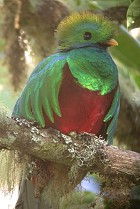
Guatemala
Guatemala is a country in Central America bordered by Mexico to the north and west, the Pacific Ocean to the southwest, Belize to the northeast, the Caribbean to the east, and Honduras and El Salvador to the southeast...
includes a total of 732 species, of which 1 is endemic
Endemism in birds
An endemic bird area is a region of the world that contains two or more restricted-range species, while a "secondary area" contains one or more restricted-range species. Both terms were devised by Birdlife International....
, 2 have been introduced
Introduced species
An introduced species — or neozoon, alien, exotic, non-indigenous, or non-native species, or simply an introduction, is a species living outside its indigenous or native distributional range, and has arrived in an ecosystem or plant community by human activity, either deliberate or accidental...
by humans, and 23 are rare or accidental. 9 species are globally threatened.
This list's taxonomic
Taxonomy
Taxonomy is the science of identifying and naming species, and arranging them into a classification. The field of taxonomy, sometimes referred to as "biological taxonomy", revolves around the description and use of taxonomic units, known as taxa...
treatment (designation and sequence of orders, families, and species) and nomenclature (common and scientific names) follow the conventions of Clements
James Clements
Dr. James Franklin Clements was an ornithologist, author and very successful businessman. He was born in New York....
's 6th edition (2010 update). The family accounts at the beginning of each heading reflects this taxonomy, as do the species counts found in each family account. Introduced and accidental species are included in the total counts for Guatemala.
The following tags have been used to highlight certain relevant categories. The commonly occurring, native, species do not fall into any of these categories.
- (A) Accidental A species that rarely or accidentally occurs in Guatemala.
- (E) Endemic A species endemic to Guatemala.
- (I) Introduced A species introduced to Guatemala as a consequence, direct or indirect, of human actions.
| Table of contents |
|---|
Non-passerines: Tinamous . Grebes . Shearwaters and Petrels . Storm-Petrels . Tropicbirds . Pelicans . Boobies and Gannets . Cormorants . Darters . Frigatebirds . Bitterns, Herons and Egrets . Storks . Ibises and Spoonbills . Ducks, Geese and Swans . New World vultures . Osprey . Hawks, Kites and Eagles . Caracaras and Falcons . Guans, Chachalacas and allies . Turkeys . New World quails . Limpkins . Rails, Crakes, Gallinules, and Coots . Sungrebe and Finfoots . Sunbittern . Jacanas . Oystercatchers . Avocets and Stilts . Thick-knees . Plovers and Lapwings . Sandpipers and allies . Skuas and Jaegers . Gulls . Terns . Skimmers . Pigeons and Doves . Parrots, Macaws and allies . Cuckoos and Anis . Barn owls . Typical owls . Potoos . Nightjars . Swifts . Hummingbirds . Trogons and Quetzals . Kingfishers . Motmots . Jacamars . Puffbirds . Toucans . Woodpeckers and allies . |
Passerines: Ovenbirds . Woodcreepers . Typical antbirds . Antthrushes and Antpittas . Cotingas . Manakins . Tyrant flycatchers . Swallows and Martins . Wagtails and Pipits . Kinglets . Silky-flycatchers . Waxwings . Dippers . Wrens . Mockingbirds and Thrashers . Thrushes and allies . Gnatcatchers . Long-tailed tits . Treecreepers . Crows, Jays, Ravens and Magpies . Vireos . Olive Warbler . New World warblers . Bananaquit . Tanagers . Buntings, Sparrows, Seedeaters and allies . Saltators, Cardinals and allies . Troupials and allies . Siskins, Crossbills and allies . Sparrows . |
See also References |
Tinamous
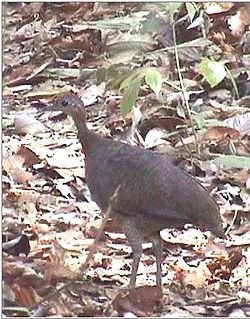
The tinamous are one of the most ancient groups of bird. Although they look similar to other ground-dwelling birds like quail and grouse, they have no close relatives and are classified as a single family Tinamidae within their own order, the Tinamiformes. They are distantly related to the ratites (order Struthioniformes), that includes the rhea
Rhea (bird)
The rheas are ratites in the genus Rhea, native to South America. There are two existing species: the Greater or American Rhea and the Lesser or Darwin's Rhea. The genus name was given in 1752 by Paul Möhring and adopted as the English common name. Möhring's reason for choosing this name, from the...
s, emu
Emu
The Emu Dromaius novaehollandiae) is the largest bird native to Australia and the only extant member of the genus Dromaius. It is the second-largest extant bird in the world by height, after its ratite relative, the ostrich. There are three subspecies of Emus in Australia...
, and kiwi
Kiwi
Kiwi are flightless birds endemic to New Zealand, in the genus Apteryx and family Apterygidae.At around the size of a domestic chicken, kiwi are by far the smallest living ratites and lay the largest egg in relation to their body size of any species of bird in the world...
. There are 47 species worldwide and 4 species which occur in Guatemala.
- Great TinamouGreat TinamouThe Great Tinamou Tinamus major, also called Mountain hen is a species of tinamou ground bird native to Central and South America. There are several subspecies, mostly differentiated by their coloration:-Description:...
Tinamus major - Little TinamouLittle TinamouThe Little Tinamou, Crypturellus soui, is found in Central America and South America.-Etymology:Crypturellus is formed from three Latin or Greek words. kruptos meaning covered or hidden, oura meaning tail, and ellus meaning diminutive...
Crypturellus soui - Slaty-breasted TinamouSlaty-breasted TinamouThe Slaty-breasted Tinamou or Boucard's Tinamou, Crypturellus boucardi, is a type of Tinamou commonly found in lowland moist forests of Central America...
Crypturellus boucardi - Thicket TinamouThicket TinamouThe Thicket Tinamou or Rufescent Tinamou, Crypturellus cinnamomeus, is a type of Tinamou commonly found in moist forests in subtropical and tropical Central Mexico...
Crypturellus cinnamomeus
Ducks, geese and swans
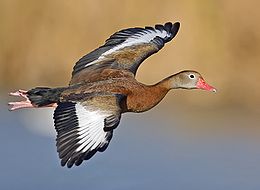
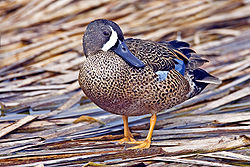
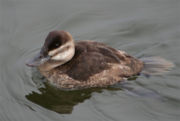
Anseriformes
The order Anseriformes contains about 150 living species of birds in three extant families: the Anhimidae , Anseranatidae , and the Anatidae, which includes over 140 species of waterfowl, among them the ducks, geese, and swans.All species in the order are highly adapted for an aquatic existence at...
. Family: Anatidae
Anatidae
Anatidae is the biological family of birds that includes ducks, geese and swans. The family has a cosmopolitan distribution, occurring on all the world's continents except Antarctica and on most of the world's islands and island groups...
The family Anatidae includes the duck
Duck
Duck is the common name for a large number of species in the Anatidae family of birds, which also includes swans and geese. The ducks are divided among several subfamilies in the Anatidae family; they do not represent a monophyletic group but a form taxon, since swans and geese are not considered...
s and most duck-like waterfowl, such as geese
Goose
The word goose is the English name for a group of waterfowl, belonging to the family Anatidae. This family also includes swans, most of which are larger than true geese, and ducks, which are smaller....
and swan
Swan
Swans, genus Cygnus, are birds of the family Anatidae, which also includes geese and ducks. Swans are grouped with the closely related geese in the subfamily Anserinae where they form the tribe Cygnini. Sometimes, they are considered a distinct subfamily, Cygninae...
s. These are birds that are modified for an aquatic existence with webbed feet, flattened bills and feathers that are excellent at shedding water due to an oily coating. There are 131 species worldwide and 16 species which occur in Guatemala.
- Black-bellied Whistling-Duck Dendrocygna autumnalis
- Fulvous Whistling-Duck Dendrocygna bicolor (A)
- Muscovy DuckMuscovy DuckThe Muscovy Duck is a large duck which is native to Mexico and Central and South America. A small wild population reaches into the United States in the lower Rio Grande Valley of Texas...
Cairina moschata - American WigeonAmerican WigeonThe American Wigeon, also American Widgeon or Baldpate, is a species of wigeon in the dabbling duck genus Anas. If this is split up, all wigeons will go into their old genus Mareca again...
Anas americana - MallardMallardThe Mallard , or Wild Duck , is a dabbling duck which breeds throughout the temperate and subtropical Americas, Europe, Asia, and North Africa, and has been introduced to New Zealand and Australia....
Anas platyrhynchos (A) - Blue-winged TealBlue-winged TealThe Blue-winged Teal is a small dabbling duck from North America.-Description:The Blue-winged Teal is long, with a wingspan of , and a weight of . The adult male has a greyish blue head with a white facial crescent, a light brown body with a white patch near the rear and a black tail. The adult...
Anas discors - Cinnamon TealCinnamon TealThe Cinnamon Teal is a small, reddish dabbling duck found in marshes and ponds of western North and South America.thumb|left|Female Anas cyanoptera septentrionalium...
Anas cyanoptera - Northern ShovelerNorthern ShovelerThe Northern Shoveler , Northern Shoveller in British English, sometimes known simply as the Shoveler, is a common and widespread duck. It breeds in northern areas of Europe and Asia and across most of North America, and is a rare vagrant to Australia...
Anas clypeata - Northern PintailNorthern PintailThe Pintail or Northern Pintail is a widely occurring duck which breeds in the northern areas of Europe, Asia and North America. It is strongly migratory and winters south of its breeding range to the equator...
Anas acuta - Green-winged TealGreen-winged TealThe Green-winged Teal is a common and widespread duck that breeds in the northern areas of North America except on the Aleutian Islands. It was considered conspecific with the Common Teal The Green-winged Teal (Anas carolinensis) is a common and widespread duck that breeds in the northern areas of...
Anas crecca - CanvasbackCanvasbackThe Canvasback is the largest of the North American diving ducks, that ranges from between long and weighs approximately , with a wingspan of . The canvasback has a distinctive wedge-shaped head and long graceful neck. The adult male has a black bill, a chestnut red head and neck, a black...
Aythya valisineria (A) - RedheadRedheadRedhead may refer to:* A person with red hair* Redhead , an album by Bleu* Redhead , a North American duck, Aythya americana...
Aythya americana - Ring-necked DuckRing-necked DuckThe Ring-necked Duck is a smaller diving duck from North America.The adult male is similar in color pattern to the Eurasian Tufted Duck, its relative. It has a grey bill with a white band, a shiny purple head, a white breast, yellow eyes and a dark grey back...
Aythya collaris - Lesser ScaupLesser ScaupThe Lesser Scaup is a small North American diving duck that migrates south as far as Central America in winter. It is colloquially known as the Little Bluebill or Broadbill because of its distinctive blue bill...
Aythya affinis - Masked DuckMasked DuckThe Masked Duck is a tiny stiff-tailed duck ranging through the tropical Americas. They are found from Mexico to South America and also in the Caribbean...
Nomonyx dominicus - Ruddy DuckRuddy DuckThe Ruddy Duck is a small stiff-tailed duck.Their breeding habitat is marshy lakes and ponds throughout much of North America, and in South America in the Andes. They nest in dense marsh vegetation near water. The female builds her nest out of grass, locating it in tall vegetation to hide it from...
Oxyura jamaicensis
Guans, Chachalacas and allies
_-_female.jpg)
Galliformes
Galliformes are an order of heavy-bodied ground-feeding domestic or game bird, containing turkey, grouse, chicken, New and Old World Quail, ptarmigan, partridge, pheasant, and the Cracidae. Common names are gamefowl or gamebirds, landfowl, gallinaceous birds or galliforms...
. Family: Cracidae
Cracidae
The chachalacas, guans and curassows are birds in the family Cracidae.These are species of tropical and subtropical Central and South America. One species, the Plain Chachalaca, just reaches southernmost Texas in the USA...
The Cracidae are large birds, similar in general appearance to turkeys. The guans and curassows live in trees, but the smaller chachalacas are found in more open scrubby habitats. They are generally dull-plumaged, but the curassows and some guans have colourful facial ornaments. There are 50 species worldwide and 6 species which occur in Guatemala.
- Plain ChachalacaPlain ChachalacaThe Plain Chachalaca, Ortalis vetula, is a large bird in the Cracidae family. It breeds in tropical and subtropical environments from mezquital thickets in the Rio Grande Valley in southernmost Texas, United States to northernmost Costa Rica....
Ortalis vetula - White-bellied ChachalacaWhite-bellied ChachalacaThe White-bellied Chachalaca is a species of bird in the Cracidae family.It is found in Costa Rica, El Salvador, Guatemala, Honduras, Mexico, and Nicaragua....
Ortalis leucogastra - Crested GuanCrested GuanThe Crested Guan, Penelope purpurascens, is a member of an ancient group of birds of the Cracidae family, which are related to the Australasian mound builders. It breeds in lowlands from south Mexico and the Yucatán Peninsula to western Ecuador and southern Venezuela at up to 1850 m altitude.The...
Penelope purpurascens - Highland GuanHighland GuanThe Highland Guan is a species of bird in the Cracidae family. It is found in the highlands of El Salvador, Guatemala, Honduras, southern Mexico, and Nicaragua.Its natural habitat is subtropical or tropical moist montane forest...
Penelopina nigra Vulnerable - Horned GuanHorned GuanThe Horned Guan, Oreophasis derbianus is a large, approximately 85 cm long, turkey-like bird with glossed black upperparts plumage, red legs, white iris, yellow bill and a red horn on top of head. The breast and upper belly are white, and its long tail feathers are black with white band near...
Oreophasis derbianus Endangered - Great CurassowGreat CurassowThe Great Curassow is a large, pheasant-like bird from the Neotropics. At in length and in weight, this is a very large cracid. No other cracid match its maximum weight, but its length is matched by a few other cracids....
Crax rubra Near-threatened
New World quails

Galliformes
Galliformes are an order of heavy-bodied ground-feeding domestic or game bird, containing turkey, grouse, chicken, New and Old World Quail, ptarmigan, partridge, pheasant, and the Cracidae. Common names are gamefowl or gamebirds, landfowl, gallinaceous birds or galliforms...
. Family: Odontophoridae
The New World quail
New World quail
The New World quails or Odontophorids are small birds only distantly related to the Old World Quails, but named for their similar appearance and habits. The American species are in their own family Odontophoridae, whereas Old World Quail are in the pheasant family Phasianidae...
s are small, plump terrestrial birds only distantly related to the quails of the Old World, but named for their similar appearance and habits. There are 32 species worldwide, all found only in the Americas, and 7 species which occur in Guatemala.
- Buffy-crowned Wood-PartridgeBuffy-crowned Wood-partridgeThe Buffy-crowned Wood Partridge is a species of bird in the Odontophoridae family.It is found in Costa Rica, El Salvador, Guatemala, Honduras, Mexico, and Nicaragua....
Dendrortyx leucophrys - Northern Bobwhite Colinus virginianus Near-threatened
- Black-throated BobwhiteBlack-throated BobwhiteThe Yucatan Bobwhite or Black-throated Bobwhite is a species of bird in the Odontophoridae family.It is found in Belize, Guatemala, Honduras, Mexico, and Nicaragua....
Colinus nigrogularis - Crested BobwhiteCrested BobwhiteThe Crested Bobwhite is a species of bird in the Odontophoridae family.It is found in northern South America, extending through Panama to just reach Costa Rica...
Colinus cristatus - Spotted Wood-QuailSpotted Wood-QuailThe Spotted Wood Quail, Odontophorus guttatus, is a small ground-dwelling bird in the New World quail family. It is a resident breeder in the mountains of Central America from southern Mexico to western Panama....
Odontophorus guttatus - Singing QuailSinging QuailThe Singing Quail is a species of bird in the Odontophoridae family.It is found in Belize, El Salvador, Guatemala, Honduras, and Mexico....
Dactylortyx thoracicus - Ocellated QuailOcellated QuailThe Ocellated Quail is a species of bird in the Odontophoridae family.It is found in El Salvador, Guatemala, Honduras, Mexico, and Nicaragua....
Cyrtonyx ocellatus Near-threatened
Turkeys
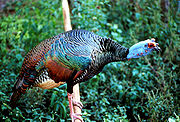
Galliformes
Galliformes are an order of heavy-bodied ground-feeding domestic or game bird, containing turkey, grouse, chicken, New and Old World Quail, ptarmigan, partridge, pheasant, and the Cracidae. Common names are gamefowl or gamebirds, landfowl, gallinaceous birds or galliforms...
. Family: Phasianidae
Phasianidae
The Phasianidae is a family of birds which consists of the pheasants and partridges, including the junglefowl , Old World Quail, francolins, monals and peafowl. The family is a large one, and is occasionally broken up into two subfamilies, the Phasianinae, and the Perdicinae...
Turkeys are similar to large pheasants but have a distinctive fleshy wattle that hangs from the beak, called a snood. There are two species, both native to the Americas, and1 species which occurs in Guatemala.
- Ocellated TurkeyOcellated TurkeyThe Ocellated Turkey is a species of turkey residing primarily in the Yucatán Peninsula. A relative of the more common Wild Turkey , it was sometimes previously treated in a genus of its own but the differences between this species and Meleagris gallopavo are too small to justify generic...
Meleagris ocellata Near-threatened
Grebes
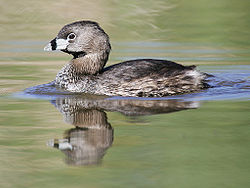
Grebe
Grebe
A grebe is a member of the Podicipediformes order, a widely distributed order of freshwater diving birds, some of which visit the sea when migrating and in winter...
s are small to medium-large sized freshwater diving birds. They have lobed toes, and are excellent swimmers and divers. However, they have their feet placed far back on the body, making them quite ungainly on land. There are 20 species worldwide and 3 species which occur in Guatemala.
- Least GrebeLeast GrebeThe Least Grebe , an aquatic bird, is the smallest member of the grebe family. It occurs in the New World from the southwestern United States and Mexico to Chile and Argentina, and also on Trinidad and Tobago, the Bahamas and the Greater Antilles.-Description:The Least Grebe ranges in length from...
Tachybaptus dominicus - Pied-billed GrebePied-billed GrebeThe Pied-billed Grebe is a species of the grebe family of water birds. Since the Atitlán Grebe, Podilymbus gigas, has become extinct, it is the sole extant member of the genus Podilymbus.-Description:...
Podilymbus podiceps - Atitlan GrebeAtitlán GrebeThe Atitlán Grebe , also known as Giant Grebe, Giant Pied-billed Grebe, or Poc, is an extinct water bird, a relative of the Pied-billed Grebe. It was endemic at the Lago de Atitlán in Guatemala at an altitude of 1700 m asl. Thanks to the field work of the American ecologist Anne LaBastille, its...
Podilymbus gigas (E) Extinct - Eared Grebe Podiceps nigricollis
Shearwaters and petrels

Procellariiformes
Procellariiformes is an order of seabirds that comprises four families: the albatrosses, petrels and shearwaters, storm petrels, and diving petrels...
. Family: Procellariidae
Procellariidae
The family Procellariidae is a group of seabirds that comprises the fulmarine petrels, the gadfly petrels, the prions, and the shearwaters. This family is part of the bird order Procellariiformes , which also includes the albatrosses, the storm-petrels, and the diving petrels.The procellariids are...
The procellariids are the main group of medium-sized 'true petrels', characterised by united nostrils with a medium septum, and a long outer functional primary. There are 75 species worldwide and 6 species which occur in Guatemala.
- Parkinson's PetrelParkinson's PetrelBlack Petrel , also called the Parkinson's Petrel, is a large, black petrel, the smallest of the Procellaria. The species is an endemic breeder of New Zealand, breeding only on islands off the North Island, on Great Barrier Island and Little Barrier Island. At sea it disperses as far as Australia...
Procellaria parkinsoni Vulnerable - Pink-footed ShearwaterPink-footed ShearwaterThe Pink-footed Shearwater is a species of seabird. The bird is 48 cm in size, with a 109 cm wingspan. It is polymorphic, having both darker and lighter phase populations...
Puffinus creatopus Vulnerable - Wedge-tailed ShearwaterWedge-tailed ShearwaterThe Wedge-tailed Shearwater, Puffinus pacificus is a medium-large shearwater in the seabird family Procellariidae. It is one of the shearwater species that is sometimes referred to as a Muttonbird, like the Sooty Shearwater of New Zealand and the Short-tailed Shearwater of Australia...
Puffinus pacificus - Sooty ShearwaterSooty ShearwaterThe Sooty Shearwater is a medium-large shearwater in the seabird family Procellariidae. In New Zealand it is also known by its Māori name tītī and as "muttonbird", like its relatives the Wedge-tailed Shearwater and the Australian Short-tailed Shearwater The Sooty Shearwater (Puffinus griseus) is...
Puffinus griseus Near-threatened - Christmas ShearwaterChristmas ShearwaterThe Christmas Shearwater, Puffinus nativitatis, is a medium-sized shearwater of the tropical Central Pacific. It is a poorly known species due to its remote nesting habits, and it has not been extensively studied at sea either....
Puffinus nativitatis - Audubon's ShearwaterAudubon's ShearwaterAudubon's Shearwater, Puffinus lherminieri, is a common tropical seabird from the family Procellariidae. Sometimes called Dusky-backed Shearwater, the scientific name of this species commemorates the French naturalist Félix Louis L'Herminier....
Puffinus lherminieri
Storm-Petrels
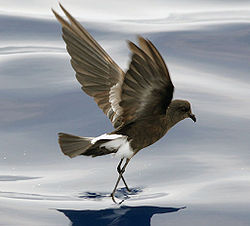
Procellariiformes
Procellariiformes is an order of seabirds that comprises four families: the albatrosses, petrels and shearwaters, storm petrels, and diving petrels...
. Family: Hydrobatidae
The storm-petrel
Storm-petrel
Storm petrels are seabirds in the family Hydrobatidae, part of the order Procellariiformes. These smallest of seabirds feed on planktonic crustaceans and small fish picked from the surface, typically while hovering. The flight is fluttering and sometimes bat-like.Storm petrels have a cosmopolitan...
s are relatives of the petrel
Petrel
Petrels are tube-nosed seabirds in the bird order Procellariiformes. The common name does not indicate relationship beyond that point, as "petrels" occur in three of the four families within that group...
s, and are the smallest of seabirds. They feed on plankton
Plankton
Plankton are any drifting organisms that inhabit the pelagic zone of oceans, seas, or bodies of fresh water. That is, plankton are defined by their ecological niche rather than phylogenetic or taxonomic classification...
ic crustaceans and small fish picked from the surface, typically while hovering. The flight is fluttering and sometimes bat
Bat
Bats are mammals of the order Chiroptera "hand" and pteron "wing") whose forelimbs form webbed wings, making them the only mammals naturally capable of true and sustained flight. By contrast, other mammals said to fly, such as flying squirrels, gliding possums, and colugos, glide rather than fly,...
-like. There are 21 species worldwide and 6 species which occur in Guatemala.
- Wilson's Storm-PetrelWilson's Storm-petrelWilson's Storm Petrel , also known as Wilson's Petrel, is a small seabird of the storm-petrel family. It is one of the most abundant bird species in the world and has a circumpolar distribution mainly in the seas of the southern hemisphere but extending northwards during the summer of the northern...
Oceanites oceanicus (A) - Leach's Storm-PetrelLeach's Storm-petrelThe Leach's Storm Petrel or Leach's Petrel is a small seabird of the tubenose family. It is named after the British zoologist William Elford Leach....
Oceanodroma leucorhoa - Wedge-rumped Storm-PetrelWedge-rumped Storm-petrelThe Wedge-rumped Storm Petrel is a storm-petrel. It breeds in the Galápagos Islands and on the coast of Peru.-External links:*...
Oceanodroma tethys - Black Storm-PetrelBlack Storm-petrelThe Black Storm Petrel is a small seabird of the storm-petrel family Hydrobatidae. It is 23 cm in length, with a wingspan of 46–51 cm....
Oceanodroma melania - Markham's Storm-PetrelMarkham's Storm-petrelThe Markham's Storm Petrel is a species of seabird in the Hydrobatidae family.It is found in Chile, Colombia, Ecuador, French Polynesia, Peru, and possibly Costa Rica....
Oceanodroma markhami (A) Data deficient - Least Storm-PetrelLeast Storm-petrelThe Least Storm Petrel is a small seabird of the storm-petrel family Hydrobatidae. It is 13–15 cm in length, with a wingspan of 32 cm. It is the smallest member of the order Procellariiformes...
Oceanodroma microsoma
Tropicbirds
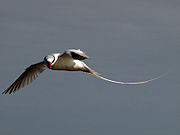
Tropicbird
Tropicbird
Tropicbirds are a family, Phaethontidae, of tropical pelagic seabirds now classified in their own order Phaethontiformes. Their relationship to other living birds is unclear, and they appear to have no close relatives. There are three species in one genus, Phaethon...
s are slender white birds of tropical oceans, with exceptionally long central tail feathers. Their heads and long wings have black markings. There are 3 species worldwide and 2 species which occur in Guatemala.
- White-tailed TropicbirdWhite-tailed TropicbirdThe White-tailed Tropicbird Phaethon lepturus, is a tropicbird, smallest of three closely related seabirds of the tropical oceans and smallest member of the order Phaethontiformes. It occurs in the tropical Atlantic, western Pacific and Indian Oceans...
Phaethon lepturus (A) - Red-billed TropicbirdRed-billed TropicbirdThe Red-billed Tropicbird, Phaethon aethereus, also known as the Boatswain Bird is a tropicbird, one of three closely related seabirds of tropical oceans.-Distribution and habitat:...
Phaethon aethereus
Storks
Order: CiconiiformesCiconiiformes
Traditionally, the order Ciconiiformes has included a variety of large, long-legged wading birds with large bills: storks, herons, egrets, ibises, spoonbills, and several others. Ciconiiformes are known from the Late Eocene...
. Family: Ciconiidae
Storks are large, long-legged, long-necked, wading birds with long, stout bills. Storks are mute; bill-clattering is an important mode of stork communication at the nest. Their nests can be large and may be reused for many years. Many species are migratory. There are 19 species worldwide and 2 species which occur in Guatemala.
- JabiruJabiruThe Jabiru is a large stork found in the Americas from Mexico to Argentina, except west of the Andes. It is most common in the Pantanal region of Brazil and the Eastern Chaco region of Paraguay. It is the only member of the genus Jabiru...
Jabiru mycteria - Wood StorkWood StorkThe Wood Stork is a large American wading bird in the stork family Ciconiidae. It was formerly called the "Wood Ibis", though it is not really an ibis.-Appearance:...
Mycteria americana
Frigatebirds
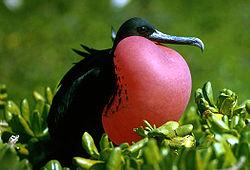
Suliformes
The Order Suliformes is a proposed order by the International Ornithologist's Union...
. Family: Fregatidae
Frigatebird
Frigatebird
The frigatebirds are a family, Fregatidae, of seabirds. There are five species in the single genus Fregata. They are also sometimes called Man of War birds or Pirate birds. Since they are related to the pelicans, the term "frigate pelican" is also a name applied to them...
s are large seabirds usually found over tropical oceans. They are large, black and white or completely black, with long wings and deeply-forked tails. The males have inflatable coloured throat pouches. They do not swim or walk, and cannot take off from a flat surface. Having the largest wingspan to body weight ratio of any bird, they are essentially aerial, able to stay aloft for more than a week. There are 5 species worldwide and 1 species which occurs in Guatemala.
- Magnificent FrigatebirdMagnificent FrigatebirdThe Magnificent Frigatebird was sometimes previously known as Man O'War, reflecting its rakish lines, speed, and aerial piracy of other birds....
Fregata magnificens
Boobies and gannets
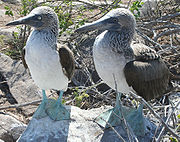
Suliformes
The Order Suliformes is a proposed order by the International Ornithologist's Union...
. Family: Sulidae
Sulidae
The bird family Sulidae comprises the gannets and boobies. Collectively called sulidas, they are medium-large coastal seabirds that plunge-dive for fish and similar prey. The ten species in this family are often considered congeneric in older sources, placing all in the genus Sula...
The sulids comprise the gannet
Gannet
Gannets are seabirds comprising the genus Morus, in the family Sulidae, closely related to the boobies.The gannets are large black and white birds with yellow heads. They have long pointed wings and long bills. Northern gannets are the largest seabirds in the North Atlantic, with a wingspan of up...
s and boobies
Booby
A booby is a seabird in the genus Sula, part of the Sulidae family. Boobies are closely related to the gannets , which were formerly included in Sula.-Description:...
. Both groups comprise medium-to-large coastal seabirds that plunge-dive for fish. There are 9 species worldwide and 4 species which occur in Guatemala.
- Masked BoobyMasked BoobyThe Masked Booby, Sula dactylatra, is a large seabird of the booby family, Sulidae. This species breeds on islands in tropical oceans, except in the eastern Atlantic; in the eastern Pacific it is replaced by the Nazca Booby, Sula granti, which was formerly regarded as a subspecies of Masked Booby...
Sula dactylatra - Blue-footed BoobyBlue-footed BoobyThe Blue-footed Booby is a bird in the Sulidae family which comprises ten species of long-winged seabirds. The natural breeding habitat of the Blue-footed Booby is tropical and subtropical islands off the Pacific Ocean, most famously, the Galápagos Islands, Ecuador.- Etymology :The name booby...
Sula nebouxii - Brown BoobyBrown BoobyThe Brown Booby is a large seabird of the booby family, Sulidae. The adult brown booby reaches about in length. Its head and upper body are covered in dark brown, with the remainder being a contrasting white. The juvenile form is gray-brown with darkening on the head, wings and tail...
Sula leucogaster - Red-footed BoobyRed-footed BoobyThe Red-footed Booby, Sula sula, is a large seabird of the booby family, Sulidae. As suggested by the name, adults always have red feet, but the colour of the plumage varies. They are powerful and agile fliers, but they are clumsy in takeoffs and landings...
Sula sula
Cormorants
Order: SuliformesSuliformes
The Order Suliformes is a proposed order by the International Ornithologist's Union...
. Family: Phalacrocoracidae
The Phalacrocoracidae is a family of medium-to-large coastal, fish-eating seabirds that includes cormorants and shags. Plumage colouration varies with the majority having mainly dark plumage, some species being black and white, and a few being colourful. There are 38 species worldwide and 2 species which occur in Guatemala.
- Neotropic CormorantNeotropic CormorantThe Neotropic Cormorant or Olivaceous Cormorant is a medium-sized cormorant found throughout the American tropics and subtropics, from the middle Rio Grande and the Gulf and Californian coasts of the USA south through Mexico and Central America to southern South America. It also breeds on the...
Phalacrocorax brasilianus - Double-crested CormorantDouble-crested CormorantThe Double-crested Cormorant is a member of the cormorant family of seabirds. It occurs along inland waterways as well as in coastal areas, and is widely distributed across North America, from the Aleutian Islands in Alaska down to Florida and Mexico...
Phalacrocorax auritus
Darters
Order: SuliformesSuliformes
The Order Suliformes is a proposed order by the International Ornithologist's Union...
. Family: Anhingidae
Darters are frequently referred to as "snake-birds" because of their long thin neck, which gives a snake-like appearance when they swim with their bodies submerged.
The males have black and dark brown plumage, an erectile crest on the nape and a larger bill than the female. The females have a much paler plumage especially on the neck and underparts. The darters have completely webbed feet, and their legs are short and set far back on the body. Their plumage is somewhat permeable, like that of cormorants, and they spread their wings to dry after diving. There are 4 species worldwide and 1 species which occurs in Guatemala.
- AnhingaAnhingaThe Anhinga , sometimes called Snakebird, Darter, American Darter, or Water Turkey, is a water bird of the warmer parts of the Americas. The word "anhinga" comes from the Brazilian Tupi language and means devil bird or snake bird.It is a cormorant-like bird with an average body length of , a...
Anhinga anhinga
Pelicans
Order: PelecaniformesPelecaniformes
The Pelecaniformes is a order of medium-sized and large waterbirds found worldwide. As traditionally—but erroneously—defined, they encompass all birds that have feet with all four toes webbed. Hence, they were formerly also known by such names as totipalmates or steganopodes...
. Family: Pelecanidae
Pelican
Pelican
A pelican, derived from the Greek word πελεκυς pelekys is a large water bird with a large throat pouch, belonging to the bird family Pelecanidae....
s are large water birds with a distinctive pouch under the beak. As with other members of the order Pelecaniformes, they have webbed feet with four toes. There are 8 species worldwide and 2 species which occur in Guatemala.
- American White PelicanAmerican White PelicanThe American White Pelican is a large aquatic bird from the order Pelecaniformes. It breeds in interior North America, moving south and to the coasts, as far as Central America, in winter....
Pelecanus erythrorhynchos - Brown PelicanBrown PelicanThe Brown Pelican is the smallest of the eight species of pelican, although it is a large bird in nearly every other regard. It is in length, weighs from and has a wingspan from .-Range and habits:...
Pelecanus occidentalis
Bitterns, herons and egrets
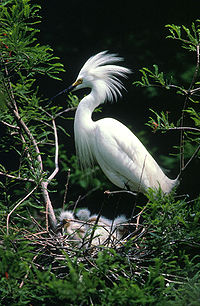
Pelecaniformes
The Pelecaniformes is a order of medium-sized and large waterbirds found worldwide. As traditionally—but erroneously—defined, they encompass all birds that have feet with all four toes webbed. Hence, they were formerly also known by such names as totipalmates or steganopodes...
. Family: Ardeidae
The family Ardeidae contains the bittern
Bittern
Bitterns are a classification of birds in the heron family, Ardeidae, a family of wading birds. Species named bitterns tend to be the shorter-necked, often more secretive members of this family...
s, heron
Heron
The herons are long-legged freshwater and coastal birds in the family Ardeidae. There are 64 recognised species in this family. Some are called "egrets" or "bitterns" instead of "heron"....
s and egret
Egret
An egret is any of several herons, most of which are white or buff, and several of which develop fine plumes during the breeding season. Many egrets are members of the genera Egretta or Ardea which contain other species named as herons rather than egrets...
s. Herons and egrets are medium to large sized wading birds with long necks and legs. Bitterns tend to be shorter necked and more wary. Unlike other long-necked birds such as storks, ibises and spoonbills, members of Ardeidae fly with their necks retracted. There are 61 species worldwide and 16 species which occur in Guatemala.
- Pinnated Bittern Botaurus pinnatus
- American BitternAmerican BitternThe American Bittern is a wading bird of the heron family Ardeidae. New evidence has led the American Ornithologists' Union to move the heron family into the order Pelecaniformes .-Description:...
Botaurus lentiginosus (A) - Least BitternLeast BitternThe Least Bittern is a small wading bird, the smallest heron found in the Americas.This bird's underparts and throat are white with light brown streaks. Their face and the sides of the neck are light brown; they have yellow eyes and a yellow bill. The adult male is glossy greenish black on the...
Ixobrychus exilis - Bare-throated Tiger-Heron Tigrisoma mexicanum
- Great Blue HeronGreat Blue HeronThe Great Blue Heron is a large wading bird in the heron family Ardeidae, common near the shores of open water and in wetlands over most of North and Central America as well as the West Indies and the Galápagos Islands. It is a rare vagrant to Europe, with records from Spain, the Azores and England...
Ardea herodias - Great EgretGreat EgretThe Great Egret , also known as the Great White Egret or Common Egret, White Heron, or Great White Heron, is a large, widely-distributed egret. Distributed across most of the tropical and warmer temperate regions of the world, in southern Europe it is rather localized...
Ardea alba - Snowy EgretSnowy EgretThe Snowy Egret is a small white heron. It is the American counterpart to the very similar Old World Little Egret, which has established a foothold in the Bahamas....
Egretta thula - Little Blue HeronLittle Blue HeronThe Little Blue Heron, Egretta caerulea, is a small heron. It breeds from the Gulf states of the USA through Central America and the Caribbean south to Peru and Uruguay. It is a resident breeder in most of its range, but some northern breeders migrate to the southeastern USA or beyond in winter...
Egretta caerulea - Tricolored HeronTricolored HeronThe Tricolored Heron formerly known in North America as the Louisiana Heron, is a small heron. It is a resident breeder from the Gulf states of the USA and northern Mexico south through Central America and the Caribbean to central Brazil and Peru...
Egretta tricolor - Reddish EgretReddish EgretThe Reddish Egret is a small heron. It is a resident breeder in Central America, The Bahamas, the Caribbean, the Gulf Coast of the United States, and Mexico. There is post-breeding dispersal to well north of the nesting range...
Egretta rufescens - Cattle EgretCattle EgretThe Cattle Egret is a cosmopolitan species of heron found in the tropics, subtropics and warm temperate zones. It is the only member of the monotypic genus Bubulcus, although some authorities regard its two subspecies as full species, the Western Cattle Egret and the Eastern Cattle Egret...
Bubulcus ibis - Green HeronGreen HeronThe Green Heron is a small heron of North and Central America. It was long considered conspecific with its sister species the Striated Heron , and together they were called "Green-backed Heron"...
Butorides virescens - Agami HeronAgami HeronThe Agami Heron is a medium-sized heron. It is a resident breeding bird from Central America south to Peru and Brazil.It is sometimes known as the Chestnut-bellied Heron, and is the only member of the genus Agamia .The Agami Heron's habitat is forest swamps and similar wooded wetlands...
Agamia agami - Black-crowned Night-Heron Nycticorax nycticorax
- Yellow-crowned Night-Heron Nyctanassa violacea
- Boat-billed HeronBoat-billed HeronThe Boat-billed Heron - colloquially known as the Boatbill - is an atypical member of the heron family, and was formerly thought to be in a monotypic family, Cochlearidae....
Cochlearius cochlearius
Ibises and spoonbills

Pelecaniformes
The Pelecaniformes is a order of medium-sized and large waterbirds found worldwide. As traditionally—but erroneously—defined, they encompass all birds that have feet with all four toes webbed. Hence, they were formerly also known by such names as totipalmates or steganopodes...
. Family: Threskiornithidae
Threskiornithidae
The family Threskiornithidae includes 34 species of large terrestrial and wading birds, falling into two subfamilies, the ibises and the spoonbills. It was formerly known as Plataleidae. The spoonbills and ibises were once thought to be related to other groups of long-legged wading birds in the...
The Threskiornithidae is a family of large terrestrial and wading birds which includes the ibis
Ibis
The ibises are a group of long-legged wading birds in the family Threskiornithidae....
es and spoonbill
Spoonbill
Spoonbills are a group of large, long-legged wading birds in the family Threskiornithidae, which also includes the Ibises.All have large, flat, spatulate bills and feed by wading through shallow water, sweeping the partly opened bill from side to side...
s. They have long, broad wings with 11 primary and about 20 secondary feathers. They are strong fliers and despite their size and weight, very capable soarers. There are 36 species worldwide and 3 species which occur in Guatemala.
- American White IbisAmerican White IbisThe American White Ibis is a species of wading bird in the ibis family Threskiornithidae. It occurs from the mid-Atlantic and Gulf coast of the United States south through most of the New World tropics...
Eudocimus albus - White-faced IbisWhite-faced IbisThe White-faced Ibis is a wading bird in the ibis family Threskiornithidae.This species breeds colonially in marshes, usually nesting in bushes or low trees. Its breeding range extends from the western USA south through Mexico, as well as from southeastern Brazil and southeastern Bolivia south to...
Plegadis chihi - Roseate SpoonbillRoseate SpoonbillThe Roseate Spoonbill, Platalea ajaja, is a gregarious wading bird of the ibis and spoonbill family, Threskiornithidae...
Platalea ajaja
New World vultures
Order: AccipitriformesAccipitriformes
The Accipitriformes is an order that has been proposed to include most of the diurnal birds of prey: hawks, eagles, vultures, and many others, about 225 species in all. For a long time, the majority view has been to include them with the falcons in the Falconiformes, but some authorities have...
. Family: Cathartidae
The New World vultures are not closely related to Old World vultures, but superficially resemble them because of convergent evolution
Convergent evolution
Convergent evolution describes the acquisition of the same biological trait in unrelated lineages.The wing is a classic example of convergent evolution in action. Although their last common ancestor did not have wings, both birds and bats do, and are capable of powered flight. The wings are...
. Like the Old World vultures, they are scavengers. However, unlike Old World vultures, which find carcasses by sight, New World vultures have a good sense of smell with which they locate carrion
Carrion
Carrion refers to the carcass of a dead animal. Carrion is an important food source for large carnivores and omnivores in most ecosystems. Examples of carrion-eaters include vultures, hawks, eagles, hyenas, Virginia Opossum, Tasmanian Devils, coyotes, Komodo dragons, and burying beetles...
. There are 7 species worldwide, all of which are found only in the Americas, and 4 species which occur in Guatemala.
- Black VultureBlack vultureBlack vulture may refer to:* American Black Vulture* Eurasian Black Vulture...
Coragyps atratus - Turkey VultureTurkey VultureThe Turkey Vulture is a bird found throughout most of the Americas. It is also known in some North American regions as the Turkey Buzzard , and in some areas of the Caribbean as the John Crow or Carrion Crow...
Cathartes aura - Lesser Yellow-headed VultureLesser Yellow-headed VultureThe Lesser Yellow-headed Vulture, Cathartes burrovianus, also known as the Savannah Vulture, is a species of bird in the New World Vulture family Cathartidae. It was considered to be the same species as the Greater Yellow-headed Vulture until they were split in 1964...
Cathartes burrovianus - King VultureKing VultureThe King Vulture is a large bird found in Central and South America. It is a member of the New World vulture family Cathartidae. This vulture lives predominantly in tropical lowland forests stretching from southern Mexico to northern Argentina, though some believe that William Bartram's Painted...
Sarcoramphus papa
Osprey
Order: AccipitriformesAccipitriformes
The Accipitriformes is an order that has been proposed to include most of the diurnal birds of prey: hawks, eagles, vultures, and many others, about 225 species in all. For a long time, the majority view has been to include them with the falcons in the Falconiformes, but some authorities have...
. Family: Pandionidae
The Pandionidae family contains only one species, the Osprey. The Osprey is a medium large raptor
Bird of prey
Birds of prey are birds that hunt for food primarily on the wing, using their keen senses, especially vision. They are defined as birds that primarily hunt vertebrates, including other birds. Their talons and beaks tend to be relatively large, powerful and adapted for tearing and/or piercing flesh....
which is a specialist fish-eater with a worldwide distribution.
- OspreyOspreyThe Osprey , sometimes known as the sea hawk or fish eagle, is a diurnal, fish-eating bird of prey. It is a large raptor, reaching more than in length and across the wings...
Pandion haliaetus
Hawks, kites and eagles


Accipitriformes
The Accipitriformes is an order that has been proposed to include most of the diurnal birds of prey: hawks, eagles, vultures, and many others, about 225 species in all. For a long time, the majority view has been to include them with the falcons in the Falconiformes, but some authorities have...
. Family: Accipitridae
Accipitridae
The Accipitridae, one of the two major families within the order Accipitriformes , are a family of small to large birds with strongly hooked bills and variable morphology based on diet. They feed on a range of prey items from insects to medium-sized mammals, with a number feeding on carrion and a...
Accipitridae is a family of birds of prey and include hawk
Hawk
The term hawk can be used in several ways:* In strict usage in Australia and Africa, to mean any of the species in the subfamily Accipitrinae, which comprises the genera Accipiter, Micronisus, Melierax, Urotriorchis and Megatriorchis. The large and widespread Accipiter genus includes goshawks,...
s, eagle
Eagle
Eagles are members of the bird family Accipitridae, and belong to several genera which are not necessarily closely related to each other. Most of the more than 60 species occur in Eurasia and Africa. Outside this area, just two species can be found in the United States and Canada, nine more in...
s, kites
Kite (bird)
Kites are raptors with long wings and weak legs which spend a great deal of time soaring. Most feed mainly on carrion but some take various amounts of live prey.They are birds of prey which, along with hawks and eagles, are from the family Accipitridae....
, harriers
Harrier (bird)
A harrier is any of the several species of diurnal hawks forming the Circinae sub-family of the Accipitridae family of birds of prey. Harriers characteristically hunt by flying low over open ground, feeding on small mammals, reptiles, or birds....
and Old World vultures. These birds have powerful hooked beaks for tearing flesh from their prey, strong legs, powerful talons, and keen eyesight. There are 233 species worldwide and 34 species which occur in Guatemala.
- Gray-headed KiteGray-headed KiteThe Gray-headed Kite, Leptodon cayanensis, is a raptor found in open woodland and swamp forests. It shares the genus Leptodon with the extremely rare White-collared Kite. It breeds from eastern Mexico and Trinidad south to Peru, Bolivia,Brazil and northern Argentina.The nest is made of sticks lined...
Leptodon cayanensis - Hook-billed KiteHook-billed KiteThe Hook-billed Kite, Chondrohierax uncinatus, is a bird of prey in the family Accipitridae, which also includes many other diurnal raptors such as kites, eagles, and harriers...
Chondrohierax uncinatus - Swallow-tailed KiteSwallow-tailed KiteThe Swallow-tailed Kite is an elanid kite which breeds from the southeastern United States to eastern Peru and northern Argentina. Most North and Central American breeders winter in South America where the species is resident year round...
Elanoides forficatus - White-tailed KiteWhite-tailed KiteThe White-tailed Kite is an elanid kite of genus Elanus found in western North America and parts of South America.Their coloration is gull-like, but their shape and flight falcon-like, with a rounded tail...
Elanus leucurus - Snail KiteSnail KiteThe Snail Kite is a bird of prey within the family Accipitridae, which also includes the eagles, hawks, and Old World vultures. Its relative, the Slender-billed Kite, is now again placed in Helicolestes, making the genus Rostrhamus monotypic...
Rostrhamus sociabilis - Double-toothed KiteDouble-toothed KiteThe Double-toothed Kite is a species of bird of prey in the Accipitridae family. It is found in Belize, Bolivia, Brazil, Colombia, Costa Rica, Ecuador, El Salvador, French Guiana, Guatemala, Guyana, Honduras, Mexico, Nicaragua, Panama, Peru, Suriname, Trinidad and Tobago, and Venezuela.This fairly...
Harpagus bidentatus - Mississippi KiteMississippi KiteThe Mississippi Kite is a small bird of prey in the family Accipitridae. It is 12 to 15 inches beak to tail and has a wingspan averaging 3 feet . Weight is from 214 to 388 grams . Adults are gray with darker gray on their tail feathers and outer wings and lighter gray on their heads...
Ictinia mississippiensis - Plumbeous KitePlumbeous KiteThe Plumbeous Kite is a bird of prey in the family Accipitridae, which also includes the eagles, hawks and Old World vultures....
Ictinia plumbea - Black-collared HawkBlack-collared HawkThe Black-collared Hawk is a species of bird of prey in the Accipitridae family. It is monotypic within the genus Busarellus....
Busarellus nigricollis - Northern Harrier Circus cyaneus
- Sharp-shinned HawkSharp-shinned HawkThe Sharp-shinned Hawk is a small hawk. In fact, "sharp-shins" or "sharpies" are the smallest to reside in USA and Canada, though some Neotropical species are smaller...
Accipiter striatus - Cooper's HawkCooper's HawkCooper's Hawk is a medium-sized hawk native to the North American continent and found from Canada to Mexico. As in many birds of prey, the male is smaller than the female...
Accipiter cooperii - Bicolored Hawk Accipiter bicolor
- Crane HawkCrane HawkThe Crane Hawk is a species of bird of prey in the Accipitridae family. It is monotypic within the genus Geranospiza....
Geranospiza caerulescens - White HawkWhite HawkThe White Hawk , a bird of prey breeding in the tropical New World, belongs to the family Accipitridae of the Falconiformes; it is sometimes separated in the Accipitriformes with the other hawks and their relatives...
Leucopternis albicollis - Common Black-Hawk Buteogallus anthracinus
- Great Black-Hawk Buteogallus urubitinga
- Harris's HawkHarris's HawkThe Harris's Hawk or Harris Hawk formerly known as the Bay-winged Hawk or Dusky Hawk, is a medium-large bird of prey which breeds from the southwestern United States south to Chile and central Argentina...
Parabuteo unicinctus - Solitary EagleSolitary EagleThe Montane Solitary Eagle, Harpyhaliaetus solitarius, is a large Neotropical eagle.- Range and habitat :The Montane Solitary Eagle is native to Mexico and Central and South America. It is found in mountainous or hilly forests, at elevations between 600 m & 2,200 m...
Harpyhaliaetus solitarius Near-threatened - Roadside HawkRoadside HawkThe Roadside Hawk is a relatively small bird of prey found in Latin America. This vocal species is often the most common raptor in its range. It has many subspecies and is sometimes placed in the monotypic genus Rupornis instead of Buteo.-Description:The Roadside Hawk is long and weighs...
Buteo magnirostris - Broad-winged HawkBroad-winged HawkThe Broad-winged Hawk is a small hawk of the genus Buteo. During the summer some subspecies are distributed over eastern North America, as far west as British Columbia and Texas; they then migrate south to winter in the neotropics from Mexico down to southern Brazil. Other subspecies are all-year...
Buteo platypterus - Gray HawkGray HawkThe Grey Hawk or Grey-lined Hawk is a smallish raptor found in open country and forest edges. It is sometimes placed in the genus Asturina as Asturina nitida....
Buteo nitidus - Short-tailed HawkShort-tailed HawkThe Short-tailed Hawk is an American bird of prey in the family Accipitridae, which also includes the eagles and Old World vultures. As a member of the genus Buteo, it is not a true hawk and thus also referred to as a "buteo" or "buzzard". The White-throated Hawk The Short-tailed Hawk (Buteo...
Buteo brachyurus - Swainson's HawkSwainson's HawkThe Swainson's Hawk , is a large buteo hawk of the Falconiformes, sometimes separated in the Accipitriformes like its relatives. This species was named after William Swainson, a British naturalist...
Buteo swainsoni - White-tailed HawkWhite-tailed HawkThe White-tailed Hawk is a large bird of prey species found in tropical or subtropical environments across the Americas.-Description:...
Buteo albicaudatus - Zone-tailed HawkZone-tailed HawkThe Zone-tailed Hawk is a medium-sized hawk of warm, dry parts of the Americas. It feeds on small vertebrates of all kinds , including birds up to the size of quail....
Buteo albonotatus - Red-tailed HawkRed-tailed HawkThe Red-tailed Hawk is a bird of prey, one of three species colloquially known in the United States as the "chickenhawk," though it rarely preys on standard sized chickens. It breeds throughout most of North America, from western Alaska and northern Canada to as far south as Panama and the West...
Buteo jamaicensis - Crested EagleCrested EagleThe Crested Eagle is a large Neotropical eagle. It is the only member of the genus Morphnus. It is 71–89 cm long and has a wingspan of 138–176 cm...
Morphnus guianensis Near-threatened - Harpy Eagle Harpia harpyja Near-threatened
- Black Hawk-EagleBlack Hawk-EagleThe Black Hawk-Eagle , also known as theTyrant Hawk-Eagle, is a species of eagle found from central Mexico to eastern Peru, the south of Brazil, and far northern Argentina. Its preferred habitats include humid and moist forests close to rivers, and several types of woodland. It is uncommon to...
Spizaetus tyrannus - Ornate Hawk-Eagle Spizaetus ornatus
- Black-and-white Hawk-EagleBlack-and-white Hawk-eagleThe Black-and-white Hawk-Eagle is a bird of prey species in the eagle and hawk family...
Spizaetus melanoleucus - Golden EagleGolden EagleThe Golden Eagle is one of the best known birds of prey in the Northern Hemisphere. Like all eagles, it belongs to the family Accipitridae. Once widespread across the Holarctic, it has disappeared from many of the more heavily populated areas...
Aquila chrysaetos
Caracaras and falcons


Falconiformes
The order Falconiformes is a group of about 290 species of birds that comprises the diurnal birds of prey. Raptor classification is difficult and the order is treated in several ways.- Classification problems :...
. Family: Falconidae
Falconidae
The falcons and caracaras are around 60 species of diurnal birds of prey that make up the family Falconidae. The family is divided into two subfamiles, Polyborinae, which includes the caracaras and forest falcons, and Falconinae, the falcons, kestrels and falconets.-Description:Falcons and...
Falconidae is a family of diurnal birds of prey. They differ from hawks, eagles, and kites in that they kill with their beaks instead of their feet. There are 62 species worldwide and 11 species which occur in Guatemala.
- Barred Forest-FalconBarred Forest-falconThe Barred Forest Falcon is a species of bird of prey in the Falconidae family which includes the falcons, caracaras, and their relatives...
Micrastur ruficollis - Collared Forest-FalconCollared Forest-falconThe Collared Forest Falcon is a species of bird of prey in the Falconidae family.It is found in Argentina, Belize, Bolivia, Brazil, Colombia, Costa Rica, Ecuador, El Salvador, French Guiana, Guatemala, Guyana, Honduras, Mexico, Nicaragua, Panama, Paraguay, Peru, Suriname and Venezuela.Its natural...
Micrastur semitorquatus - Red-throated CaracaraRed-throated CaracaraThe Red-throated Caracara is a social species of bird of prey in the Falconidae family. It is placed in the monotypic genus Ibycter, or sometimes united in Daptrius with the Black Caracara...
Ibycter americanus - Crested CaracaraCrested CaracaraThe Northern Caracara, or Crested Caracara as it is properly known where it lives in the Americas, is a bird of prey in the family Falconidae. It was formerly considered conspecific with the Southern Caracara and the extinct Guadalupe Caracara as the "Crested Caracara"...
Caracara cheriway - Laughing FalconLaughing FalconThe Laughing Falcon , also called the Snake Hawk , is a medium-sized bird of prey in the falcon family , the only member of the genus Herpetotheres. This Neotropical species is a specialist snake-eater...
Herpetotheres cachinnans - American KestrelAmerican KestrelThe American Kestrel , sometimes colloquially known as the Sparrow Hawk, is a small falcon, and the only kestrel found in the Americas. It is the most common falcon in North America, and is found in a wide variety of habitats. At long, it is also the smallest falcon in North America...
Falco sparverius - MerlinMerlinMerlin is a legendary figure best known as the wizard featured in the Arthurian legend. The standard depiction of the character first appears in Geoffrey of Monmouth's Historia Regum Britanniae, written c. 1136, and is based on an amalgamation of previous historical and legendary figures...
Falco columbarius - Aplomado FalconAplomado FalconThe Aplomado Falcon, Falco femoralis, is a medium-sized falcon of the Americas. The species' largest contiguous range is in South America, but not in the deep interior Amazon Basin. It was long known as Falco fusco-coerulescens or Falco fuscocaerulescens, but these names are now believed to refer...
Falco femoralis (A) - Bat FalconBat FalconThe Bat Falcon is a falcon that is a resident breeder in tropical Mexico, Central and South America and Trinidad. It was long known as Falco albigularis; the name Falco fusco-coerulescens or Falco fuscocaerulescens, long used for the Aplomado Falcon, are now believed to refer to the present...
Falco rufigularis - Orange-breasted FalconOrange-breasted FalconThe Orange-breasted Falcon is a bird of the falcon family. It is probably closely related to and looks like a larger version of the Bat Falcon. These two, in turn, are probably closest to the Aplomado Falcon and constitute a rather old American lineage of Falcos.It is found from southern Mexico to...
Falco deiroleucus - Peregrine FalconPeregrine FalconThe Peregrine Falcon , also known as the Peregrine, and historically as the Duck Hawk in North America, is a widespread bird of prey in the family Falconidae. A large, crow-sized falcon, it has a blue-gray back, barred white underparts, and a black head and "moustache"...
Falco peregrinus
Rails, crakes, gallinules, and coots
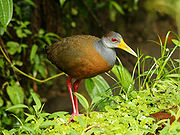
.jpg)
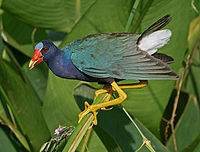
Gruiformes
The Gruiformes are an order containing a considerable number of living and extinct bird families, with a widespread geographical diversity. Gruiform means "crane-like"....
. Family: Rallidae
Rallidae
The rails, or Rallidae, are a large cosmopolitan family of small to medium-sized birds. The family exhibits considerable diversity and the family also includes the crakes, coots, and gallinules...
Rallidae is a large family of small to medium-sized birds which includes the rails, crakes, coot
Coot
Coots are medium-sized water birds that are members of the rail family Rallidae. They constitute the genus Fulica. Coots have predominantly black plumage, and, unlike many of the rails, they are usually easy to see, often swimming in open water...
s, and gallinule
Rallidae
The rails, or Rallidae, are a large cosmopolitan family of small to medium-sized birds. The family exhibits considerable diversity and the family also includes the crakes, coots, and gallinules...
s. Typically they inhabit dense vegetation in damp environments near lakes, swamps, or rivers. In general they are shy and secretive birds, difficult to observe. Most species have strong legs, and have long toes which are well adapted to soft, uneven surfaces. They tend to have short, rounded wings and be weak fliers. There are 143 species worldwide and 13 species which occur in Guatemala.
- Ruddy CrakeRuddy CrakeThe Ruddy Crake is a bird in the rail family, Rallidae. It is a small crake, 14-16.5 cm in length. It is mostly bright chestnut in colour with a paler chin and belly, blackish crown and dark grey ear-coverts. The bill is black, the iris is red and the legs and feet are olive-green.The bird...
Laterallus ruber - Gray-breasted Crake Laterallus exilis
- Black RailBlack RailThe Black Rail is a mouse-sized member of the Rallidae family of birds. It is found in scattered parts of North America and the Pacific region of South America, usually in coastal salt marshes but also in some freshwater marshes. It is extinct or threatened in many locations due to habitat loss...
Laterallus jamaicensis (A) - Virginia RailVirginia RailThe Virginia Rail, Rallus limicola, is a small waterbird, of the family Rallidae.Adults are mainly brown, darker on the back and crown, with orange-brown legs. They have long toes, a short tail and a long slim reddish bill...
Rallus limicola - Rufous-necked Wood-RailRufous-necked Wood-railThe Rufous-necked Wood Rail is a species of bird in the Rallidae family.It is found in Belize, Colombia, Costa Rica, Ecuador, El Salvador, French Guiana, Guyana, Honduras, Mexico, Nicaragua, Panama, Peru, Suriname, Trinidad and Tobago, and Venezuela.Its natural habitats are subtropical or tropical...
Aramides axillaris - Gray-necked Wood-Rail Aramides cajanea
- Uniform CrakeUniform CrakeThe Uniform Crake is a species of bird in the Rallidae family, the only member of the genus Amaurolimnas. It is found widely, but locally, in swampy forests and wetlands of southern Mexico, and Central and South America...
Amaurolimnas concolor - SoraSora-Tribe: Sora is the tribe inhabitant the districts of West Siang and East Siang of Arunachal Pradesh in the North-East Indian Himalaya.-Places:Colombia* Sora, Boyacá, a municipio in Boyacá Department, AndeanGermany...
Porzana carolina - Yellow-breasted CrakeYellow-breasted CrakeThe Yellow-breasted Crake is a species of bird in the Rallidae family.It is found in Argentina, Belize, Bolivia, Brazil, Cayman Islands, Colombia, Costa Rica, Cuba, the Dominican Republic, El Salvador, French Guiana, Guatemala, Guyana, Haiti, Jamaica, Mexico, Nicaragua, Panama, Paraguay, Puerto...
Porzana flaviventer - Spotted RailSpotted RailThe Spotted Rail is a species of bird in the Rallidae family.It is found in Argentina, Belize, Bolivia, Brazil, Cayman Islands, Chile, Colombia, Costa Rica, Cuba, the Dominican Republic, Ecuador, El Salvador, French Guiana, Guyana, Haiti, Jamaica, Mexico, Panama, Paraguay, Peru, Suriname, Trinidad...
Pardirallus maculatus - Purple GallinulePurple GallinulePurple Gallinule is an alternative name for two species of birds in the rail family. It can refer to:* Purple Swamphen, Porphyrio porphyrio of the Old World* American Purple Gallinule, Porphyrio martinica of the New World...
Porphyrio martinica - Common MoorhenCommon MoorhenThe Common Moorhen is a bird in the Rallidae family with an almost worldwide distribution. The North and South American Committees of the AOU and the IOC have voted on or before July 2011 to split the American forms into a new species Common Gallinule, however, no other committee has voted to...
Gallinula chloropus - American CootAmerican CootThe American Coot is a bird of the family Rallidae, inhabiting wetlands and open water bodies. Measuring in length and across the wings, adults have a short thick white bill and white frontal shield, which usually has a reddish-brown spot near the top of the bill between the eyes...
Fulica americana
Sungrebe and Finfoots
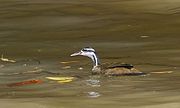
Gruiformes
The Gruiformes are an order containing a considerable number of living and extinct bird families, with a widespread geographical diversity. Gruiform means "crane-like"....
. Family: Heliornithidae
Heliornithidae
The Heliornithidae are a small family of tropical birds with webbed lobes on their feet like those of grebes and coots. The family overall are known as finfoots, although one species is known as a Sungrebe. The family is composed of three species in three genera.-Description:Finfoots resemble...
The Heliornithidae are small family of tropical birds with webbed lobes on their feet similar to those of grebes and coots. There are 3 species worldwide and 1 species which occurs in Guatemala.
- SungrebeSungrebeThe Sungrebe or American Finfoot is a bird which breeds in tropical Central and South America from southern Mexico to northeast Argentina and southern Brazil....
Heliornis fulica
Sunbittern
Order: EurypygiformesEurypygiformes
Eurypygiformes is a clade formed by the Kagu , a bird endemic to New Caledonia, and the Sunbittern from the tropical regions of the Americas....
. Family: Eurypygidae
The Sunbittern is a bittern
Bittern
Bitterns are a classification of birds in the heron family, Ardeidae, a family of wading birds. Species named bitterns tend to be the shorter-necked, often more secretive members of this family...
-like bird
Bird
Birds are feathered, winged, bipedal, endothermic , egg-laying, vertebrate animals. Around 10,000 living species and 188 families makes them the most speciose class of tetrapod vertebrates. They inhabit ecosystems across the globe, from the Arctic to the Antarctic. Extant birds range in size from...
of tropical regions of the Americas
Americas
The Americas, or America , are lands in the Western hemisphere, also known as the New World. In English, the plural form the Americas is often used to refer to the landmasses of North America and South America with their associated islands and regions, while the singular form America is primarily...
, and the sole member of the family Eurypygidae (sometimes spelled Eurypigidae) and genus Eurypyga.
- SunbitternSunbitternThe Sunbittern, Eurypyga helias is a bittern-like bird of tropical regions of the Americas, and the sole member of the family Eurypygidae and genus Eurypyga.-Description and reproduction:...
Eurypyga helias
Limpkins
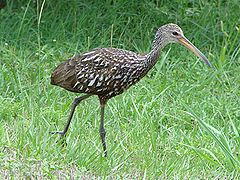
Gruiformes
The Gruiformes are an order containing a considerable number of living and extinct bird families, with a widespread geographical diversity. Gruiform means "crane-like"....
. Family: Aramidae
The Limpkin resembles a large rail. It has drab brown plumage and a greyer head and neck.
- LimpkinLimpkinThe Limpkin , Aramus guarauna, is a bird that looks like a large rail but is skeletally closer to cranes. It is the only extant species in the genus Aramus and the family Aramidae. It is found mostly in wetlands in warm parts of the Americas, from Florida to northern Argentina...
Aramus guarauna
Thick-knees
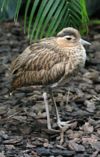
Charadriiformes
Charadriiformes is a diverse order of small to medium-large birds. It includes about 350 species and has members in all parts of the world. Most Charadriiformes live near water and eat invertebrates or other small animals; however, some are pelagic , some occupy deserts and a few are found in thick...
. Family: Burhinidae
The thick-knees are a group of largely tropical waders in the family Burhinidae. They are found worldwide within the tropical zone, with some species also breeding in temperate Europe and Australia. They are medium to large waders with strong black or yellow black bills, large yellow eyes and cryptic plumage. Despite being classed as waders, most species have a preference for arid or semi-arid habitats. There are 9 species worldwide and 1 species which occurs in Guatemala.
- Double-striped Thick-kneeDouble-striped Thick-kneeThe Double-striped Thick-knee, Burhinus bistriatus, is a Stone-curlew, a group of waders in the family Burhinidae.It is a resident breeder in Central and South America from southern Mexico south to Colombia, Venezuela and northern Brazil...
Burhinus bistriatus
Plovers and lapwings
Order: CharadriiformesCharadriiformes
Charadriiformes is a diverse order of small to medium-large birds. It includes about 350 species and has members in all parts of the world. Most Charadriiformes live near water and eat invertebrates or other small animals; however, some are pelagic , some occupy deserts and a few are found in thick...
. Family: Charadriidae
Charadriidae
The bird family Charadriidae includes the plovers, dotterels, and lapwings, about 64 to 66 species in all.- Morphology :They are small to medium-sized birds with compact bodies, short, thick necks and long, usually pointed, wings, but most species of lapwing may have more rounded wings...
The family Charadriidae includes the plover
Plover
Plovers are a widely distributed group of wading birds belonging to the subfamily Charadriinae. There are about 40 species in the subfamily, most of them called "plover" or "dotterel". The closely related lapwing subfamily, Vanellinae, comprises another 20-odd species.Plovers are found throughout...
s, dotterels, and lapwing
Lapwing
Vanellinae are any of various crested plovers, family Charadriidae, noted for its slow, irregular wingbeat in flight and a shrill, wailing cry. Its length is 10-16 inches. They are a subfamily of medium-sized wading birds which also includes the plovers and dotterels. The Vanellinae are...
s. They are small to medium-sized birds with compact bodies, short, thick necks and long, usually pointed, wings. They are found in open country worldwide, mostly in habitats near water, although there are some exceptions. There are 66 species worldwide and 7 species which occur in Guatemala.
- Black-bellied Plover Pluvialis squatarola
- American Golden-Plover Pluvialis dominica
- Collared PloverCollared PloverThe Collared Plover, Charadrius collaris, is a small shorebird in the plover family, Charadriidae. It lives along coasts and riverbanks of the tropical to temperate Americas, from central Mexico south to Chile and Argentina....
Charadrius collaris - Snowy PloverSnowy PloverThe Snowy Plover is a small wader in the plover bird family. It breeds in Ecuador, Peru, Chile, the southern and western USA and the Caribbean...
Charadrius alexandrinus - Wilson's PloverWilson's PloverThe Wilson's Plover is a small plover.Wilson's Plover is a coastal wader which breeds on both coasts of the Americas from the equator northwards. Its range extends north to include much of the U.S. eastern seaboard, and the Pacific coast of Mexico on the west.It is a partial migrant. Birds leave...
Charadrius wilsonia - Semipalmated PloverSemipalmated PloverThe Semipalmated Plover is a small plover.This species weighs and measures in length and across the wings. Adults have a grey-brown back and wings, a white belly, and a white breast with one black neckband...
Charadrius semipalmatus - KilldeerKilldeerThe Killdeer is a medium-sized plover.Adults have a brown back and wings, a white belly, and a white breast with two black bands. The rump is tawny orange. The face and cap are brown with a white forehead. They have an orange-red eyering...
Charadrius vociferus
Oystercatchers
_in_flight.jpg)
Charadriiformes
Charadriiformes is a diverse order of small to medium-large birds. It includes about 350 species and has members in all parts of the world. Most Charadriiformes live near water and eat invertebrates or other small animals; however, some are pelagic , some occupy deserts and a few are found in thick...
. Family: Haematopodidae
The oystercatcher
Oystercatcher
The oystercatchers are a group of waders; they form the family Haematopodidae, which has a single genus, Haematopus. They are found on coasts worldwide apart from the polar regions and some tropical regions of Africa and South East Asia...
s are large and noisy plover
Plover
Plovers are a widely distributed group of wading birds belonging to the subfamily Charadriinae. There are about 40 species in the subfamily, most of them called "plover" or "dotterel". The closely related lapwing subfamily, Vanellinae, comprises another 20-odd species.Plovers are found throughout...
-like birds, with strong bills used for smashing or prising open molluscs. There are 11 species worldwide and1 species which occurs in Guatemala.
- American OystercatcherAmerican OystercatcherThe American Oystercatcher , occasionally called the American Pied Oystercatcher, is a member of family Haematopodidae. The bird is marked by its black and white body and a long, thick orange beak...
Haematopus palliatus
Avocets and stilts
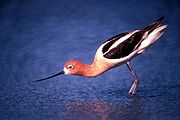
Charadriiformes
Charadriiformes is a diverse order of small to medium-large birds. It includes about 350 species and has members in all parts of the world. Most Charadriiformes live near water and eat invertebrates or other small animals; however, some are pelagic , some occupy deserts and a few are found in thick...
. Family: Recurvirostridae
Recurvirostridae
Recurvirostridae is a family of birds in the wader suborder Charadrii. It contains two distinct groups of birds, the avocets and the stilts .-Description and diet:...
Recurvirostridae is a family of large wading birds, which includes the avocet
Avocet
The four species of Avocets are a genus, Recurvirostra, of waders in the same avian family as the stilts.Avocets have long legs and long, thin, upcurved bills which they sweep from side to side when feeding in the brackish or saline wetlands they prefer...
s and the stilt
Stilt
Stilt is a common name for several species of birds in the family Recurvirostridae, which also includes those known as avocets. They are found in brackish or saline wetlands in warm or hot climates....
s. The avocets have long legs and long up-curved bills. The stilts have extremely long legs and long, thin, straight bills. There are 9 species worldwide and 2 species which occur in Guatemala.
- Black-necked StiltBlack-necked StiltThe Black-necked Stilt is a locally abundant shorebird of American wetlands and coastlines. It is found from the coastal areas of California through much of the interior western United States and along the Gulf of Mexico as far east as Florida, then south through Central America and the Caribbean...
Himantopus mexicanus - American AvocetAmerican AvocetThe American Avocet is a large wader in the avocet and stilt family, Recurvirostridae.This avocet has long, thin, gray legs, giving it its colloquial name, "blue shanks". The plumage is black and white on the back with white on the underbelly. The neck and head are cinnamon colored in the summer...
Recurvirostra americana (A)
Jacanas

Charadriiformes
Charadriiformes is a diverse order of small to medium-large birds. It includes about 350 species and has members in all parts of the world. Most Charadriiformes live near water and eat invertebrates or other small animals; however, some are pelagic , some occupy deserts and a few are found in thick...
. Family: Jacanidae
The jacana
Jacana
The jaçanas are a group of tropical waders in the family Jacanidae. They are found worldwide within the tropical zone. See Etymology below for pronunciation....
s are a group of tropical waders in the family Jacanidae. They are found worldwide in the Tropics. They are identifiable by their huge feet and claws which enable them to walk on floating vegetation in the shallow lakes that are their preferred habitat. There 8 species worldwide and1 species which occurs in Guatemala.
- Northern JacanaNorthern JacanaThe Northern Jacana or Northern Jaçana is a wader which is a resident breeder from coastal Mexico to western Panama, and on Cuba, Jamaica and Hispaniola. It sometimes breeds in Texas, USA, and has also been recorded on several occasions as a vagrant in Arizona...
Jacana spinosa
Sandpipers and allies
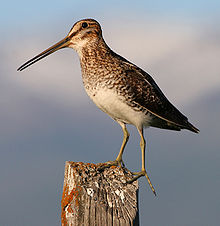
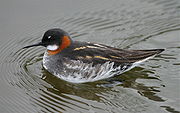
Charadriiformes
Charadriiformes is a diverse order of small to medium-large birds. It includes about 350 species and has members in all parts of the world. Most Charadriiformes live near water and eat invertebrates or other small animals; however, some are pelagic , some occupy deserts and a few are found in thick...
. Family: Scolopacidae
Scolopacidae
The sandpipers are a large family, Scolopacidae, of waders or shorebirds. They include many species called sandpipers, as well as those called by names such as curlew and snipe. The majority of these species eat small invertebrates picked out of the mud or soil...
The Scolopacidae are a large diverse family of small to medium sized shorebirds including the sandpipers, curlew
Curlew
The curlews , genus Numenius, are a group of eight species of birds, characterised by long, slender, downcurved bills and mottled brown plumage. They are one of the most ancient lineages of scolopacid waders, together with the godwits which look similar but have straight bills...
s, godwit
Godwit
The godwits are a group of large, long-billed, long-legged and strongly migratory wading birds of the genus Limosa. They form large flocks on coasts and estuaries in winter....
s, shanks
Tringa
Tringa is a genus of waders, containing the shanks and tattlers. They are mainly freshwater birds, often with brightly coloured legs as reflected in the English names of six species, as well as the specific names of two of these and the Green Sandpiper. They are typically associated with northern...
, tattler
Tattler (bird)
The tattlers are the two very similar bird species in the shorebird genus Tringa. They formerly had their own genus, Heteroscelus. The old genus name means "different leg" in Greek, referring to the leg scales that differentiate the tattlers from their close relatives, the shanks.The species are:*...
s, woodcock
Woodcock
The woodcocks are a group of seven or eight very similar living species of wading birds in the genus Scolopax. Only two woodcocks are widespread, the others being localized island endemics. Most are found in the Northern Hemisphere but a few range into Wallacea...
s, snipe
Snipe
A snipe is any of about 25 wading bird species in three genera in the family Scolopacidae. They are characterized by a very long, slender bill and crypsis plumage. The Gallinago snipes have a nearly worldwide distribution, the Lymnocryptes Jack Snipe is restricted to Asia and Europe and the...
s, dowitcher
Dowitcher
The three dowitchers are medium-sized long-billed wading birds. They resemble godwits in body and bill shape, and the reddish underparts in summer, but are much shorter legged, more like snipe to which they are also somewhat closer related...
s and phalarope
Phalarope
A phalarope or wadepiper is any of three living species of slender-necked shorebirds in the genus Phalaropus of the bird family Scolopacidae. They are close relatives of the shanks and tattlers, the Actitis and Terek Sandpipers, and also of the turnstones and calidrids...
s. The majority of species eat small invertebrates picked out of the mud or soil. Variation in length of legs and bills enable different species to feed in the same habitat, particularly on the coast, without direct competition for food. There are 89 species worldwide and 31 species which occur in Guatemala.
- Spotted SandpiperSpotted SandpiperThe Spotted Sandpiper is a small shorebird, 18–20 cm long. Together with its sister species, the Common Sandpiper they make up the genus Actitis...
Actitis macularius - Solitary SandpiperSolitary SandpiperThe Solitary Sandpiper is a small wader .-Description:This species measures long, with a wingspan up to and a body mass of . It is a dumpy wader with a dark green back, greyish head and breast and otherwise white underparts. It is obvious in flight, with wings dark above and below, and a dark...
Tringa solitaria - Wandering TattlerWandering TattlerThe Wandering Tattler, Tringa incana , is a medium-sized wading bird. It is similar in appearance to the closely related Gray-tailed Tattler, T. brevipes...
Tringa incana - Greater YellowlegsGreater YellowlegsThe Greater Yellowlegs, Tringa melanoleuca, is a large North American shorebird, similar in appearance to the smaller Lesser Yellowlegs. Its closest relative, however, is the Greenshank, which together with the Spotted Redshank form a close-knit group...
Tringa melanoleuca - WilletWilletThe Willet, Tringa semipalmata , is a large shorebird in the sandpiper family. It is a good-sized and stout scolopacid, the largest of the shanks...
Tringa semipalmata - Lesser YellowlegsLesser YellowlegsThe Lesser Yellowlegs is a medium-sized shorebird similar in appearance to the larger Greater Yellowlegs. It is not closely related to this bird, however, but instead to the much larger and quite dissimilar Willet; merely the fine, clear and dense pattern of the neck shown in breeding plumage...
Tringa flavipes - Upland SandpiperUpland SandpiperThe Upland Sandpiper is a large shorebird, closely related to the curlews . Older names are the Upland Plover and Bartram's Sandpiper. It is the only member of the genus Bartramia. The genus name and the old common name Bartram's Sandpiper commemorate the American naturalist William Bartram...
Bartramia longicauda - Eskimo CurlewEskimo CurlewThe Eskimo or the "Northern Curlew" is a critically endangered shorebird, now considered by many to be extinct.-Taxonomy:The Eskimo Curlew is one of eight species of curlew, and is classed with them in the genus Numenius. It was formerly placed in the separate genus Mesoscolopax. Numenius is...
Numenius borealis (A) Critically endangered (possibly extinct) - WhimbrelWhimbrelThe Whimbrel Numenius phaeopus, is a wader in the large family Scolopacidae. It is one of the mostwidespread of the curlews, breeding across much of subarctic North America, Europe and Asia as far south as Scotland....
Numenius phaeopus - Long-billed CurlewLong-billed CurlewThe Long-billed Curlew, Numenius americanus, is a large North American shorebird of the family Scolopacidae. This species was also called "sicklebird" and the "candlestick bird". The species is native to central and western North America...
Numenius americanus - Hudsonian GodwitHudsonian GodwitThe Hudsonian Godwit, Limosa haemastica, is a large shorebird.-Identification:Adults have long dark legs and a long pink bill with a slight upward curve and dark at the tip. The upper parts are mottled brown and the underparts are chestnut. The tail is black and the rump is white...
Limosa haemastica - Marbled GodwitMarbled GodwitThe Marbled Godwit, Limosa fedoa, is a large shorebird. On average, it is the largest of the 4 species of godwit. The total length is , including a large bill of , and wingspan is . Body mass can vary from ....
Limosa fedoa - Ruddy TurnstoneRuddy TurnstoneThe Ruddy Turnstone is a small wading bird, one of two species of turnstone in the genus Arenaria. It is now classified in the sandpiper family Scolopacidae but was formerly sometimes placed in the plover family Charadriidae...
Arenaria interpres - SurfbirdSurfbirdThe Surfbird is a small stocky wader in the family Scolopacidae. It is usually classified in a genus of its own, as Aphriza virgata, and was once considered to be allied to the turnstones, but more recent data suggests it is very close genetically to the Red and Great Knots and should be included...
Aphriza virgata - Red KnotRed KnotThe Red Knot, Calidris canutus , is a medium sized shorebird which breeds in tundra and the Arctic Cordillera in the far north of Canada, Europe, and Russia. It is a large member of the Calidris sandpipers, second only to the Great Knot...
Calidris canutus - SanderlingSanderlingThe Sanderling is a small wader. It is a circumpolar Arctic breeder, and is a long-distance migrant, wintering south to South America, South Europe, Africa, and Australia...
Calidris alba - Semipalmated SandpiperSemipalmated SandpiperThe Semipalmated Sandpiper, Calidris pusilla, is a very small shorebird. It is sometimes separated with other "stints" in Erolia but although these apparently form a monophyletic group, the present species' old genus Ereunetes had been proposed before Erolia.Adults have black legs and a short stout...
Calidris pusilla - Western SandpiperWestern SandpiperThe Western Sandpiper, Calidris or Erolia mauri, is a small shorebird.Adults have dark legs and a short thin dark bill, thinner at the tip. The body is brown on top and white underneath. They are reddish-brown on the crown. This bird can be difficult to distinguish from other similar tiny...
Calidris mauri - Least SandpiperLeast SandpiperThe Least Sandpiper is the smallest shorebird.This species has greenish legs and a short thin dark bill. Breeding adults are brown with dark brown streaks on top and white underneath. They have a light line above the eye and a dark crown. In winter, Least Sandpipers are grey above...
Calidris minutilla - White-rumped SandpiperWhite-rumped SandpiperThe White-rumped Sandpiper is a small shorebird.Adults have black legs and a small thin dark bill. The body is dark brown on top and mainly white underneath, with brown streaks on the breast and a white rump. They have a white stripe over their eyes. This bird shows long wings in flight. In winter...
Calidris fuscicollis - Baird's SandpiperBaird's SandpiperThe Baird's Sandpiper is a small shorebird. It is among those calidrids sometimes separated in Erolia.Adults have black legs and a short thin dark bill. They are dark brown on top and mainly white underneath with a black patch on the rump. The head and breast are light brown with dark streaks. In...
Calidris bairdii - Pectoral SandpiperPectoral SandpiperThe Pectoral Sandpiper, Calidris melanotos, is a small wader. It is sometimes separated with the "stint" sandpipers in Erolia. This may or may not represent a good monophyletic group, depending on the placement of the phylogenetically enigmatic Curlew Sandpiper , the type species of Erolia...
Calidris melanotos - DunlinDunlinThe Dunlin, Calidris alpina, is a small wader, sometimes separated with the other "stints" in Erolia. It is a circumpolar breeder in Arctic or subarctic regions. Birds that breed in northern Europe and Asia are long-distance migrants, wintering south to Africa, southeast Asia and the Middle East...
Calidris alpina - Stilt SandpiperStilt SandpiperThe Stilt Sandpiper, Calidris himantopus or Micropalama himantopus, is a small shorebird; it bears some resemblance to the smaller calidrid sandpipers or "stints". DNA sequence information is incapable of determining whether it should be placed in Calidris or in the monotypic genus Micropalama...
Calidris himantopus - Buff-breasted SandpiperBuff-breasted SandpiperThe Buff-breasted Sandpiper, Tryngites subruficollis, is a small shorebird. It is a calidrid sandpipers and currently considered to be the only member of the genus Tryngites. Indeed, it probably belongs in the genus Calidris itself, or more precisely with the small species thereof which should be...
Tryngites subruficollis Near-threatened - RuffRuffThe Ruff is a medium-sized wading bird that breeds in marshes and wet meadows across northern Eurasia. This highly gregarious sandpiper is migratory and sometimes forms huge flocks in its winter grounds, which include southern and western Europe, Africa, southern Asia and Australia...
Philomachus pugnax (A) - Short-billed DowitcherShort-billed DowitcherThe Short-billed Dowitcher like its congener the Long-billed Dowitcher, is a medium-sized, stocky, long-billed shorebird in the family Scolopacidae. It is an inhabitant of North America, Middle America, and northern South America. It is strongly migratory; it completely vacates in breeding areas...
Limnodromus griseus - Long-billed DowitcherLong-billed DowitcherThe Long-billed Dowitcher, Limnodromus scolopaceus, is a medium-sized shorebird.Adults have yellowish legs and a long straight dark bill. The body is dark brown on top and reddish underneath with spotted throat and breast, bars on flanks. The tail has a black and white barred pattern...
Limnodromus scolopaceus - Wilson's SnipeWilson's SnipeWilson's Snipe is a small, stocky shorebird. This species was formerly considered to be a subspecies of the Common Snipe, G. gallinago. Wilson's Snipe differs from the latter species in having a narrower white edge to the wings, and eight pairs of tail feathers instead of seven.Adults are...
Gallinago delicata - Wilson's PhalaropeWilson's PhalaropeThe Wilson's Phalarope, Phalaropus tricolor, is a small wader. This bird, the largest of the phalaropes, breeds in the prairies of North America in western Canada and the western United States. It is migratory, wintering around the central Andes in South America. They are passage migrants through...
Phalaropus tricolor - Red-necked PhalaropeRed-necked PhalaropeThe Red-necked Phalarope, Phalaropus lobatus, is a small wader. This phalarope breeds in the Arctic regions of North America and Eurasia. It is migratory, and, unusually for a wader, winters at sea on tropical oceans....
Phalaropus lobatus (A)
Gulls
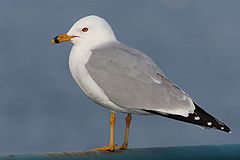
Charadriiformes
Charadriiformes is a diverse order of small to medium-large birds. It includes about 350 species and has members in all parts of the world. Most Charadriiformes live near water and eat invertebrates or other small animals; however, some are pelagic , some occupy deserts and a few are found in thick...
. Family: Laridae
Laridae is a family of medium to large birds seabirds and includes gull
Gull
Gulls are birds in the family Laridae. They are most closely related to the terns and only distantly related to auks, skimmers, and more distantly to the waders...
s and kittiwake
Kittiwake
The kittiwakes are two closely related seabird species in the gull family Laridae, the Black-legged Kittiwake and the Red-legged Kittiwake . The epithets "Black-legged" and "Red-legged" are used to distinguish the two species in North America, but in Europe, where R...
s. They are typically grey or white, often with black markings on the head or wings. They have stout, longish bills and webbed feet. There are 55 species worldwide and 7 species which occur in Guatemala.
- Sabine's GullSabine's GullThe Sabine's Gull is a small gull. Its generic placement is disputed; some authors treat it as the sole species in the genus Xema as Xema sabini, while others retain it in the genus Larus as Larus sabini. It breeds in the arctic and has a circumpolar distribution through northernmost North America...
Xema sabini - Bonaparte's GullBonaparte's GullThe Bonaparte's Gull is a small gull.The Bonaparte's Gull is a small species, larger only than the Little Gull and the Saunders's Gull among all gull species. Adults are long with a wingspan and a body mass of . They have a black hood and a short thin dark bill. The body is mainly white with...
Chroicocephalus philadelphia - Laughing GullLaughing GullThe Laughing Gull, Leucophaeus atricilla, is a medium-sized gull of North and South America. It breeds on the Atlantic coast of North America, the Caribbean, and northern South America. Northernmost populations migrate further south in winter, and this species occurs as a rare vagrant to western...
Leucophaeus atricilla - Franklin's GullFranklin's GullThe Franklin's Gull is a small gull.-Description:It breeds in central provinces of Canada and adjacent states of the northern United States...
Leucophaeus pipixcan - Heermann's GullHeermann's GullThe Heermann's Gull is a gull resident in the United States, Mexico and extreme southwestern British Columbia. Of the current population of about 150,000 pairs, 90% nest on the island of Isla Rasa off Baja California in the Gulf of California, with smaller colonies as far north as California and...
Larus heermanni Near-threatened - Ring-billed GullRing-billed GullThe Ring-billed Gull is a medium-sized gull.Adults are length and with a wingspan. The head, neck and underparts are white; the relatively short bill is yellow with a dark ring; the back and wings are silver gray; and the legs are yellow. The eyes are yellow with red rims...
Larus delawarensis - Herring GullHerring GullThe European Herring Gull is a large gull , and is the most abundant and best known of all gulls along the shores of western Europe. It breeds across Northern Europe, Western Europe, Scandinavia and the Baltic states...
Larus argentatus - Brown NoddyBrown NoddyThe Brown Noddy or Common Noddy is a seabird from the tern family. The largest of the noddies, it can be told from the closely related Black Noddy by its larger size and plumage, which is dark brown rather than black...
Anous stolidus (A) - Sooty TernSooty TernThe Sooty Tern, Onychoprion fuscatus , is a seabird of the tern family . It is a bird of the tropical oceans, breeding on islands throughout the equatorial zone. Colloquially, it is known as the Wideawake Tern or just wideawake...
Onychoprion fuscatus - Least Tern Sternula antillarum
- Gull-billed TernGull-billed TernThe Gull-billed Tern formerly Sterna nilotica , is a seabird of the tern family Sternidae...
Gelochelidon nilotica - Caspian TernCaspian TernThe Caspian Tern is a species of tern, with a subcosmopolitan but scattered distribution. Despite its extensive range, it is monotypic of its genus, and has no subspecies accepted either...
Hydroprogne caspia - Black TernBlack TernThe Black Tern, Chlidonias niger, is a small tern generally found in or near inland water in Europe and North America. As its name suggests, it has predominantly dark plumage.- Description :...
Chlidonias niger - Common TernCommon TernThe Common Tern is a seabird of the tern family Sternidae. This bird has a circumpolar distribution, breeding in temperate and sub-Arctic regions of Europe, Asia and east and central North America. It is strongly migratory, wintering in coastal tropical and subtropical regions. It is sometimes...
Sterna hirundo - Forster's TernForster's TernThe Forster's Tern, Sterna forsteri, is a member of the tern family Sternidae. It breeds inland in North America and winters south to the Caribbean and northern South America....
Sterna forsteri - Royal TernRoyal TernThe Royal Tern is a seabird in the tern family Sternidae. This bird has two distinctive subspecies. T. m. maximus breeds on the Atlantic and Pacific coasts of the southern USA and Mexico into the Caribbean. The slightly smaller T. m. albididorsalis breeds in coastal west Africa...
Thalasseus maximus - Sandwich Tern Thalasseus sandvicensis
- Elegant TernElegant TernThe Elegant Tern is a seabird of the tern family Sternidae. It breeds on the Pacific coasts of the southern USA and Mexico and winters south to Peru, Ecuador and Chile....
Thalasseus elegans Near-threatened - Black SkimmerBlack SkimmerThe Black Skimmer, Rynchops niger, is a tern-like seabird, one of three very similar birds species in the skimmer family. It breeds in North and South America...
Rynchops niger
Skuas and jaegers

Charadriiformes
Charadriiformes is a diverse order of small to medium-large birds. It includes about 350 species and has members in all parts of the world. Most Charadriiformes live near water and eat invertebrates or other small animals; however, some are pelagic , some occupy deserts and a few are found in thick...
. Family: Stercorariidae
The family Stercorariidae are, in general, medium to large birds, typically with grey or brown plumage, often with white markings on the wings. They nest on the ground in temperate and arctic regions and are long-distance migrants. There are 7 species worldwide and 3 species which occur in Guatemala.
- Pomarine Jaeger Stercorarius pomarinus
- Parasitic Jaeger Stercorarius parasiticus
- Long-tailed Jaeger Stercorarius longicaudus
Pigeons and doves
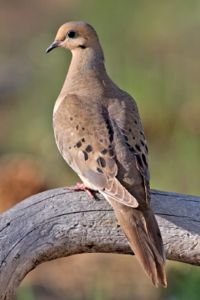
Columbiformes
Columbiformes are an avian order that includes the very widespread and successful doves and pigeons, classified in the family Columbidae, and the extinct Dodo and the Rodrigues Solitaire, long classified as a second family Raphidae. 313 species, found worldwide, comprise the Columbiformes order....
. Family: Columbidae
Pigeons and dove
Dove
Pigeons and doves constitute the bird family Columbidae within the order Columbiformes, which include some 300 species of near passerines. In general terms "dove" and "pigeon" are used somewhat interchangeably...
s are stout-bodied birds with short necks and short slender bills with a fleshy cere
Cère
The Cère is a long river in south-western France, left tributary of the Dordogne River. Its source is in the south-western Massif Central, near the mountain Plomb du Cantal...
. There are 308 species worldwide and 19 species which occur in Guatemala.
- Rock PigeonRock PigeonThe Rock Dove or Rock Pigeon, is a member of the bird family Columbidae . In common usage, this bird is often simply referred to as the "pigeon"....
Columba livia (I) - Pale-vented PigeonPale-vented PigeonThe Pale-vented Pigeon, Patagioenas cayennensis, is a large pigeon found in the tropical American. Formerly often placed in Columba, it actually belongs to a clade of the older New World genus Patagioenas. With its relatives it represents an evolutionary radiation extending through most of the...
Patagioenas cayennensis - Scaled PigeonScaled PigeonThe Scaled Pigeon, Patagioenas speciosa , is a large New World tropical dove. It is a resident breeder from southern Mexico south to western Ecuador, southern Brazil, northern Argentina, and Trinidad....
Patagioenas speciosa - Red-billed PigeonRed-billed PigeonThe Red-billed Pigeon, Patagioenas flavirostris , is a relatively large pigeon which breeds from southern Texas, United States, and northwestern Mexico south to Costa Rica...
Patagioenas flavirostris - Band-tailed PigeonBand-tailed PigeonThe Band-tailed Pigeon, Patagioenas fasciata, is a medium-sized bird of the Americas. Its closest relatives are the Chilean Pigeon and the Ring-tailed Pigeon, which form a clade of Patagioenas with a terminal tail band and iridescent plumage on their necks.It ranges from British Columbia, Utah, and...
Patagioenas fasciata - Short-billed PigeonShort-billed PigeonThe Short-billed Pigeon, Patagioenas nigrirostris , is a largish pigeon which breeds from southern Mexico south to northwestern Colombia...
Patagioenas nigrirostris - White-winged DoveWhite-winged DoveThe White-winged Dove is a dove whose native range extends from the south-western USA through Mexico, Central America, and the Caribbean. In recent years with increasing urbanization and backyard feeding, it has expanded throughout Texas and into Louisiana...
Zenaida asiatica - Mourning DoveMourning DoveThe Mourning Dove is a member of the dove family . The bird is also called the Turtle Dove or the American Mourning Dove or Rain Dove, and formerly was known as the Carolina Pigeon or Carolina Turtledove. It is one of the most abundant and widespread of all North American birds...
Zenaida macroura - Inca DoveInca DoveThe Inca Dove is a small New World dove; it might belong to the genus. It ranges from the southwestern United States and Mexico through Central America to Costa Rica; the Inca Dove only lives on the Pacific side of Central America. Despite being named after the Inca Empire, this species does not...
Columbina inca - Common Ground-Dove Columbina passerina
- Plain-breasted Ground-DovePlain-breasted Ground-doveThe Plain-breasted Ground Dove is a species of bird in the Columbidae family. They lack the scaled appearance to the feathers of the similar and typically more abundant Common Ground Dove...
Columbina minuta - Ruddy Ground-Dove Columbina talpacoti
- Blue Ground-Dove Claravis pretiosa
- Maroon-chested Ground-DoveMaroon-chested Ground-doveThe Maroon-chested Ground Dove is a species of bird in the Columbidae family. It is found in Bolivia, Colombia, Costa Rica, Ecuador, El Salvador, Guatemala, Honduras, Mexico, Panama, Peru, and Venezuela....
Claravis mondetoura - White-tipped DoveWhite-tipped DoveThe White-tipped Dove is a large New World tropical dove. It is a resident breeder from the southernmost Texas in the USA through Mexico and Central America south to western Peru and central Argentina. It also breeds on the offshore islands of northern South America, including Trinidad and Tobago...
Leptotila verreauxi - Gray-chested Dove Leptotila cassini
- White-faced Quail-DoveWhite-faced Quail-doveThe White-faced Quail-Dove is a species of bird in the Columbidae family.It is found in El Salvador, Guatemala, Honduras, Mexico, and Nicaragua.Its natural habitat is subtropical or tropical moist montanes.-References:...
Geotrygon albifacies - Ruddy Quail-DoveRuddy Quail-DoveThe Ruddy Quail-Dove is a member of the bird family Columbidae, which includes doves and pigeons.It breeds throughout the West Indies, Central America, and tropical South America. It has appeared as a vagrant in Florida and southern Texas. It lays two buff colored eggs on a flimsy platform...
Geotrygon montana
Parrots, macaws and allies
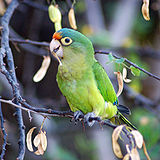
Parrot
Parrot
Parrots, also known as psittacines , are birds of the roughly 372 species in 86 genera that make up the order Psittaciformes, found in most tropical and subtropical regions. The order is subdivided into three families: the Psittacidae , the Cacatuidae and the Strigopidae...
s are small to large birds with a characteristic curved beak shape. Their upper mandibles have slight mobility in the joint with the skull and the have a generally erect stance. All parrots are zygodactyl, having the four toes on each foot placed two at the front and two back. There are 335 species worldwide and 16 species which occur in Guatemala.
- Green ParakeetGreen ParakeetThe Green Parakeet , is a medium-sized parrot that is native to Central America, from Mexico south to northern Nicaragua. These birds have established self sustaining populations in some cities in southeast Texas in the United States. It is unclear if the US population are feral released birds...
Aratinga holochlora - Pacific ParakeetPacific ParakeetThe Pacific Parakeet or Nicaraguan Green Conure is a subspecies of the Green Parakeet. It was long considered a distinct species....
Aratinga strenua - Olive-throated ParakeetOlive-throated ParakeetThe Olive-throated Parakeet , also known as the Olive-throated Conure in aviculture, is a species of parrot in the Psittacidae family...
Aratinga nana - Orange-fronted ParakeetOrange-fronted ParakeetThe Orange-fronted Parakeet or Orange-fronted Conure , also known as the Half-moon Conure, is a medium-sized parrot which is a resident from western Mexico to Costa Rica.-Taxonomy:There are three subspecies:...
Aratinga canicularis - Military MacawMilitary MacawThe Military Macaw is a large parrot and a medium-sized member of the macaw genus. Though considered vulnerable as a wild species, it is still commonly found in the pet trade industry. A predominantly green bird, it is found in the forests of Mexico and South America.-Taxonomy:There are three...
Ara militaris Vulnerable - Scarlet MacawScarlet MacawThe Scarlet Macaw is a large, colorful macaw. It is native to humid evergreen forests in the American tropics. Range extends from extreme south-eastern Mexico to Amazonian Peru, Bolivia and Brazil in lowlands up to up to...
Ara macao - Barred ParakeetBarred ParakeetThe Barred Parakeet , also known as Lineolated Parakeet, Catherine Parakeet or 'Linnies' for short, is a small parrot found disjunctly in highland forests from southern Mexico to Panama, in the Andes from western Venezuela to southern Peru, the Santa Marta Mountains in Colombia and the Venezuelan...
Bolborhynchus lineola - Orange-chinned ParakeetOrange-chinned ParakeetThe Orange-chinned Parakeet , also known as the Tovi Parakeet, is a small mainly green parrot of the Brotogeris genus. It is found in Colombia, Costa Rica, El Salvador, Guatemala, Honduras, Mexico, Nicaragua, Panama, and Venezuela...
Brotogeris jugularis - Brown-hooded ParrotBrown-hooded ParrotThe Brown-hooded Parrot is a small parrot which is a resident breeding species from southeastern Mexico to north-western Colombia. Until recently, it was placed in the genus Pionopsitta, which now is restricted to the type species, the Pileated Parrot. It is sometimes considered conspecific with...
Pyrilia haematotis - White-crowned ParrotWhite-crowned ParrotThe White-crowned Parrot , also known as the White-crowned Pionus in aviculture, is a small parrot which is a resident breeding species from eastern Mexico to western Panama....
Pionus senilis - White-fronted ParrotWhite-fronted ParrotThe White-fronted Amazon, Amazona albifrons, also known as the White-fronted Parrot, or adopted slang term Spectacled Amazon Parrot is a Central American species of parrot. Not to be confused with the Red-spectacled Amazon. They also can imitate a range from 30 to 40 different sounds...
Amazona albifrons - Red-lored ParrotRed-lored ParrotThe Red-lored Amazon or Red-lored Parrot is a species of Amazon parrot, native to tropical regions of the Americas, from eastern Mexico south to Ecuador, with a disjunct population in central Brazil, where it occurs in humid evergreen to semi-deciduous forests up to 1,100 m altitude...
Amazona autumnalis - Mealy ParrotMealy ParrotThe Mealy Amazon or Mealy Parrot is among the largest parrots in the Amazona genus, the Amazon parrots. It is a mainly green parrot with a total length of 38–41 cm . It is endemic to tropical Central and South America.-Range, common names and races:The Mealy Amazon occurs in tropical Central...
Amazona farinosa - Yellow-naped ParrotYellow-naped ParrotThe Yellow-naped Parrot or Yellow-naped Amazon is an Amazon parrot sometimes considered to be a subspecies of Yellow-crowned Amazon, Amazona ochrocephala ....
Amazona auropalliata
Cuckoos and anis
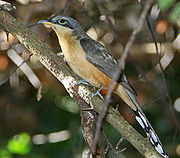
Cuculiformes
The near passerine bird order Cuculiformes traditionally included three families as below:* Musophagidae - turacos and allies* Cuculidae - cuckoos, coucals, roadrunners and anis* Opisthocomidae - Hoatzin...
. Family: Cuculidae
The family Cuculidae includes cuckoo
Cuckoo
The cuckoos are a family, Cuculidae, of near passerine birds. The order Cuculiformes, in addition to the cuckoos, also includes the turacos . Some zoologists and taxonomists have also included the unique Hoatzin in the Cuculiformes, but its taxonomy remains in dispute...
s, roadrunner
Geococcyx
The roadrunners are two species of bird in the genus Geococcyx of the cuckoo family, Cuculidae, native to North and Central America...
s and anis
Ani (bird)
The anis are the three species of near-passerine birds in the genus Crotophaga of the cuckoo family. They are essentially tropical New world birds, although the range of two species just reaches the United States...
. These birds are of variable size with slender bodies, long tails and strong legs. Unlike the cuckoo species of the Old World, North American cuckoos are not brood parasites. There are 138 species worldwide and 9 species which occur in Guatemala.
- Squirrel CuckooSquirrel CuckooThe Squirrel Cuckoo, Piaya cayana, is a large and active species of cuckoo found in wooded habitats from northwestern Mexico to northern Argentina and Uruguay, and on Trinidad.-Description:...
Piaya cayana - Yellow-billed CuckooYellow-billed CuckooThe Yellow-billed Cuckoo, Coccyzus americanus, is a cuckoo. Common folk-names for this bird in the southern United States are Rain Crow and Storm Crow...
Coccyzus americanus - Mangrove CuckooMangrove CuckooThe Mangrove Cuckoo, Coccyzus minor, is a species of cuckoo that is native to the Neotropics.Adults have a long tail, brown above and black-and-white below, and a black curved bill with yellow on the lower mandible. The head and upper parts are brown. There is a yellow ring around the eye...
Coccyzus minor - Black-billed CuckooBlack-billed CuckooThe Black-billed Cuckoo, Coccyzus erythropthalmus, is a cuckoo.Adults have a long brown tail and a black bill. The head and upper parts are brown and the underparts are white. There is a red ring around the eye. Juveniles are drabber, and the eye ring is greenish.Their breeding habitat is edges of...
Coccyzus erythropthalmus - Striped CuckooStriped CuckooThe Striped Cuckoo is a near-passerine bird, the only member of the genus Tapera. This resident cuckoo is found from Mexico and Trinidad south to Bolivia and Argentina....
Tapera naevia - Pheasant CuckooPheasant CuckooThe Pheasant Cuckoo is a species of cuckoo in the Cuculidae family.It is found in Argentina, Belize, Bolivia, Brazil, Colombia, Costa Rica, Ecuador, El Salvador, French Guiana, Guatemala, Guyana, Honduras, Mexico, Nicaragua, Panama, Paraguay, Peru, Suriname, and Venezuela.Its natural habitats are...
Dromococcyx phasianellus - Lesser Ground-CuckooLesser Ground-cuckooThe Lesser Ground Cuckoo is a species of cuckoo in the monotypic genus Morococcyx in the family Cuculidae. It is found in Costa Rica, El Salvador, Guatemala, Honduras, Mexico, and Nicaragua. Its natural habitats are subtropical or tropical dry forests, subtropical or tropical dry shrubland, and...
Morococcyx erythropygus - Lesser RoadrunnerLesser RoadrunnerThe Lesser Roadrunner, Geococcyx velox, is a large, long-legged member of the Cuckoo family, Cuculidae.The Lesser roadrunner resembles the Greater Roadrunner in appearance and habit but is smaller and has a significantly shorter bill...
Geococcyx velox - Groove-billed AniGroove-billed AniThe Groove-billed Ani, Crotophaga sulcirostris, is an odd-looking tropical bird in the cuckoo family with a long tail and a large, curved beak. It is a resident species throughout most of its range, from southern Texas and central Mexico through Central America, to northern Colombia and Venezuela,...
Crotophaga sulcirostris
Barn owls
Order: Strigiformes. Family: TytonidaeTytonidae
Barn-owls are one of the two families of owls, the other being the true owls, Strigidae. They are medium to large sized owls with large heads and characteristic heart-shaped faces. They have long, strong legs with powerful talons...
Barn owl
Barn Owl
The Barn Owl is the most widely distributed species of owl, and one of the most widespread of all birds. It is also referred to as Common Barn Owl, to distinguish it from other species in the barn-owl family Tytonidae. These form one of two main lineages of living owls, the other being the typical...
s are medium to large sized owls with large heads and characteristic heart-shaped faces. They have long strong legs with powerful talons. There are 16 species worldwide and 1 species which occurs in Guatemala.
- Barn OwlBarn OwlThe Barn Owl is the most widely distributed species of owl, and one of the most widespread of all birds. It is also referred to as Common Barn Owl, to distinguish it from other species in the barn-owl family Tytonidae. These form one of two main lineages of living owls, the other being the typical...
Tyto alba
Typical owls

Typical owl
Typical owl
True owl or Typical owl are one of the two generally accepted families of Owls, the other being the barn owls . The Sibley-Ahlquist taxonomy unites the Caprimulgiformes with the owl order; here, the typical owls are a subfamily Strigidae...
s are small to large solitary nocturnal birds of prey. They have large forward-facing eyes and ears, a hawk-like beak, and a conspicuous circle of feathers around each eye called a facial disk. There are 195 species worldwide and 22 species which occur in Guatemala.
- Flammulated OwlFlammulated OwlThe Flammulated Owl is a small, nocturnal owl approximately 15 cm long with a 36 cm wingspan. Males and females can be distinguished by their weight. Females are larger, ranging from 62-65 grams and males are smaller ranging from 50-52 grams. The owl gets the name flammulated from the flame...
Otus flammeolus - Western Screech-Owl Megascops kennicottii
- Pacific Screech-OwlPacific Screech-owlThe Pacific Screech Owl is a species of owl in the Strigidae family. It is found in Costa Rica, El Salvador, Guatemala, Honduras, Mexico, and Nicaragua...
Megascops cooperi - Whiskered Screech-Owl Megascops trichopsis
- Bearded Screech-OwlBearded Screech-owlThe Bearded Screech Owl is a species of owl in the Strigidae family. It is found in Guatemala and Mexico.Its natural habitat is subtropical or tropical moist montane forests. It is threatened by habitat loss.- Description :...
Megascops barbarus Near-threatened - Vermiculated Screech-Owl Megascops guatemalae
- Crested OwlCrested OwlThe Crested Owl is a species of owl in the family Strigidae. It is the only species , in the genus Lophostrix....
Lophostrix cristata - Spectacled OwlSpectacled OwlThe Spectacled Owl, Pulsatrix perspicillata, is a large tropical owl. It is a resident breeder from southern Mexico and Trinidad, through Central America, south to southern Brazil, Paraguay and northwestern Argentina...
Pulsatrix perspicillata - Great Horned OwlGreat Horned OwlThe Great Horned Owl, , also known as the Tiger Owl, is a large owl native to the Americas. It is an adaptable bird with a vast range and is the most widely distributed true owl in the Americas.-Description:...
Bubo virginianus - Northern Pygmy-Owl Glaucidium gnoma
- Central American Pygmy-OwlCentral American Pygmy-owlThe Central American Pygmy Owl is a species of owl in the Strigidae family.It is found in Belize, Colombia, Costa Rica, Ecuador, Guatemala, Honduras, Mexico, Nicaragua, and Panama....
Glaucidium griseiceps - Ferruginous Pygmy-Owl Glaucidium brasilianum
- Burrowing OwlBurrowing OwlThe Burrowing Owl is a tiny but long-legged owl found throughout open landscapes of North and South America. Burrowing Owls can be found in grasslands, rangelands, agricultural areas, deserts, or any other open dry area with low vegetation. They nest and roost in burrows, such as those excavated...
Athene cunicularia - Mottled OwlMottled OwlThe Mottled Owl is a medium-sized owl found from Mexico to Brazil and Argentina. The body has vertical bars on the chest and throat and white markings in the back. The eyes are dark and the head is round and they do not have ear tufts.It is thirteen to fifteen inches in length...
Ciccaba virgata - Black-and-white OwlBlack-and-white OwlThe Black-and-white Owl is a species of owl in the Strigidae family.Compare with ITIS: It is found in Belize, Colombia, Costa Rica, Ecuador, El Salvador, Guatemala, Honduras, Mexico, Nicaragua, Panama, Peru, and Venezuela....
Ciccaba nigrolineata - Fulvous OwlFulvous OwlThe Fulvous Owl , or Guatemala Barred Owl is a bold member of the cloud forests of Central America. Its habitat is limited to the high mountain ranges and the previously mentioned cloud forests of Guatemala, Honduras, and El Salvador. It inhabits elevations from 3900 to 10000 feet and is fairly...
Strix fulvescens - Stygian OwlStygian OwlThe Stygian Owl, Asio stygius is a medium-sized dusky colored owl. It has yellow eyes, a black beak, a dark blackish facial disk, and white eyebrows. Its underparts are a dingy buff color with dark brown barring and streaks...
Asio stygius - Short-eared OwlShort-eared OwlThe Short-eared Owl is a species of typical owl . In Scotland this species of owl is often referred to as a cataface, grass owl or short-horned hootlet. Owls belonging to genus Asio are known as the eared owls, as they have tufts of feathers resembling mammalian ears. These "ear" tufts may or may...
Asio flammeus (A) - Striped OwlStriped OwlThe Striped Owl is a medium-sized owl with large ear tufts and a brownish-white facial disk rimmed with black. Its beak is black, and it has cinnamon-colored eyes. It has shorter, rounder wings than most of its close relatives. The upperparts are cinnamon with fine black vermiculation and heavy...
Pseudoscops clamator - Unspotted Saw-whet OwlUnspotted Saw-whet OwlThe Unspotted Saw-whet Owl, Aegolius ridgwayi, is a small owl. It is a resident breeder in the highlands of Central America from southern Mexico south to western Panama, mainly above 2500 m. it has occasionally been considered conspecific with the Northern Saw-whet Owl...
Aegolius ridgwayi
Nightjars
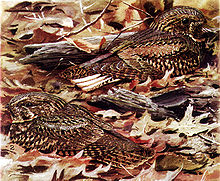
Caprimulgiformes
The Caprimulgiformes is an order of birds that includes a number of birds with global distribution . They are generally insectivorous and nocturnal...
. Family: Caprimulgidae
Nightjar
Nightjar
Nightjars are medium-sized nocturnal or crepuscular birds with long wings, short legs and very short bills. They are sometimes referred to as goatsuckers from the mistaken belief that they suck milk from goats . Some New World species are named as nighthawks...
s are medium-sized nocturnal birds with long wings, short legs and very short bills that usually nest on the ground. Most have small feet, of little use for walking, and long pointed wings. Their soft plumage is camouflaged to resemble bark or leaves. There are 86 species worldwide and 9 species which occur in Guatemala.
- Short-tailed NighthawkShort-tailed NighthawkThe Short-tailed Nighthawk is a species of nightjar in the Caprimulgidae family.-Distribution and habitat:...
Lurocalis semitorquatus - Lesser NighthawkLesser NighthawkThe Lesser Nighthawk, Chordeiles acutipennis, is a nightjar found throughout a large part of the Americas.The adults are dark with brown, grey and white patterning on the upperparts and breast; the long upperwings are black and show a white bar in flight. The tail is dark with white barring; the...
Chordeiles acutipennis - Common NighthawkCommon NighthawkThe Common Nighthawk is a medium-sized crepuscular or nocturnal bird, whose presence and identity are best revealed by its vocalization. Typically dark , displaying cryptic colouration and intricate patterns, this bird becomes invisible by day. Once aerial, with its buoyant but erratic flight,...
Chordeiles minor - Common Pauraque Nyctidromus albicollis
- Yucatan PoorwillYucatan PoorwillThe Yucatan Poorwill is a species of nightjar in the Caprimulgidae family.It is found in the entire Yucatán Peninsula region except on the north coast, in a 50 km wide coastal strip that extends 700 km; the species ranges to south-central Belize, northeasternmost Guatemala, and southern...
Nyctiphrynus yucatanicus - Chuck-will's-widowChuck-will's-widowThe Chuck-will's-widow, Caprimulgus carolinensis is a nocturnal bird of the nightjar family Caprimulgidae. It is found in the southeastern United States near swamps, rocky uplands, and pine woods...
Caprimulgus carolinensis - Yucatan NightjarYucatan NightjarThe Yucatan Nightjar is a species of nightjar in the Caprimulgidae family.It is found in Belize, Guatemala, Mexico, Nicaragua, and possibly Honduras.Its natural habitat is subtropical or tropical dry forests.-References:...
Caprimulgus badius - Buff-collared NightjarBuff-collared NightjarThe Buff-collared Nightjar is a small sized nightjar. Adults are dark with brown, grey, black, and white patterning on the upperparts and breast. The tail is dark brown, with darker finely barred markings throughout. The male has large white outer tail tips on the 3 outermost tail feathers. ...
Caprimulgus ridgwayi - Eastern Whip-poor-will Caprimulgus vociferus
- Mexican Whip-poor-willMexican Whip-poor-willThe Mexican Whip-poor-will, Caprimulgus arizonae, is a medium-sized nightjar from the southwestern United States and Mexico. The Whip-poor-will is more often heard within its range, but less often seen...
Caprimulgus arizonae
Potoos
Order: CaprimulgiformesCaprimulgiformes
The Caprimulgiformes is an order of birds that includes a number of birds with global distribution . They are generally insectivorous and nocturnal...
. Family: Nyctibiidae
The potoos (sometimes called Poor-Me-Ones) are large near passerine
Near passerine
Near passerine or higher land-bird assemblage are terms often given to arboreal birds or those most often believed to be related to the true passerines due to ecological similarities; the group corresponds to some extent with the Anomalogonatae of Garrod All near passerines are land birds...
birds related to the nightjars and frogmouths. They are nocturnal insectivores which lack the bristles around the mouth found in the true nightjars. There are 5 species, all of which are from the South American tropical region, and 2 species which occur in Guatemala.
- Great PotooGreat PotooThe Great Potoo is a bird, both the largest potoo species and the largest member of the order Caprimulgiformes . It occurs in tropical America.-Description:...
Nyctibius grandis - Northern PotooNorthern PotooThe Northern Potoo is a nocturnal bird belonging to the potoo family, Nyctibiidae. It is found from Mexico south to Costa Rica and on the islands of Jamaica and Hispaniola...
Nyctibius jamaicensis
Swifts
_in_flight.jpg)
Apodiformes
Traditionally, the bird order Apodiformes contained three living families: the swifts , the tree swifts , and the hummingbirds . In the Sibley-Ahlquist taxonomy, this order is raised to a superorder Apodimorphae in which hummingbirds are separated as a new order, Trochiliformes...
. Family: Apodidae
Swift
Swift
The swifts are a family, Apodidae, of highly aerial birds. They are superficially similar to swallows, but are actually not closely related to passerine species at all; swifts are in the separate order Apodiformes, which they share with hummingbirds...
s are small aerial birds, spending the majority of their lives flying. These birds have very short legs and never settle voluntarily on the ground, perching instead only on vertical surfaces. Many swifts have long swept-back wings that resemble a crescent or a boomerang. There are 98 species worldwide and 9 species which occur in Guatemala.
- Black SwiftBlack SwiftThe American Black Swift or more simply Black Swift is found from northern British Columbia in Canada through the United States and Mexico to Costa Rica. It is also found on islands in the West Indies....
Cypseloides niger - White-chinned SwiftWhite-chinned SwiftThe White-chinned Swift is a species of swift in the Apodidae family.It is found in Belize, Colombia, Costa Rica, Ecuador, Guyana, Honduras, Mexico, Nicaragua, Panama, Peru, and Venezuela....
Cypseloides cryptus - Chestnut-collared SwiftChestnut-collared SwiftThe Chestnut-collared Swift, Streptoprocne rutila, is a resident breeding bird from Mexico and Trinidad south to Peru and Bolivia. It was one of the species of Cypseloides controversially moved to Streptoprocne by the AOU ....
Streptoprocne rutila - White-collared SwiftWhite-collared SwiftThe White-collared Swift, Streptoprocne zonaris, is a resident breeding bird from central Mexico, the Greater Antilles and Trinidad south to Peru, northern Argentina and southeastern Brazil....
Streptoprocne zonaris - Chimney SwiftChimney SwiftThe Chimney Swift is a small bird .-Physical description:In flight, this bird looks like a flying cigar with long slender curved wings. The plumage is a sooty grey-brown; the throat, breast, underwings and rump are paler. They have short tails.-Reproduction:The breeding season of Chimney Swifts is...
Chaetura pelagica - Vaux's SwiftVaux's SwiftVaux's Swift is a small swift native to North America and northern South America. It was named for the American scientist William Sansom Vaux.-Description:...
Chaetura vauxi - White-throated SwiftWhite-throated SwiftThe White-throated Swift is a swift of the family Apodidae native to western North America, south to cordilleran western Honduras...
Aeronautes saxatalis - Lesser Swallow-tailed SwiftLesser Swallow-tailed SwiftThe Lesser Swallow-tailed Swift or Cayenne Swift, Panyptila cayennensis, is a resident breeding bird from southern Mexico and Tobago south to Ecuador, eastern Peru and Brazil....
Panyptila cayennensis - Great Swallow-tailed SwiftGreat Swallow-tailed SwiftThe Great Swallow-tailed Swift is a species of swift in the Apodidae family.It is found in Costa Rica, Guatemala, Honduras, Mexico, and Nicaragua....
Panyptila sanctihieronymi
Hummingbirds
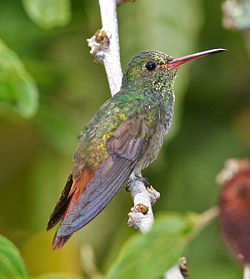
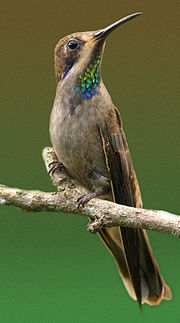
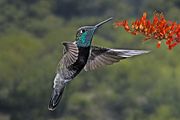
Hummingbird
Hummingbird
Hummingbirds are birds that comprise the family Trochilidae. They are among the smallest of birds, most species measuring in the 7.5–13 cm range. Indeed, the smallest extant bird species is a hummingbird, the 5-cm Bee Hummingbird. They can hover in mid-air by rapidly flapping their wings...
s are small birds capable of hovering in mid-air due to the rapid flapping of their wings. They are the only birds that can fly backwards. There are 337 species worldwide and 39 species which occur in Guatemala.
- White-necked JacobinWhite-necked JacobinThe White-necked Jacobin is a large and attractive hummingbird that ranges from Mexico south to Peru, Bolivia and south Brazil...
Florisuga mellivora - Band-tailed BarbthroatBand-tailed BarbthroatThe Band-tailed Barbthroat is a medium-sized hummingbird which is a resident breeder from southeastern Guatemala and Belize to western Ecuador and western Venezuela....
Threnetes ruckeri - Long-billed HermitLong-billed HermitThe Long-billed Hermit is a large hummingbird that is a resident breeder from central Mexico south to northwestern Colombia, extreme western Venezuela and western Ecuador...
Phaethornis longirostris - Stripe-throated HermitStripe-throated HermitThe Stripe-throated Hermit is a species of hummingbird from Central America and north-western South America. It is generally fairly common and considered Least Concern by BirdLife International....
Phaethornis striigularis - Brown Violetear Colibri delphinae
- Green Violetear Colibri thalassinus
- Purple-crowned FairyPurple-crowned FairyThe Purple-crowned Fairy is a large hummingbird that breeds in the lowlands and hills from southeastern Mexico south to southwestern Ecuador....
Heliothryx barroti - Green-breasted MangoGreen-breasted MangoThe Green-breasted Mango is a hummingbird from tropical America. The scientific name of this bird commemorates the French naturalist Florent Prévost.- Description :...
Anthracothorax prevostii - Black-crested CoquetteBlack-crested CoquetteThe Black-Crested Coquette is a species of hummingbird in the Trochilidae family.It is found in Belize, Costa Rica, Guatemala, Honduras, Mexico, and Nicaragua....
Lophornis helenae - Magnificent HummingbirdMagnificent HummingbirdThe Magnificent Hummingbird is a large hummingbird that breeds in mountains from the southwestern United States to western Panama. It is the only member of the genus Eugenes, although the northern, nominate subspecies E. fulgens fulgens has on occasion been separated from the larger, southern race...
Eugenes fulgens - Long-billed StarthroatLong-billed StarthroatThe Long-billed Starthroat, Heliomaster longirostris, is a hummingbird that breeds from southern Mexico to Panama, from Colombia south and east to Bolivia and Brazil, and on Trinidad...
Heliomaster longirostris - Plain-capped StarthroatPlain-capped StarthroatThe Plain-capped Starthroat, Heliomaster constantii, is a large-sized hummingbird. It is 11-12 cm long, and weighs approximately 7-8 g.Adults are colored predominantly metallic bronze on their upper-parts, tail, back and crown. The bird has a dark eye-stripe with a white stripe above and below. ...
Heliomaster constantii - Green-throated Mountain-gemGreen-throated Mountain-gemThe Green-throated Mountaingem is a species of hummingbird in the Trochilidae family.It is found in El Salvador, Guatemala, Honduras, and Mexico.Its natural habitat is subtropical or tropical moist montanes.-References:...
Lampornis viridipallens - Amethyst-throated HummingbirdAmethyst-throated HummingbirdThe Amethyst-Throated Mountaingem or Amethyst-Throated Hummingbird is a species of hummingbird in the Trochilidae family.It is found in El Salvador, Guatemala, Honduras, and Mexico....
Lampornis amethystinus - Garnet-throated HummingbirdGarnet-throated HummingbirdThe Garnet-throated Hummingbird is a species of hummingbird in the Trochilidae family. It is found in El Salvador, Guatemala, Honduras, and Mexico. It is in the monotypical genus Lamprolaima....
Lamprolaima rhami - Slender SheartailSlender SheartailThe Slender Sheartail is a species of hummingbird in the Trochilidae family.It is found in El Salvador, Guatemala, Honduras, and Mexico....
Doricha enicura - Sparkling-tailed HummingbirdSparkling-tailed HummingbirdThe Sparkling-tailed Woodstar , also known as the Sparkling-Tailed Hummingbird, is a species of hummingbird in the Trochilidae family. It is found in Costa Rica, El Salvador, Guatemala, Honduras, Mexico, and Nicaragua...
Tilmatura dupontii - Ruby-throated HummingbirdRuby-throated HummingbirdThe Ruby-throated Hummingbird , is a small hummingbird. It is the only species of hummingbird that regularly nests east of the Mississippi River in North America.- Description :...
Archilochus colubris - Wine-throated HummingbirdWine-throated HummingbirdThe Wine-Throated Hummingbird is a species of hummingbird in the Trochilidae family.It is found in El Salvador, Guatemala, Honduras, and Mexico.Its natural habitats are subtropical or tropical moist montane forests....
Atthis ellioti - Broad-tailed HummingbirdBroad-tailed HummingbirdThe Broad-tailed hummingbird, Selasphorus platycercus, is a medium-sized hummingbird, nearly in length.Male and female both have iridescent green backs and crowns and a white breast. The male has a gorget that shines with a brilliant red iridescence...
Selasphorus platycercus - Rufous HummingbirdRufous HummingbirdThe Rufous Hummingbird is a small hummingbird, about 8 cm long with a long, straight and very slender bill. The female is slightly larger than the male.-Description:...
Selasphorus rufus - Canivet's Emerald Chlorostilbon canivetii
- Emerald-chinned HummingbirdEmerald-chinned HummingbirdThe Emerald-chinned Hummingbird is a species of hummingbird in the Trochilidae family. It is found in Belize, El Salvador, Guatemala, Honduras, Mexico, and Nicaragua. Its natural habitats are subtropical or tropical moist montanes and heavily degraded former forest....
Abeillia abeillei - Scaly-breasted HummingbirdScaly-breasted HummingbirdThe Scaly-breasted Hummingbird is a species of hummingbird in the Trochilidae family. It is monotypic for its genus.-Distribution and habitat:...
Phaeochroa cuvierii - Wedge-tailed SabrewingWedge-tailed SabrewingThe Wedge-tailed Sabrewing is a species of hummingbird in the Trochilidae family.It is found in Belize, Guatemala, Honduras, and Mexico....
Campylopterus curvipennis - Rufous SabrewingRufous SabrewingThe Rufous Sabrewing is a species of hummingbird in the Trochilidae family.It is found in El Salvador, Guatemala, and Mexico.Its natural habitats are subtropical or tropical moist montanes and heavily degraded former forest....
Campylopterus rufus - Violet SabrewingViolet SabrewingThe Violet Sabrewing, Campylopterus hemileucurus,is a very large hummingbird native to southern Mexico and Central America as far south as Costa Rica and western Panama....
Campylopterus hemileucurus - Violet-crowned WoodnymphViolet-crowned WoodnymphThe Violet-crowned Woodnymph , also known as the Purple-crowned Woodnymph, is a medium-sized hummingbird found from Guatemala and Belize to northern Colombia and western Venezuela. It formerly included the Mexican and Green-crowned Woodnymphs as subspecies...
Thalurania colombica - Stripe-tailed HummingbirdStripe-tailed HummingbirdThe Stripe-tailed Hummingbird is a species of hummingbird endemic to subtropical moist forests and adjacent clearings of Middle America, from the Gulf slope of southeastern Mexico to Panama....
Eupherusa eximia - White-bellied EmeraldWhite-bellied EmeraldThe White-Bellied Emerald is a species of hummingbird in the Trochilidae family.It is found in Belize, Costa Rica, Guatemala, Honduras, Mexico, and Nicaragua....
Amazilia candida - Azure-crowned HummingbirdAzure-crowned HummingbirdThe Azure-Crowned Hummingbird is a species of hummingbird in the Trochilidae family.It is found in Belize, El Salvador, Guatemala, Honduras, Mexico, and Nicaragua....
Amazilia cyanocephala - Berylline HummingbirdBerylline HummingbirdThe Berylline Hummingbird, Amazilia beryllina, sometimes placed in the genus Saucerottia, is a medium-sized hummingbird. It is 8-10 cm long, and weighs 4-5 g.- Overview :...
Amazilia beryllina - Blue-tailed HummingbirdBlue-tailed HummingbirdThe Blue-tailed Hummingbird , sometimes placed in the genus Saucerottia, is a species of hummingbird in the Trochilidae family.It is found in Costa Rica, El Salvador, Guatemala, Honduras, Mexico, and Nicaragua....
Amazilia cyanura - Rufous-tailed HummingbirdRufous-tailed HummingbirdThe Rufous-tailed Hummingbird is a medium-sized hummingbird that breeds from east-central Mexico, through Central America and Colombia, east to western Venezuela and south through western Ecuador to near the border with Peru...
Amazilia tzacatl - Buff-bellied HummingbirdBuff-bellied HummingbirdThe Buff-bellied Hummingbird, Amazilia yucatanensis, is a medium-sized hummingbird. It is long and has a mass of .Adults are a metallic olive green above and buffy in the lower breast. The tail and primary wings are rufous in color and slightly forked. The underwing is white. The bill of the male...
Amazilia yucatanensis - Cinnamon HummingbirdCinnamon HummingbirdThe Cinnamon Hummingbird is a species of hummingbird in the Trochilidae family.It is found from northwestern Mexico to Costa Rica....
Amazilia rutila - Green-fronted HummingbirdGreen-fronted HummingbirdThe Green-fronted Hummingbird is a species of hummingbird in the Trochilidae family.-Taxonomy:It includes the subspecies wagneri, which sometimes is considered a separate species, the Cinnamon-sided Hummingbird .-Distribution and habitat:It is found in Belize and Mexico...
Amazilia viridifrons - Blue-throated GoldentailBlue-throated GoldentailThe Blue-throated Sapphire , also known as the Blue-Throated Goldentail, is a species of hummingbird in the Trochilidae family. It is found in Belize, Colombia, Costa Rica, El Salvador, Guatemala, Honduras, Mexico, Nicaragua, and Panama...
Hylocharis eliciae - White-eared HummingbirdWhite-eared HummingbirdThe White-eared Hummingbird, Basilinna leucotis , is a medium-sized hummingbird. It is 9-10 cm long, and weighs approximately 3-4 g.- Overview :...
Hylocharis leucotis
Trogons and Quetzals
Order: Trogoniformes. Family: TrogonidaeThe family Trogonidae includes trogons and quetzals. Found in tropical woodlands worldwide, they feed on insects and fruit, and their broad bills and weak legs reflect their diet and arboreal habits. Although their flight is fast, they are reluctant to fly any distance. Trogons have soft, often colourful, feathers with distinctive male and female plumage. There are 33 species worldwide and 7 species which occur in Guatemala.
- Resplendent QuetzalResplendent QuetzalThe Resplendent Quetzal, Pharomachrus mocinno, is a bird in the trogon family. It is found from southern Mexico to western Panama . It is well known for its colorful plumage. There are two subspecies, P. m. mocinno and P. m...
Pharomachrus mocinno Near-threatened - Slaty-tailed TrogonSlaty-tailed TrogonThe Slaty-tailed Trogon, Trogon massena, is a near passerine bird in the trogon family, Trogonidae. It breeds in lowlands from southeastern Mexico south through Central America, to Colombia, and a small region of northwestern Ecuador....
Trogon massena - Black-headed TrogonBlack-headed TrogonThe Black-headed Trogon is a species of bird in the Trogonidae family.It is found in Belize, Costa Rica, El Salvador, Guatemala, Honduras, Mexico, and Nicaragua....
Trogon melanocephalus - Gartered TrogonGartered TrogonThe Gartered Trogon , also known as the Northern Violaceous Trogon, is a near passerine bird in the trogon family, Trogonidae. It is found in forests in east-central Mexico, south through Central America, to north-western South America...
Trogon caligatus - Elegant TrogonElegant TrogonThe Elegant Trogon, Trogon elegans , is a near passerine bird in the trogon family. It breeds from southeasternmost Arizona in the United States to northwestern Costa Rica. It occasionally is found as a vagrant in southeasternmost and western Texas.It is a resident of the lower levels of semi-arid...
Trogon elegans - Mountain TrogonMountain TrogonThe Mountain Trogon is a species of bird in the family Trogonidae. It breeds in Guatemala, Honduras, and Mexico. In El Salvador, it is only present as a vagrant nowadays; its only local breeding population is in the Cordillera Nahuaterique which was ceded to Honduras in 1992 .Its natural habitat...
Trogon mexicanus - Collared TrogonCollared TrogonThe Collared Trogon, Trogon collaris, is a near passerine bird in the trogon family, Trogonidae. It is found in the warmer parts of the Neotropics, and includes numerous subspecies, including T. c...
Trogon collaris
Motmots
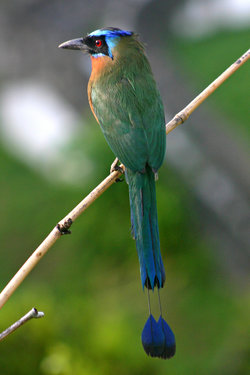
Coraciiformes
The Coraciiformes are a group of usually colorful near passerine birds including the kingfishers, the Hoopoe, the bee-eaters, the rollers, and the hornbills...
. Family: Momotidae
The motmots have colorful plumage and long, graduated tails, which they display by waggling back and forth. In most of the species, the barbs near the ends of the two longest (central) tail feathers are weak and fall off, leaving a length of bare shaft, and creating a racket-shaped tail. There are 10 species worldwide and 7 species which occur in Guatemala.
- Tody MotmotTody MotmotThe Tody Motmot is a species of bird in the Momotidae family. It is monotypic within the genus Hylomanes.It is found in Belize, Colombia, Costa Rica, El Salvador, Guatemala, Honduras, Mexico, Nicaragua, and Panama....
Hylomanes momotula - Blue-throated MotmotBlue-throated MotmotThe Blue-throated Motmot is a species of bird in the Momotidae family. It is monotypic within the genus Aspatha.It is found in El Salvador, Guatemala, Honduras, and Mexico....
Aspatha gularis - Russet-crowned MotmotRusset-crowned MotmotThe Russet-crowned Motmot is a species of bird in the Momotidae family.It is found in Guatemala and Mexico.Its natural habitats are subtropical or tropical dry forests, subtropical or tropical moist lowland forests, and heavily degraded former forest.-References:* BirdLife International 2004. . ...
Momotus mexicanus - Keel-billed MotmotKeel-billed MotmotThe Keel-billed Motmot is a species of bird in the Momotidae family.It is found in Belize, Costa Rica, Guatemala, Honduras, Mexico, and Nicaragua....
Electron carinatum Vulnerable - Broad-billed MotmotBroad-billed MotmotThe Broad-billed Motmot is a species of bird in the Momotidae family.It is found in Bolivia, Brazil, Colombia, Costa Rica, Ecuador, Honduras, Nicaragua, Panama, and Peru. Its natural habitats are subtropical or tropical moist lowland forests and heavily degraded former forest.-References:*...
Electron platyrhynchum - Turquoise-browed MotmotTurquoise-browed MotmotThe Turquoise-browed Motmot also called Torogoz by the inhabitants of El Salvador and Guardabarranco in Nicaragua; is a colourful, medium-sized bird of the motmot family, Momotidae. It inhabits Central America from south-east Mexico , to Costa Rica, where it is common and not considered threatened...
Eumomota superciliosa
Kingfishers
Order: CoraciiformesCoraciiformes
The Coraciiformes are a group of usually colorful near passerine birds including the kingfishers, the Hoopoe, the bee-eaters, the rollers, and the hornbills...
. Family: Alcedinidae
Kingfishers are medium-sized birds with large heads, long pointed bills, short legs, and stubby tails. There are 93 species worldwide and 5 species which occur in Guatemala.
- Ringed KingfisherRinged KingfisherThe Ringed Kingfisher is a large, conspicuous and noisy kingfisher, commonly found along the lower Rio Grande River valley in southeasternmost Texas in the United States through Central America to Tierra del Fuego in South America....
Megaceryle torquata - Belted KingfisherBelted KingfisherThe Belted Kingfisher is a large, conspicuous water kingfisher, the only member of that group commonly found in the northern United States and Canada. It is depicted on the 1986 series Canadian $5 note. All kingfishers were formerly placed in one family, Alcedinidae, but recent research suggests...
Megaceryle alcyon - Amazon KingfisherAmazon KingfisherThe Amazon Kingfisher, Chloroceryle amazona, is a resident breeding bird in the lowlands of the American tropics from southern Mexico south through Central America to northern Argentina, with at least one bird having strayed north to Texas. Records from Trinidad are thought to be erroneous.This...
Chloroceryle amazona - Green KingfisherGreen KingfisherThe Green Kingfisher, Chloroceryle americana, is a resident breeding bird which occurs from southern Texas in the USA south through Central and South Americal to central Argentina....
Chloroceryle americana - American Pygmy KingfisherAmerican Pygmy KingfisherThe American Pygmy Kingfisher, Chloroceryle aenea, is a resident breeding bird which occurs in the American tropics from southern Mexico south through Central America to western Ecuador, and then around the northern Andes cordillera in the east to central Bolivia and central Brazil...
Chloroceryle aenea
Puffbirds
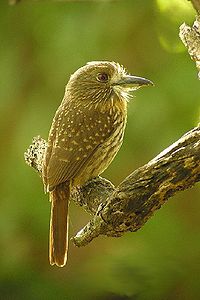
The puffbirds are related to the jacamars, and have the same range, but lack the iridescent colours of that family. They are mainly brown, rufous or grey, with large heads and flattened bills with a hooked tip. The loose abundant plumage and short tails makes them look stout and puffy, giving rise to the English common name of the family. There are 34 species and 2 species which occur in Guatemala.
- White-necked PuffbirdWhite-necked PuffbirdThe White-necked Puffbird is a species of puffbird in the Bucconidae family.It is found in forest and woodland from southern Mexico, through Central America, to the Chocó, northern Colombia , northern Venezuela, and the western and southern Amazon Basin.It was formerly considered a subspecies of N...
Notharchus hyperrhynchus - White-whiskered PuffbirdWhite-whiskered PuffbirdThe White-whiskered Puffbird is a bird which is a resident breeding species from southeastern Mexico to central Ecuador. It is sometimes known as White-whiskered Softwing....
Malacoptila panamensis
Jacamars
Order: Galbuliformes. Family: GalbulidaeThe jacamars are near passerine birds from tropical South America, with a range that extends up to Mexico. They are glossy elegant birds with long bills and tails, which feed on insects caught on the wing. In appearance and behaviour they show resemblances to the Old World bee-eaters, although they are more closely related to woodpeckers. There are 18 species and 1 species that occur in Guatemala.
- Rufous-tailed JacamarRufous-tailed JacamarThe Rufous-tailed Jacamar, Galbula ruficauda, is a near-passerine bird which breeds in the tropical New World in southern Mexico, Central America and South America as far south as southern Brazil and Ecuador....
Galbula ruficauda
Toucans
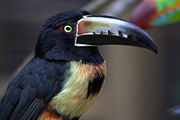
Piciformes
Nine families of largely arboreal birds make up the order Piciformes, the best-known of them being the Picidae, which includes the woodpeckers and close relatives...
. Family: Ramphastidae
Toucans are near passerine birds from the neotropics. They are brightly marked and have enormous, colourful bills which in some species may amount to half their body length. There are 40 species worldwide and 3 species which occur in Guatemala.
- Emerald ToucanetEmerald ToucanetThe Emerald Toucanet, Aulacorhynchus prasinus, is a near-passerine bird occurring in mountainous regions from Mexico, through Central America, to northern Venezuela and along the Andes as far south as central Bolivia...
Aulacorhynchus prasinus - Collared AracariCollared AracariThe Collared Aracari, Pteroglossus torquatus, is a toucan, a near-passerine bird which breeds from southern Mexico to Panama; also Ecuador, Colombia and Venezuela.-Description:...
Pteroglossus torquatus - Keel-billed ToucanKeel-billed ToucanThe Keel-billed Toucan , also known as Sulfur-breasted Toucan or Rainbow-billed Toucan, is a colorful Latin American member of the toucan family. It is the national bird of Belize.- Description :...
Ramphastos sulfuratus
Woodpeckers and allies

Piciformes
Nine families of largely arboreal birds make up the order Piciformes, the best-known of them being the Picidae, which includes the woodpeckers and close relatives...
. Family: Picidae
Picidae
The woodpeckers, piculets and wrynecks are a family, Picidae, of near-passerine birds. Members of this family are found worldwide, except for Australia and New Zealand, Madagascar, and the extreme polar regions...
Woodpeckers are small to medium sized birds with chisel like beaks, short legs, stiff tails and long tongues used for capturing insects. Some species have feet with two toes pointing forward, and two backward, while several species have only three toes. Many woodpeckers have the habit of tapping noisily on tree trunks with their beaks. There are 218 species worldwide and 13 species which occur in Guatemala.
- Olivaceous PiculetOlivaceous PiculetThe Olivaceous Piculet is a species of bird in the Picidae family. Etymologically, piculet is as a double diminutive of the Latin picus woodpecker, see also Picus...
Picumnus olivaceus - Acorn WoodpeckerAcorn WoodpeckerThe Acorn woodpecker is a medium-sized woodpecker, 21 cm long with an average weight of 85 g.-Description:...
Melanerpes formicivorus - Black-cheeked WoodpeckerBlack-cheeked WoodpeckerThe Black-cheeked Woodpecker, Melanerpes pucherani, is a resident breeding bird from southeastern Mexico south to western Ecuador.This woodpecker occurs in the higher levels of wet forests, semi-open woodland and old second growth. It nests in an unlined hole 6–30 m high in a dead tree. The clutch...
Melanerpes pucherani - Golden-fronted WoodpeckerGolden-fronted WoodpeckerThe Golden-fronted Woodpecker, Melanerpes aurifrons, is a North American woodpecker. Its preferred habitat is mesquite and riparian woodlands. It is distributed from Texas and Oklahoma in the United States through Mexico to Honduras and northern Nicaragua...
Melanerpes aurifrons - Yellow-bellied SapsuckerYellow-bellied SapsuckerThe Yellow-bellied Sapsucker is a medium-sized woodpecker found in North America, Central America and the Caribbean.-Taxonomy:...
Sphyrapicus varius - Ladder-backed WoodpeckerLadder-backed WoodpeckerThe Ladder-backed Woodpecker is a North American woodpecker.-Range and habitat:The Ladder-backed Woodpecker is fairly common in dry brushy areas and thickets and has a rather large range...
Picoides scalaris - Smoky-brown WoodpeckerSmoky-brown WoodpeckerThe Smoky-brown Woodpecker or Brown Woodpecker is a species of bird in the Picidae family.It is found in Argentina, Belize, Bolivia, Colombia, Costa Rica, Ecuador, El Salvador, Guatemala, Honduras, Mexico, Nicaragua, Panama, Peru, and Venezuela.-Habitat:Its natural habitats are subtropical or...
Picoides fumigatus - Hairy WoodpeckerHairy WoodpeckerThe Hairy Woodpecker is a medium-sized woodpecker, averaging approximately 250 mm in length with a 380 mm wingspan...
Picoides villosus - Golden-olive WoodpeckerGolden-olive WoodpeckerThe Golden-olive Woodpecker, Colaptes rubiginosus, is a resident breeding bird from Mexico south and east to Guyana, northwest Argentina, Trinidad and Tobago. It was formerly placed in the genus Piculus...
Colaptes rubiginosus - Northern FlickerNorthern FlickerThe Northern Flicker is a medium-sized member of the woodpecker family. It is native to most of North America, parts of Central America, Cuba, the Cayman Islands, and is one of the few woodpecker species that migrate. There are over 100 common names for the Northern Flicker...
Colaptes auratus - Cinnamon WoodpeckerCinnamon WoodpeckerThe Cinnamon Woodpecker is a species of bird in the Picidae family.It is found in Colombia, Costa Rica, Ecuador, Nicaragua, and Panama. Its natural habitat is subtropical or tropical moist lowland forests.-References:...
Celeus loricatus - Chestnut-colored Woodpecker Celeus castaneus
- Lineated WoodpeckerLineated WoodpeckerThe Lineated Woodpecker is a very large woodpecker which is a resident breeding bird from Mexico south to northern Argentina and on Trinidad.-Description:The Lineated Woodpecker is long...
Dryocopus lineatus - Pale-billed WoodpeckerPale-billed WoodpeckerThe Pale-billed Woodpecker is a very large woodpecker that is a resident breeding bird from northern Mexico to western Panama.-Habitat:...
Campephilus guatemalensis
Ovenbirds
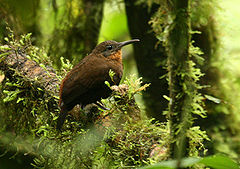
Ovenbirds comprise a large family of small sub-oscine passerine bird species found in Central and South America. They are a diverse group of insectivores which gets its name from the elaborate "oven-like" clay nests built by some species, although others build stick nests or nest in tunnels or clefts in rock. There are 243 species worldwide and 8 species which occur in Guatemala.
- Tawny-throated LeaftosserTawny-throated LeaftosserThe Tawny-throated Leaftosser is a tropical American bird species in the ovenbird family Furnariidae. It is also known as the Tawny-throated Leafscraper, Mexican Leaftosser or Mexican Leafscraper...
Sclerurus mexicanus - Scaly-throated LeaftosserScaly-throated LeaftosserThe Scaly-throated Leaftosser is a species of bird in the Furnariidae family.It is found in Belize, Colombia, Costa Rica, Ecuador, Guatemala, Honduras, Mexico, Nicaragua, and Panama. Its natural habitats are subtropical or tropical moist lowland forests and subtropical or tropical moist montane...
Sclerurus guatemalensis - Rufous-breasted SpinetailRufous-breasted SpinetailThe Rufous-breasted Spinetail is a species of bird in the Furnariidae family.It is found in Belize, El Salvador, Guatemala, Honduras, and Mexico....
Synallaxis erythrothorax - Scaly-throated Foliage-gleanerScaly-throated Foliage-gleanerThe Scaly-throated Foliage-gleaner is a species of bird in the Furnariidae family.It is found in Belize, Colombia, Costa Rica, Ecuador, El Salvador, Guatemala, Honduras, Mexico, and Panama....
Anabacerthia variegaticeps - Buff-fronted Foliage-gleanerBuff-fronted Foliage-gleanerThe Buff-fronted Foliage-gleaner is a species of bird in the Furnariidae family, the ovenbirds. It is found in southeastern regions of South America in the cerrado and pantanal of Brazil and Paraguay as well as areas of southeast coastal Brazil; also extreme northeast Argentina...
Philydor rufum - Buff-throated Foliage-gleanerBuff-throated Foliage-gleanerThe Buff-throated Foliage-gleaner is a species of bird in the Furnariidae family.It is found in Belize, Bolivia, Brazil, Colombia, Costa Rica, Ecuador, French Guiana, Guatemala, Guyana, Honduras, Mexico, Nicaragua, Panama, Peru, Suriname, and Venezuela...
Automolus ochrolaemus - Plain XenopsPlain XenopsThe Plain Xenops, Xenops minutus, is a passerine bird which breeds in moist lowland forests in the tropical New World from southern Mexico south to western Ecuador, northeastern Argentina and central Brazil....
Xenops minutus - Tawny-winged WoodcreeperTawny-winged WoodcreeperThe Tawny-winged Woodcreeper is a species of bird in the Dendrocolaptinae subfamily, New World woodcreepers.It is found in Belize, Costa Rica, Guatemala, Honduras, Mexico, Nicaragua, and Panama....
Dendrocincla anabatina - Ruddy WoodcreeperRuddy WoodcreeperThe Ruddy Woodcreeper , is a passerine bird which breeds in the tropical New World from southern Mexico to northern Colombia and extreme northern Venezuela....
Dendrocincla homochroa - Olivaceous WoodcreeperOlivaceous WoodcreeperThe Olivaceous Woodcreeper is a passerine bird of the tropical Americas. It belongs to the true woodcreepers of the ovenbird family ....
Sittasomus griseicapillus - Wedge-billed WoodcreeperWedge-billed WoodcreeperThe Wedge-billed Woodcreeper , is a passerine bird which breeds in the tropical New World from southern Mexico to northern Bolivia, central Brazil and the Guianas; it is absent from the Pacific coastal areas except between Costa Rica and Ecuador...
Glyphorynchus spirurus - Strong-billed WoodcreeperStrong-billed WoodcreeperThe Strong-billed Woodcreeper is a species of bird in the Dendrocolaptinae subfamily.It is one of the largest woodcreepers and the largest furnariids, though the slender Long-billed Woodcreeper is longer and the Great Rufous Woodcreeper is larger overall...
Xiphocolaptes promeropirhynchus - Northern Barred-WoodcreeperNorthern Barred-woodcreeperThe Northern Barred-woodcreeper is a species of bird in the Dendrocolaptinae subfamily. It was formerly included as a subspecies of the Amazonian Barred-woodcreeper ....
Dendrocolaptes sanctithomae - Black-banded WoodcreeperBlack-banded WoodcreeperThe Black-banded Woodcreeper is a species of bird in the Dendrocolaptinae subfamily, the woodcreepers.It is found in Argentina, Bolivia, Brazil, Colombia, Costa Rica, Ecuador, French Guiana, Guatemala, Guyana, Honduras, Mexico, Panama, Paraguay, Peru, Suriname, and Venezuela.In South America it is...
Dendrocolaptes picumnus - Cocoa WoodcreeperCocoa WoodcreeperThe Cocoa Woodcreeper is a passerine bird which breeds in tropical Central and South America in Trinidad, Tobago, northern Colombia and northern Venezuela. It was formerly considered a subspecies of the Buff-throated Woodcreeper .It is typically 23 cm long, and weighs 37 g...
Xiphorhynchus susurrans - Buff-throated WoodcreeperBuff-throated WoodcreeperThe Buff-throated Woodcreeper is a resident passerine bird found in tropical South America in the Guiana Shield and disjunctly in the northern Atlantic Forest. It formerly included the Cocoa Woodcreeper and the Lafresnaye's Woodcreeper as subspecies...
Xiphorhynchus guttatus - Ivory-billed WoodcreeperIvory-billed WoodcreeperThe Ivory-billed Woodcreeper is a species of bird in the Dendrocolaptinae subfamily.It is found in Belize, Costa Rica, El Salvador, Guatemala, Honduras, Mexico, and Nicaragua....
Xiphorhynchus flavigaster - Spotted WoodcreeperSpotted WoodcreeperThe Spotted Woodcreeper is a species of bird in the Dendrocolaptinae subfamily. It is found in Belize, Colombia, Costa Rica, Ecuador, El Salvador, Guatemala, Honduras, Mexico, Nicaragua, and Panama....
Xiphorhynchus erythropygius - Streak-headed WoodcreeperStreak-headed WoodcreeperThe Streak-headed Woodcreeper , is a passerine bird which breeds in the tropical New World from southern Mexico to northwestern Peru, northern Brazil and Guyana, and on Trinidad....
Lepidocolaptes souleyetii - Spot-crowned WoodcreeperSpot-crowned WoodcreeperThe Spot-crowned Woodcreeper , is a passerine bird which breeds in the tropical New World from central Mexico in the east, the Sierra Madre Orientals, to northern Panama....
Lepidocolaptes affinis
Typical antbirds
Order: Passeriformes. Family: ThamnophilidaeThe antbirds are a large family of small passerine birds of subtropical and tropical Central and South America. They are forest birds, and tend to feed on insects at or near the ground. A sizable minority of them specialize in following columns of army ants to eat the small invertebrates that leave hiding to flee the ants.Many species lack bright colour; brown, black and white being the dominant tones. There are about 212 species worldwide and 9 species which occur in Guatemala.
- Great AntshrikeGreat AntshrikeThe Great Antshrike, Taraba major, is a passerine bird in the antbird family. It is the only member of the genus Taraba-....
Taraba major - Barred AntshrikeBarred AntshrikeThe Barred Antshrike, Thamnophilus doliatus, is a passerine bird in the antbird family. It is found in the Neotropics from Tamaulipas, Mexico, through Central America, Trinidad and Tobago, and a large part of South America east of the Andes as far south as northern Argentina, Bolivia and Paraguay....
Thamnophilus doliatus - Western Slaty-AntshrikeWestern Slaty-AntshrikeThe Western Slaty-Antshrike is a species of bird in the Thamnophilidae family.It is found in from western Ecuador, western Colombia, western Venezuela, and Central America as far north as Belize....
Thamnophilus atrinucha - Russet AntshrikeRusset AntshrikeThe Russet Antshrike, Thamnistes anabatinus, is a passerine bird in the antbird family. It is the only member of the genus Thamnistes.It is a resident breeder in the tropical New World from southern Mexico to northern Bolivia....
Thamnistes anabatinus - Plain AntvireoPlain AntvireoThe Plain Antvireo, Dysithamnus mentalis, is a passerine bird species in the antbird family , wherein it belongs to the antshrike subfamily . It is a resident breeder in tropical Central and South America....
Dysithamnus mentalis - Slaty AntwrenSlaty AntwrenThe Slaty Antwren, Myrmotherula schisticolor, is a small passerine bird in the antbird family. It is a resident breeder in tropical Central and South America from southern Mexico to western Ecuador and eastern Peru....
Myrmotherula schisticolor - Dot-winged AntwrenDot-winged AntwrenThe Dot-winged Antwren is a passerine bird in the antbird family. In the past it was sometimes known as the Velvety Antwren, and some of its more distinctive subspecies have their own infrequently used English names...
Microrhopias quixensis - Dusky AntbirdDusky AntbirdThe Dusky Antbird or Tyrannine Antbird, Cercomacra tyrannina, is a passerine bird in the antbird family. It is a resident breeder in tropical Central and South America from southeastern Mexico southwards to western Ecuador, and Amazonian Brazil....
Cercomacra tyrannina - Bare-crowned AntbirdBare-crowned AntbirdThe Bare-crowned Antbird is a species of bird in the Thamnophilidae family in the monotypic genus Gymnocichla.It is found in Belize, Colombia, Costa Rica, Guatemala, Honduras, Mexico, Nicaragua, and Panama....
Gymnocichla nudiceps
Antpittas
Order: Passeriformes. Family: GrallariidaeAntpittas resemble the true pittas
Pitta (bird)
Pittas are a family, Pittidae, of passerine birds mainly found in tropical Asia and Australasia, although a couple of species live in Africa. Pittas are all similar in general structure and habits, and have often been placed in a single genus, although as of 2009 they are now split into three...
with longish strong legs, very short tails and stout bills. There are about 32 species worldwide and 1 species which occurs in Guatemala.
- Scaled AntpittaScaled AntpittaThe Scaled Antpitta is a species of bird tentatively placed in the family Formicariidae; it might belong to a more distinct lineage though....
Grallaria guatimalensis
Tyrant flycatchers
Order: Passeriformes. Family: TyrannidaeTyrant flycatcher
Tyrant flycatcher
The tyrant flycatchers are a family of passerine birds which occur throughout North and South America. They are considered the largest family of birds on Earth, with more than 400 species. They are the most diverse avian family in every country in the Americas, except for the United States and...
s are passerine
Passerine
A passerine is a bird of the order Passeriformes, which includes more than half of all bird species. Sometimes known as perching birds or, less accurately, as songbirds, the passerines form one of the most diverse terrestrial vertebrate orders: with over 5,000 identified species, it has roughly...
birds which occur throughout North and South America. They superficially resemble the Old World flycatchers, but are more robust with stronger bills. They do not have the sophisticated vocal capabilities of the songbirds. Most, but not all, have plain colouring. As the name implies, most are insectivorous. There are 429 species worldwide, all found only in the Americas and 69 species which occur in Guatemala.
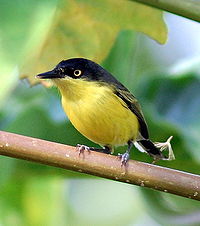
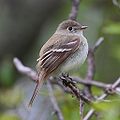
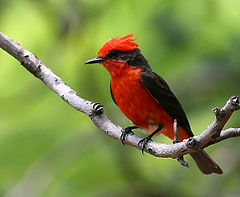
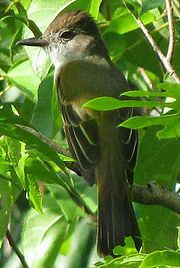
- Yellow-bellied TyrannuletYellow-bellied TyrannuletThe Yellow-bellied Tyrannulet is a species of bird in the Tyrannidae family.It is found in Belize, Costa Rica, Guatemala, Honduras, Mexico, and Nicaragua....
Ornithion semiflavum - Northern Beardless-Tyrannulet Camptostoma imberbe
- Greenish ElaeniaGreenish ElaeniaThe Greenish Elaenia is a species of bird in the Tyrannidae family, the tyrant flycatchers.It is found in Argentina, Belize, Bolivia, Brazil, Colombia, Costa Rica, Ecuador, El Salvador, Guatemala, Guyana, Honduras, Mexico, Nicaragua, Panama, Paraguay, Peru, the United States, and Venezuela.Its...
Myiopagis viridicata - Yellow-bellied ElaeniaYellow-bellied ElaeniaThe Yellow-bellied Elaenia, Elaenia flavogaster, is a small bird of the tyrant flycatcher family. It breeds from southern Mexico and the Yucatán Peninsula through Central and South America as far as northern Argentina, and on Trinidad and Tobago....
Elaenia flavogaster - Mountain ElaeniaMountain ElaeniaThe Mountain Elaenia, Elaenia frantzii, is a small passerine bird in the tyrant flycatcher family. It breeds in highlands from Guatemala to Colombia and western Venezuela. The scientific name celebrates the German physician and naturalist, Alexander von Frantzius.This tyrant flycatcher is 14-15...
Elaenia frantzii - Ochre-bellied FlycatcherOchre-bellied FlycatcherThe Ochre-bellied Flycatcher, Mionectes oleagineus, is a small bird of the tyrant flycatcher family. It breeds from southern Mexico through Central America, and South America east of the Andes as far as southern Brazil, and on Trinidad and Tobago....
Mionectes oleagineus - Sepia-capped FlycatcherSepia-capped FlycatcherThe Sepia-capped Flycatcher is a species of bird in the Tyrannidae family.It is found in Argentina, Belize, Bolivia, Brazil, Colombia, Costa Rica, Ecuador, French Guiana, Guatemala, Guyana, Honduras, Mexico, Nicaragua, Panama, Paraguay, Peru, Suriname, and Venezuela...
Leptopogon amaurocephalus - Paltry Tyrannulet Zimmerius vilissimus
- Northern BentbillNorthern BentbillThe Northern Bentbill is a species of bird in the Tyrannidae family.It is found in Belize, Colombia, Costa Rica, El Salvador, Guatemala, Honduras, Mexico, Nicaragua, and Panama....
Oncostoma cinereigulare - Slate-headed Tody-FlycatcherSlate-headed Tody-flycatcherThe Slaty-headed Tody-Flycatcher is a species of bird in the Tyrannidae family.It is found in Belize, Brazil, Colombia, Costa Rica, French Guiana, Guatemala, Guyana, Honduras, Mexico, Nicaragua, Panama, and Venezuela...
Poecilotriccus sylvia - Common Tody-FlycatcherCommon Tody-FlycatcherThe Common Tody-Flycatcher or Black-fronted Tody-Flycatcher, Todirostrum cinereum, is a very small passerine bird in the tyrant flycatcher family. It breeds from southern Mexico to northwestern Peru, eastern Bolivia and southern Brazil....
Todirostrum cinereum - Eye-ringed FlatbillEye-ringed FlatbillThe Eye-ringed Flatbill is a species of bird in the Tyrannidae family.It is found in Belize, Colombia, Costa Rica, El Salvador, Guatemala, Honduras, Mexico, Nicaragua, and Panama....
Rhynchocyclus brevirostris - Yellow-olive FlycatcherYellow-olive FlycatcherThe Yellow-olive Flatbill or Yellow-olive Flycatcher is a species of bird in the Tyrannidae family. It is found in tropical and subtopical forest and woodland in Central and South America, but over its range there are significant variations in plumage, iris-colour and voice, leading to...
Tolmomyias sulphurescens - Stub-tailed SpadebillStub-tailed SpadebillThe Stub-tailed Spadebill is a species of bird in the Tyrannidae family.It is found in Belize, Costa Rica, El Salvador, Guatemala, Honduras, Mexico, Nicaragua, and Panama....
Platyrinchus cancrominus - Royal FlycatcherRoyal FlycatcherThe Royal Flycatchers are birds in the genus Onychorhynchus in the tyrant flycatcher family. Depending on authority, it includes a single widespread, or four more localized species...
Onychorhynchus coronatus - Ruddy-tailed FlycatcherRuddy-tailed FlycatcherThe Ruddy-tailed Flycatcher, Terenotriccus erythrurus, is a small passerine bird in the tyrant flycatcher family. It breeds in lowlands from southeastern Mexico to northern Bolivia, north-central Brazil and the Guianas...
Terenotriccus erythrurus - Sulphur-rumped FlycatcherSulphur-rumped FlycatcherThe Sulphur-rumped Myiobius or Sulphur-rumped Flycatcher is a species of bird in the Tyrannidae family.It is found in Belize, Colombia, Costa Rica, Ecuador, Guatemala, Honduras, Mexico, Nicaragua, and Panama....
Myiobius sulphureipygius - Whiskered Flycatcher Myiobius barbatus
- Belted FlycatcherBelted FlycatcherThe Belted Flycatcher is a species of bird in the Tyrannidae family.It is found in El Salvador, Guatemala, and Mexico.Its natural habitat is subtropical or tropical dry forests.It is threatened by habitat loss.-Source:...
Xenotriccus callizonus Near-threatened - Pileated FlycatcherPileated FlycatcherThe Pileated Flycatcher is a species of bird in the Tyrannidae family.It is endemic to Mexico.Its natural habitat is subtropical or tropical high-altitude shrubland.It is threatened by habitat loss.- Source :...
Xenotriccus mexicanus Near-threatened - Tufted FlycatcherTufted FlycatcherThe Northern Tufted Flycatcher, Mitrephanes phaeocercus, is a small passerine bird in the tyrant flycatcher family. It breeds in highlands from northwestern Mexico to northwestern Ecuador...
Mitrephanes phaeocercus - Olive-sided FlycatcherOlive-sided FlycatcherThe Olive-sided Flycatcher, Contopus cooperi, is a passerine bird. It is a medium-sized tyrant flycatcher.- Description :Adults are dark olive on the face, upperparts and flanks. They have light underparts, a large dark bill and a short tail....
Contopus cooperi Near-threatened - Greater PeweeGreater PeweeThe Greater Pewee, Contopus pertinax, is a passerine bird. It is a medium-sized tyrant flycatcher.Adults are dark olive on the face, upperparts and flanks. They have dull gray underparts, a large dark bill and a short tail...
Contopus pertinax - Western Wood-Pewee Contopus sordidulus
- Eastern Wood-Pewee Contopus virens
- Tropical PeweeTropical PeweeThe Tropical Pewee, Contopus cinereus, is a small passerine bird in the tyrant flycatcher family. It breeds from southern Mexico and Trinidad south to Bolivia and Argentina...
Contopus cinereus - Yellow-bellied FlycatcherYellow-bellied FlycatcherThe Yellow-bellied Flycatcher is a small insect-eating bird of the tyrant flycatcher family.Adults have brownish-olive upperparts, darker on the wings and tail, with yellowish underparts; they have a white eye ring, white wing bars, a small bill and a short tail...
Empidonax flaviventris - Acadian FlycatcherAcadian FlycatcherThe Acadian Flycatcher is a small insect-eating bird of the tyrant flycatcher family.- Description :Adults have olive upperparts, darker on the wings and tail, with whitish underparts; they have a white eye ring, white wing bars and a wide bill. The breast is washed with olive. The upper part of...
Empidonax virescens - Alder FlycatcherAlder FlycatcherThe Alder Flycatcher, Empidonax alnorum, is a small insect-eating bird of the tyrant flycatcher family.Adults have olive-brown upperparts, browner on the wings and tail, with whitish underparts; they have a white eye ring, white wing bars, a small bill and a short tail. The breast is washed with...
Empidonax alnorum - Willow FlycatcherWillow FlycatcherThe Willow Flycatcher is a small insect-eating bird of the tyrant flycatcher family.Adults have brown-olive upperparts, darker on the wings and tail, with whitish underparts; they have an indistinct white eye ring, white wing bars and a small bill. The breast is washed with olive-grey. The upper...
Empidonax traillii - White-throated FlycatcherWhite-throated FlycatcherThe White-throated Flycatcher is a species of bird in the Tyrannidae family.It is found in Belize, Costa Rica, El Salvador, Guatemala, Honduras, Mexico, Nicaragua, and Panama....
Empidonax albigularis - Least FlycatcherLeast FlycatcherThe Least Flycatcher , , is a small insect-eating bird...
Empidonax minimus - Hammond's FlycatcherHammond's FlycatcherHammond's Flycatcher, Empidonax hammondii is a small insect-eating bird. It is a small Empidonax flycatcher, with typical size ranging from 12.5-14.5 cm....
Empidonax hammondii - Dusky FlycatcherDusky FlycatcherThe American Dusky Flycatcher, or simply Dusky Flycatcher, is a small, insectivorous passerine of the tyrant flycatcher family....
Empidonax oberholseri (A) - Pine FlycatcherPine FlycatcherThe Pine Flycatcher is a species of bird in the Tyrannidae family, the tyrant flycatchers.It is found in the montane tropical and subtropical coniferous forests of Mexico and southwestern Guatemala. Possible sightings of a vagrant bird were recorded in Choke Canyon State Park in southern Texas in...
Empidonax affinis - Pacific-slope FlycatcherPacific-slope FlycatcherThe Pacific-slope Flycatcher is a small insectivorous bird of the family Tyrannidae. It is native to coastal regions of western North America, including the Pacific Ocean and the southern Sea of Cortez, as far north as British Columbia and southern Alaska, but is replaced in the inland regions by...
Empidonax difficilis - Cordilleran FlycatcherCordilleran FlycatcherThe Cordilleran Flycatcher, Empidonax occidentalis, is a small insect-eating bird. It is a small Empidonax flycatcher, with typical length ranging from 13 to 17 cm....
Empidonax occidentalis - Yellowish FlycatcherYellowish FlycatcherThe Yellowish Flycatcher, Empidonax flavescens, is a small passerine bird in the tyrant flycatcher family. It breeds in highlands from southeastern Mexico south to western Panama....
Empidonax flavescens - Buff-breasted FlycatcherBuff-breasted FlycatcherThe Buff-breasted Flycatcher, Empidonax fulvifrons, is a small insectivorous bird. It is the smallest Empidonax flycatcher, typically ranging from 11.5 to 13 cm in size....
Empidonax fulvifrons - Black PhoebeBlack PhoebeThe Black Phoebe, Sayornis nigricans, is a passerine bird in the tyrant-flycatcher family. It breeds from southwest Oregon and California south through Central and South America. It occurs year-round throughout most of its range and migrates less than the other birds in its genus, though its...
Sayornis nigricans - Vermilion FlycatcherVermilion FlycatcherThe Vermilion Flycatcher is a small passerine bird in the Tyrannidae, or tyrant flycatcher family. Most flycatchers are rather drab, but the Vermilion Flycatcher is a striking exception...
Pyrocephalus rubinus - Bright-rumped AttilaBright-rumped AttilaThe Bright-rumped Attila or Polymorphic Attila, Attila spadiceus, is a small passerine bird in the tyrant flycatcher family...
Attila spadiceus - Rufous MournerRufous MournerThe Rufous Mourner, Rhytipterna holerythra, is a small passerine bird in the tyrant flycatcher family. It breeds from southwestern Mexico to northwestern Ecuador...
Rhytipterna holerythra - Yucatan FlycatcherYucatan FlycatcherThe Yucatan Flycatcher is a species of bird in the Tyrannidae family.It is found in Belize, Guatemala, and Mexico.Its natural habitats are subtropical or tropical dry forests and heavily degraded former forest....
Myiarchus yucatanensis - Dusky-capped FlycatcherDusky-capped FlycatcherThe Dusky-capped Flycatcher, Myiarchus tuberculifer, is a passerine bird in the tyrant flycatcher family. It breeds in forest and other woodland from southern Arizona, as well as the Chisos Mountains, Texas, south to northern Argentina and on Trinidad...
Myiarchus tuberculifer - Ash-throated FlycatcherAsh-throated FlycatcherThe Ash-throated Flycatcher, Myiarchus cinerascens, is a passerine bird in the tyrant flycatcher family. It breeds in desert scrub, riparian forest, brushy pastures and open woodland from the western United States to central Mexico. It is a short-distance migrant, retreating from most of the U.S....
Myiarchus cinerascens - Nutting's FlycatcherNutting's FlycatcherNutting's Flycatcher, Myiarchus nuttingi, is a passerine bird in the tyrant flycatcher family. It breeds in semi-arid desert scrub and tropical deciduous forest from western Mexico to northwest Costa Rica...
Myiarchus nuttingi - Great Crested FlycatcherGreat Crested FlycatcherThe Great Crested Flycatcher is a large insect-eating bird of the tyrant flycatcher family. It is the most widespread member of the genus, Myiarchus, in North America and is found over most of the eastern and mid-western portions of the continent...
Myiarchus crinitus - Brown-crested FlycatcherBrown-crested FlycatcherThe Brown-crested Flycatcher is a passerine bird in the tyrant flycatcher family. It breeds in open woodland from southern California, southern Nevada, central Arizona, and southern Texas southward to Argentina and Bolivia, and on Trinidad and Tobago...
Myiarchus tyrannulus - Great KiskadeeGreat KiskadeeThe Great Kiskadee, Pitangus sulphuratus, is a passerine bird. It is a large tyrant flycatcher; sometimes its genus Pitangus is considered monotypic, with the Lesser Kiskadee The Great Kiskadee, Pitangus sulphuratus, is a passerine bird. It is a large tyrant flycatcher; sometimes its genus Pitangus...
Pitangus sulphuratus - Boat-billed FlycatcherBoat-billed FlycatcherThe Boat-billed Flycatcher is a passerine bird. It is a large tyrant flycatcher, the only member, monotypic, of the genus Megarynchus....
Megarynchus pitangua - Social FlycatcherSocial FlycatcherThe Social Flycatcher and Vermilion-crowned Flycatcher are passerine birds from the Americas, a member of the large tyrant flycatcher family ....
Myiozetetes similis - Streaked FlycatcherStreaked FlycatcherThe Streaked Flycatcher, Myiodynastes maculatus, is a passerine bird in the tyrant flycatcher family. It breeds from eastern Mexico, Trinidad and Tobago south to Bolivia and Argentina. The southern subspecies M. m...
Myiodynastes maculatus - Sulphur-bellied FlycatcherSulphur-bellied FlycatcherThe Sulphur-bellied Flycatcher, Myiodynastes luteiventris, is a large Tyrant flycatcher. This bird breeds from southeasternmost Arizona of the United States-, to Costa Rica...
Myiodynastes luteiventris - Piratic FlycatcherPiratic FlycatcherThe Piratic Flycatcher, Legatus leucophaius, is a passerine bird, the only member of the genus Legatus. It is a resident breeder from southern Mexico and Trinidad south to Bolivia and Argentina...
Legatus leucophaius - Tropical KingbirdTropical KingbirdThe Tropical Kingbird is a large tyrant flycatcher. This bird breeds from southern Arizona and the lower Rio Grande Valley of Texas in the USA through Central America, South America as far as south as central Argentina and western Peru, and on Trinidad and Tobago...
Tyrannus melancholicus - Couch's KingbirdCouch's KingbirdThe Couch's Kingbird, Tyrannus couchii, is a passerine tyrant flycatcher of the kingbird genus. It is found from southern Texas along the Gulf Coast to the Yucatan Peninsula in Mexico, Belize and northern Guatemala...
Tyrannus couchii - Cassin's KingbirdCassin's KingbirdThe Cassin's Kingbird, Tyrannus vociferans, is a large Tyrant flycatcher.Adults have a gray head with slightly darker cheeks; a dark unforked tail with a buffy fringe and gray-olive underparts.They have a pale throat and deep yellow lower breast....
Tyrannus vociferans - Thick-billed KingbirdThick-billed KingbirdThe Thick-billed Kingbird, Tyrannus crassirostris, is a large bird in the Tyrannidae family, the tyrant flycatchers. This bird breeds from southeastern Arizona, extreme southwestern New Mexico, and northern Sonora, , in the United States and Mexico, through western and western-coastal Mexico,...
Tyrannus crassirostris (A) - Western KingbirdWestern KingbirdThe Western Kingbird is a large tyrant flycatcher.Adults are grey-olive on the upperparts with a grey head and a dark line through the eyes; the underparts are light becoming light orange-yellow on the lower breast and belly. They have a long black tail with white outer feathers...
Tyrannus verticalis - Eastern KingbirdEastern KingbirdThe Eastern Kingbird, Tyrannus tyrannus, is a large Tyrant flycatcher.Adults are grey-black on the upperparts with light underparts; they have a long black tail with a white end and long pointed wings. They have a red patch on their crown, seldom seen...
Tyrannus tyrannus - Scissor-tailed FlycatcherScissor-tailed FlycatcherThe Scissor-tailed Flycatcher is a long-tailed insectivorous bird of the genus, whose members are collectively referred to as kingbirds. The kingbirds are a group of large insectivorous birds in the tyrant flycatcher family...
Tyrannus forficatus - Fork-tailed FlycatcherFork-tailed FlycatcherThe Fork-tailed Flycatcher, Tyrannus savana, is a passerine bird of the tyrant flycatcher family, and is the member of a genus typically referred to as kingbirds.-Description and ecology:...
Tyrannus savana
Cotingas
Order: Passeriformes. Family: CotingidaeThe cotingas are birds of forests or forest edges of tropical South America. Comparatively little is known about this diverse group, although all have broad bills with hooked tips, rounded wings, and strong legs. The males of many of the species are brightly coloured, or decorated with plumes or wattles. There are 71 species worldwide and 2 species which occur in Guatemala
- Lovely CotingaLovely CotingaThe Lovely Cotinga is a species of bird in the Cotingidae family. It is found in Central America from southern Mexico through Guatemala, Belize, Honduras and Nicaragua to Costa Rica with reports from western Panama...
Cotinga amabilis - Rufous PihaRufous PihaThe Rufous Piha is a species of bird in the Cotingidae family.It is found in Belize, Colombia, Costa Rica, Ecuador, Guatemala, Honduras, Mexico, Nicaragua, and Panama....
Lipaugus unirufus
Manakins
Order: Passeriformes. Family: PipridaeThe manakins are a family bird species of subtropical and tropical mainland Central and South America, and Trinidad and Tobago. They are compact forest birds, the males typically being brightly coloured, although the females of most species are duller and usually green-plumaged. Manakins feed on small fruits, berries and insects. There are 57 species worldwide and 5 species which occur in Guatemala.
- White-collared ManakinWhite-collared ManakinThe White-collared Manakin, Manacus candei, is a passerine bird in the manakin family. It is a resident breeder in the tropical New World from southeastern Mexico to Costa Rica and the extreme west of Panama....
Manacus candei - Long-tailed ManakinLong-tailed ManakinThe Long-tailed Manakin is a species of bird in the Pipridae family. It is found in Costa Rica, El Salvador, Guatemala, Honduras, Mexico, and Nicaragua....
Chiroxiphia linearis - Red-capped ManakinRed-capped ManakinThe Red-capped Manakin is a species of bird in the Pipridae family.It is found in Belize, Colombia, Costa Rica, Ecuador, Guatemala, Honduras, Mexico, Nicaragua, Peru and Panama....
Pipra mentalis - Gray-headed Piprites Piprites griseiceps
Tityras and allies***
Order: Passeriformes. Family: TityridaeTityridae
Tityridae is family of suboscine passerine birds found in forest and woodland in the Neotropics. The approximately 30 species in this family were formerly spread over the families Tyrannidae, Pipridae and Cotingidae . As yet, no widely accepted common name exists for the family, although Tityras...
Tityridae are suboscine passerine
Passerine
A passerine is a bird of the order Passeriformes, which includes more than half of all bird species. Sometimes known as perching birds or, less accurately, as songbirds, the passerines form one of the most diverse terrestrial vertebrate orders: with over 5,000 identified species, it has roughly...
birds found in forest and woodland in the Neotropics. The species in this family were formerly spread over the families Tyrannidae, Pipridae and Cotingidae. They are small to medium-sized birds. They do not have the sophisticated vocal capabilities of the songbirds. Most, but not all, have plain colouring. As the name implies, most are insectivorous. There are 30 species worldwide, all found only in the Americas and 8 species which occur in Guatemala.

- Black-crowned TityraBlack-crowned TityraThe Black-crowned Tityra is a medium-sized passerine bird. It has traditionally been placed in the cotinga or the tyrant flycatcher family, but evidence strongly suggest it is better placed in Tityridae, where now placed by SACC....
Tityra inquisitor - Masked TityraMasked TityraThe Masked Tityra is a medium-sized passerine bird. It has traditionally been placed in the cotinga or the tyrant flycatcher family, but evidence strongly suggest it is better placed in Tityridae, where now placed by SACC...
Tityra semifasciata - Thrush-like SchiffornisThrush-like SchiffornisThe Thrush-like Schiffornis , also called Thrush-like Mourner or Thrush-like Manakin, is a species of Neotropical bird.-Distribution and habitat:...
Schiffornis turdina - Speckled MournerSpeckled MournerThe Speckled Mourner is a species of bird in the Tityridae family. It has traditionally been placed in the cotinga family, but evidence strongly suggest it is better placed in Tityridae, where now placed by SACC....
Laniocera rufescens - Cinnamon BecardCinnamon BecardThe Cinnamon Becard, Pachyramphus cinnamomeus, is a passerine bird which is a resident breeding species from southeastern Mexico south to northwestern Ecuador and northwestern Venezuela. It was recently found to be far more common on the Amazonian slope of the Colombian Cordillera Oriental than...
Pachyramphus cinnamomeus - White-winged BecardWhite-winged BecardThe White-winged Becard is a species of bird in the Tityridae family. It has traditionally been placed in Cotingidae or Tyrannidae, but evidence strongly suggest it is better placed in Tityridae. where now placed by SACC...
Pachyramphus polychopterus - Gray-collared Becard Pachyramphus major
- Rose-throated BecardRose-throated BecardThe Rose-throated Becard is a medium-sized member of the Tityridae family. Its genus, Pachyramphus, has traditionally been placed in Cotingidae or Tyrannidae, but evidence strongly suggest it is better placed in Tityridae....
Pachyramphus aglaiae
Vireos
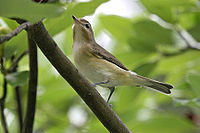
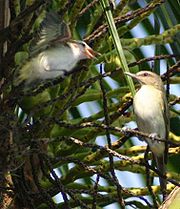
The vireo
Vireo
The vireos are a group of small to medium-sized passerine birds restricted to the New World. They are typically dull-plumaged and greenish in color, the smaller species resembling wood warblers apart from their heavier bills...
s are a group of small to medium sized passerine birds restricted to the New World. They are typically greenish in colour and resemble wood warbler
Wood Warbler
The Wood Warbler is a common and widespread leaf warbler which breeds throughout northern and temperate Europe, and just into the extreme west of Asia in the southern Ural Mountains...
s apart from their heavier bills. There are 52 species worldwide and 20 species which occur in Guatemala.
- White-eyed VireoWhite-eyed VireoThe White-eyed Vireo, Vireo griseus, is a small songbird. It breeds in the southeastern USA from New Jersey west to northern Missouri and south to Texas and Florida, and also in eastern Mexico, northern Central America, Cuba and the Bahamas....
Vireo griseus - Mangrove VireoMangrove VireoThe Mangrove Vireo is a species of bird in the Vireonidae family.It is found in Belize, Costa Rica, El Salvador, Guatemala, Honduras, Mexico, and Nicaragua....
Vireo pallens - Bell's VireoBell's VireoThe Bell's Vireo is a small North American songbird. It is 4-3/4 to 5 inches in length, dull olive-gray above and whitish below...
Vireo bellii Near-threatened - Yellow-throated VireoYellow-throated VireoThe Yellow-throated Vireo, Vireo flavifrons, is a small American songbird.Adults are mainly olive on the head and upperparts with a yellow throat and white belly; they have dark eyes with yellow "spectacles". The tail and wings are dark with white wing bars...
Vireo flavifrons - Plumbeous VireoPlumbeous VireoThe Plumbeous Vireo is a small North American songbird, ranging from far southeastern Montana and western South Dakota south to the Pacific coast of Mexico, including the extreme southern regions of Baja California Sur...
Vireo plumbeus - Cassin's VireoCassin's VireoCassin's Vireo is a small North American songbird, ranging from southern British Columbia in Canada through the western coastal states of the United States. This bird migrates, spending the winter from southern Arizona to southern Mexico.The vireo is 11–14 cm in length, with a gray head, back,...
Vireo cassinii - Blue-headed VireoBlue-headed VireoThe Blue-headed Vireo is a Neotropical migrating song bird found in North and Central America. There are currently two recognized sub-species that belong to the Blue-headed Vireo. It has a range that extends across Canada and the eastern coast of the United-States, Mexico and some of Central America...
Vireo solitarius - Hutton's VireoHutton's VireoHutton's Vireo is a small songbird. It is approximately 5 inches in length, dull olive-gray above and below. It has a faint white eye ring and faint white wing bars. It closely resembles a Ruby-crowned Kinglet, but has a thicker bill and is slightly larger in size. Its most common song is a...
Vireo huttoni - Warbling VireoWarbling VireoThe Warbling Vireo, Vireo gilvus, is a small North American songbird.Its breeding habitat is open deciduous and mixed woods from Alaska to Mexico and the Florida Panhandle. It often nests along streams. It migrates to Mexico and Central America....
Vireo gilvus - Brown-capped VireoBrown-capped VireoThe Brown-capped Vireo, Vireo leucophrys, is a small passerine bird. It breeds in highlands from southern Mexico south to northwestern Bolivia. It is sometimes considered to be conspecific with the similar Warbling Vireo....
Vireo leucophrys - Philadelphia VireoPhiladelphia VireoThe Philadelphia Vireo, Vireo philadelphicus, is a small songbird.Adults are mainly olive-brown on the upperparts with yellow underparts; they have dark eyes and a grey crown. There is a dark line through the eyes and a white stripe just over them. They have thick blue-grey legs and a stout...
Vireo philadelphicus - Red-eyed VireoRed-eyed VireoThe Red-eyed Vireo, Vireo olivaceus, is a small American songbird, 13–14 cm in length. It is somewhat warbler-like but not closely related to the New World warblers...
Vireo olivaceus - Yellow-green VireoYellow-green VireoThe Yellow-green Vireo, Vireo flavoviridis, is a small passerine bird. It breeds from southern Texas in the United States and the western and eastern mountain ranges of northern Mexico south to central Panama...
Vireo flavoviridis - Black-whiskered VireoBlack-whiskered VireoThe Black-whiskered Vireo, Vireo altiloquus, is a small passerine bird, which breeds in southern Florida, USA, and the West Indies as far south as the offshore islands of Venezuela. It is a partial migrant, with northern birds wintering from the Greater Antilles to northern South America...
Vireo altiloquus - Yucatan VireoYucatan VireoThe Yucatan Vireo is a species of bird in the Vireonidae family.It is found in Belize, Honduras and Mexico. There is a well-documented record from High Island, Texas, in 1984, but this is the only record for the United States....
Vireo magister - Tawny-crowned GreenletTawny-crowned GreenletThe Tawny-crowned Greenlet is a species of bird in the Vireonidae family. It is found in Belize, Bolivia, Brazil, Colombia, Costa Rica, Ecuador, French Guiana, Guatemala, Guyana, Honduras, Mexico, Nicaragua, Panama, Peru, Suriname, and Venezuela.Its natural habitat is subtropical or tropical moist...
Hylophilus ochraceiceps - Lesser GreenletLesser GreenletThe Lesser Greenlet, Hylophilus decurtatus, is a small passerine bird in the vireo family. It breeds from northeastern Mexico south to western Ecuador....
Hylophilus decurtatus - Chestnut-sided Shrike-VireoChestnut-sided Shrike-vireoThe Chestnut-sided Shrike-vireo is a species of bird in the Vireonidae family. It is found in Guatemala and Mexico. Its natural habitat is subtropical or tropical moist montane forests.-References:...
Vireolanius melitophrys - Green Shrike-VireoGreen Shrike-vireoThe Green Shrike-vireo is a species of bird in the Vireonidae family.It is found in Belize, Colombia, Costa Rica, El Salvador, Guatemala, Honduras, Mexico, Nicaragua, and Panama....
Vireolanius pulchellus - Rufous-browed PeppershrikeRufous-browed PeppershrikeThe Rufous-browed Peppershrike, Cyclarhis gujanensis, is a passerine bird in the vireo family. It is widespread and often common in woodland, forest edge, and cultivation with some tall trees from Mexico and Trinidad south to Argentina and Uruguay....
Cyclarhis gujanensis
Crows, jays, ravens and magpies
Order: Passeriformes. Family: CorvidaeCorvidae
Corvidae is a cosmopolitan family of oscine passerine birds that contains the crows, ravens, rooks, jackdaws, jays, magpies, treepies, choughs and nutcrackers. The common English names used are corvids or the crow family , and there are over 120 species...

Crow
Crows form the genus Corvus in the family Corvidae. Ranging in size from the relatively small pigeon-size jackdaws to the Common Raven of the Holarctic region and Thick-billed Raven of the highlands of Ethiopia, the 40 or so members of this genus occur on all temperate continents and several...
s, raven
Raven
Raven is the common name given to several larger-bodied members of the genus Corvus—but in Europe and North America the Common Raven is normally implied...
s, jay
Jay
The jays are several species of medium-sized, usually colorful and noisy, passerine birds in the crow family Corvidae. The names jay and magpie are somewhat interchangeable, and the evolutionary relationships are rather complex...
s, chough
Chough
The Red-billed Chough or Chough , Pyrrhocorax pyrrhocorax, is a bird in the crow family; it is one of only two species in the genus Pyrrhocorax...
s, magpie
Magpie
Magpies are passerine birds of the crow family, Corvidae.In Europe, "magpie" is often used by English speakers as a synonym for the European Magpie, as there are no other magpies in Europe outside Iberia...
s, treepie
Treepie
The treepies comprise four closely related genera of long-tailed passerine birds in the family Corvidae...
s, nutcracker
Nutcracker (bird)
The nutcrackers are a genus of two species of passerine bird, in the family Corvidae, related to the jays and crows. One, the Spotted Nutcracker , occurs in Europe and Asia, the other, Clark's Nutcracker , in western North America.The most important food resources for both these species are the...
s, and ground jay
Ground jay
The ground jays or ground choughs belong to a distinct group of the passerine order of birds in the genus Podoces of the crow family Corvidae...
s. Corvids are above average in size for the bird order Passeriformes. Some of the larger species show high levels of learning behavior. There are 120 species worldwide and 10 species which occur in Guatemala.
- Black-throated JayBlack-throated JayThe Black-throated Jay is a species of bird in the Corvidae family.It is found in El Salvador, Guatemala, Honduras, and Mexico.Its natural habitat is subtropical or tropical moist montanes.-References:...
Cyanolyca pumilo - Azure-hooded JayAzure-hooded JayThe Azure-hooded Jay, Cyanolyca cucullata, is a species of bird in the Corvidae family. It is found in Middle America. Its natural habitat is subtropical or tropical moist montane forest. This species is known to have four subspecies. It is in length and is dark blue with a black head and upper...
Cyanolyca cucullata - White-throated Magpie-JayWhite-throated Magpie-jayThe White-throated Magpie-Jay, Calocitta formosa, is a large Central American jay species. It ranges in Pacific-slope thornforest from Jalisco, Mexico to Guanacaste, Costa Rica. Magpie-jays are noisy, gregarious birds, often traveling in easy-to-find flocks, mobbing their...
Calocitta formosa - Brown JayBrown JayThe Brown Jay is a large American Jay which has the habitus of a magpie, but is slightly smaller and with a shorter tail, though the bill is larger.It occurs from Mexico south into Central America on the Gulf slope...
Psilorhinus morio - Green JayGreen JayThe Green Jay is a bird species of the New World jays, which exhibits distinct regional variations within its large but discontinuous range...
Cyanocorax yncas - Bushy-crested JayBushy-crested JayThe Bushy-crested Jay is a species of bird in the Corvidae family. It is found in El Salvador, Guatemala, Honduras, and Nicaragua. Its natural habitats are subtropical or tropical moist montanes and heavily degraded former forest.-References:* BirdLife International 2004. . Downloaded on 25...
Cyanocorax melanocyaneus - Yucatan JayYucatan JayThe Yucatán Jay is a species of bird in the Corvidae family, the crows and their allies.It is found in Belize, Guatemala, and southern Mexico....
Cyanocorax yucatanicus - Steller's JaySteller's JayThe Steller's Jay is a jay native to western North America, closely related to the Blue Jay found in the rest of the continent, but with a black head and upper body. It is also known as the Long-crested Jay, Mountain Jay, and Pine Jay...
Cyanocitta stelleri - Unicolored JayUnicolored JayThe Unicolored Jay is an Aphelocoma jay native to cloud forests of northwestern Central America and southern and southeastern Mexico, from central Honduras west to central Guerrero, southern Veracruz and extreme southern San Luis Potosi...
Aphelocoma unicolor - Common RavenCommon RavenThe Common Raven , also known as the Northern Raven, is a large, all-black passerine bird. Found across the northern hemisphere, it is the most widely distributed of all corvids...
Corvus corax
Swallows and martins
Order: Passeriformes. Family: HirundinidaeThe Hirundinidae family is a group of passerines characterized by their adaptation to aerial feeding. Their adaptations include a slender streamlined body, long pointed wings and short bills with wide gape. The feet are designed for perching rather than walking, and the front toes are partially joined at the base. There are 75 species worldwide and 14 species which occur in Guatemala.
- Black-capped SwallowBlack-capped SwallowThe Black-capped Swallow is a species of bird in the Hirundinidae family.It is found in El Salvador, Guatemala, Honduras, and Mexico....
Atticora pileata - Northern Rough-winged SwallowNorthern Rough-winged SwallowThe Northern Rough-winged Swallow is a small swallow.Adults are 13–15 cm in length, brown on top with light underparts and a forked tail. They are similar in appearance to the Bank Swallow but have a dusky throat and breast...
Stelgidopteryx serripennis - Southern Rough-winged SwallowSouthern Rough-winged SwallowThe Southern Rough-winged Swallow , Stelgidopteryx ruficollis, is a small swallow. It was first formally described as Hirundo ruficollis by French ornithologist Louis Vieillot in 1817 in his Nouveau Dictionnaire d'Histoire Naturelle....
Stelgidopteryx ruficollis - Purple MartinPurple MartinThe Purple Martin is the largest North American swallow. These aerial acrobats have speed and agility in flight, and when approaching their housing, will dive from the sky at great speeds with their wings tucked.-Description and taxonomy:...
Progne subis - Cuban MartinCuban MartinThe Cuban Martin, Progne cryptoleuca, is a large swallow endemic to Cuba.It is closely related to the Caribbean Martin, P. dominicensis which breeds on Caribbean islands from Jamaica east to Tobago, and the P. d...
Progne cryptoleuca (A) - Caribbean MartinCaribbean MartinThe Caribbean Martin or White-bellied Martin, Progne dominicensis, is a large swallow.It breeds on Caribbean islands from Jamaica east to Tobago. It is closely related to 2 species to which it formerly was considered conspecific-P. sinaloae and P. cryptoleuca...
Progne dominicensis - Sinaloa MartinSinaloa MartinThe Sinaloa Martin is a species of bird in the Hirundinidae family.It breeds semicolonially in sheer cliff faces within pine-oak forests of the Sierra Madre Occidental of western Mexico. Presumed migrant records also come from Belize and Guatemala. It is assumed to winter in South America....
Progne sinaloae Data deficient - Gray-breasted MartinGray-breasted MartinThe Gray-breasted Martin, Progne chalybea, is a large swallow.The nominate race P. c. chalybea breeds from Mexico through Central America south to central Brazil, and on Trinidad. P. c. macrorhamphus breeds further south in South America to central Argentina...
Progne chalybea - Tree SwallowTree SwallowThe Tree Swallow, Tachycineta bicolor, is a migratory passerine bird that breeds in North America and winters in Mexico, Central America and the Caribbean. It is a very rare vagrant to western Europe....
Tachycineta bicolor - Mangrove SwallowMangrove SwallowThe Mangrove Swallow, Tachycineta albilinea, is a passerine bird that breeds in coastal regions from Mexico through Central America to Panama. It is non-migratory, but may make seasonal movements....
Tachycineta albilinea - Violet-green SwallowViolet-green SwallowThe Violet-green Swallow, Tachycineta thalassina, is a small North American swallow.Their breeding habitat is semi-open areas in western North America from Alaska to Mexico...
Tachycineta thalassina - Bank Swallow Riparia riparia
- Barn SwallowBarn SwallowThe Barn Swallow is the most widespread species of swallow in the world. It is a distinctive passerine bird with blue upperparts, a long, deeply forked tail and curved, pointed wings. It is found in Europe, Asia, Africa and the Americas...
Hirundo rustica - Cliff SwallowCliff SwallowThe Cliff Swallow is a member of the passerine bird family Hirundinidae — the swallows and martins.It breeds in North America, and is migratory, wintering in western South America from Venezuela southwards to northeast Argentina...
Petrochelidon pyrrhonota
Long-tailed tits

Long-tailed tits are a group of small passerine birds with medium to long tails. They make woven bag nests in trees. Most eat a mixed diet that includes insects. There are 9 species worldwide and1 species which occurs in Guatemala.
- BushtitBushtitThe Bushtit is a long-tailed tit found in North America. It is the only species in the family found in the New World, and the only member of the genus Psaltriparus....
Psaltriparus minimus
Treecreepers
Order: Passeriformes. Family: CerthiidaeTreecreepers are small woodland birds, brown above and white below. They have thin pointed down-curved bills, which they use to extricate insects from bark. They have stiff tail feathers, like woodpeckers, which they use to support themselves on vertical trees. There are 6 species worldwide and1 species which occurs in Guatemala.
- Brown CreeperBrown Creeper-Description:Adults are brown on the upperparts with light spotting, resembling a piece of tree bark, with white underparts. They have a long thin bill with a slight downward curve and a long tail. The male creeper has a slightly larger bill than the female...
Certhia americana
Wrens

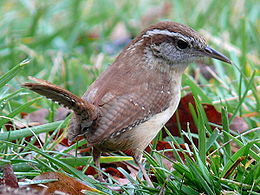
The wren
Wren
The wrens are passerine birds in the mainly New World family Troglodytidae. There are approximately 80 species of true wrens in approximately 20 genera....
s are mainly small and inconspicuous except for their loud songs. These birds have short wings and a thin down-turned bill. Several species often hold their tails upright. All are insectivorous. There are 80 species worldwide (of which all but one are New World species) and 15 species which occur in Guatemala.
- Band-backed WrenBand-backed WrenThe Band-backed Wren, Campylorhynchus zonatus, is a small songbird of the wren family.The Band-backed Wren is a resident breeding species from south-central Gulf Coast Mexico to northwestern Ecuador. It occurs in five disjunct areas, the central region being in southern Central America, in Costa...
Campylorhynchus zonatus - Rufous-naped WrenRufous-naped WrenThe Rufous-naped Wren, Campylorhynchus rufinucha, is a songbird of the Troglodytidae family, the wrens. It is a resident breeding species from central-southwest Mexico to northwestern Costa Rica....
Campylorhynchus rufinucha - Rock WrenRock WrenThe Rock Wren is a small songbird of the wren family. It is the only species in the genus Salpinctes.The 12 cm long adults have grey-brown upperparts with small black and white spots and pale grey underparts with a light brown rump...
Salpinctes obsoletus - Spot-breasted WrenSpot-breasted WrenThe Spot-breasted Wren is a species of bird in the Troglodytidae family.It is found in Belize, Costa Rica, El Salvador, Guatemala, Honduras, Mexico, and Nicaragua....
Pheugopedius maculipectus - Banded WrenBanded WrenThe Banded Wren, Pheugopedius pleurostictus, is a small songbird of the wren family. It is a resident breeding species from central Mexico to Costa Rica. It was formerly placed in the genus Thryothorus ....
Thryophilus pleurostictus - Rufous-and-white WrenRufous-and-white WrenThe Rufous-and-white Wren, Thryophilus rufalbus, is a small songbird of the wren family. It is a resident breeding species from southwesternmost Mexico to northern Colombia and northwestern Venezuela...
Thryophilus rufalbus - Plain WrenPlain WrenThe Plain Wren is a species of bird in the Troglodytidae family.It is found in Belize, Costa Rica, El Salvador, Guatemala, Honduras, Mexico, Nicaragua, and Panama....
Cantorchilus modestus - Carolina WrenCarolina WrenThe Carolina Wren is a common species of wren, resident in the eastern half of the USA, the extreme south of Ontario, Canada, and the extreme northeast of Mexico...
Thryothorus ludovicianus - House WrenHouse WrenThe House Wren, Troglodytes aedon, is a very small songbird of the wren family, Troglodytidae. It occurs from Canada to southernmost South America, and is thus the most widely distributed bird in the Americas. It occurs in most suburban areas in its range and it is the single most common wren...
Troglodytes aedon - Rufous-browed WrenRufous-browed WrenThe Rufous-browed Wren is a species of bird in the Troglodytidae family. It is found in El Salvador, Guatemala, Honduras, Mexico, and Nicaragua. Its natural habitat is subtropical or tropical moist montane forests....
Troglodytes rufociliatus - Sedge WrenSedge WrenThe Sedge Wren, Cistothorus platensis, is a small songbird of the Wren family. It was formerly known as the Short-billed Marsh Wren, and in South America is known as the Grass Wren. There are about 20 different subspecies which are found across most of the Americas...
Cistothorus platensis - White-bellied WrenWhite-bellied WrenThe White-bellied Wren is a species of bird in the Troglodytidae family. It is monotypic within the genus Uropsila.It is found in Belize, Guatemala, Honduras, and Mexico....
Uropsila leucogastra - White-breasted Wood-WrenWhite-breasted Wood-WrenThe White-breasted Wood-Wren, Henicorhina leucosticta, is a small songbird of the wren family. It is a resident breeding species from central Mexico to northeastern Peru and Surinam.-Description:...
Henicorhina leucosticta - Gray-breasted Wood-Wren Henicorhina leucophrys
- Nightingale Wren Microcerculus philomela
Gnatcatchers
Order: Passeriformes. Family: Polioptilidae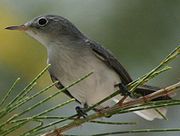
- Long-billed GnatwrenLong-billed GnatwrenThe Long-billed Gnatwren is a very small bird in the gnatcatcher family. It is the only member of the genus Ramphocaenus ....
Ramphocaenus melanurus - Blue-gray GnatcatcherBlue-gray GnatcatcherThe Blue-gray Gnatcatcher, Polioptila caerulea, is a very small songbird.Adult males are blue-grey on the upperparts with white underparts and have a long slender bill, long black tail and an angry black unibrow. Females are less blue without the unibrow...
Polioptila caerulea - White-lored GnatcatcherWhite-lored GnatcatcherThe White-lored Gnatcatcher is a species of bird in the Polioptilidae family.It is found in Costa Rica, El Salvador, Guatemala, Honduras, Mexico, and Nicaragua....
Polioptila albiloris - Tropical GnatcatcherTropical GnatcatcherThe Tropical Gnatcatcher is a small active insectivorous songbird, which is a resident species throughout a large part of the Neotropics...
Polioptila plumbea
Dippers
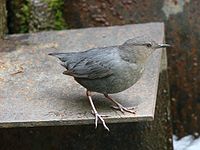
Dippers are a group of perching birds whose habitat includes aquatic environments in the Americas, Europe, and Asia. They are named for their bobbing or dipping movements. There are 5 species worldwide and 1 species which occurs in Guatemala.
- American DipperAmerican DipperThe American Dipper , also known as a Water Ouzel, is a stocky dark grey bird with a head sometimes tinged with brown, and white feathers on the eyelids cause the eyes to flash white as the bird blinks. It is 16.5 cm long and weighs on average 46 g...
Cinclus mexicanus
Kinglets
Order: Passeriformes. Family: RegulidaeThe kinglets or crests are a small group of birds often included in the Old World warblers, but frequently given family status because they also resemble the titmice
Titmouse
The tits, chickadees, and titmice constitute Paridae, a large family of small passerine birds which occur in the northern hemisphere and Africa...
. There are 7 species worldwide and 2 species which occur in Guatemala.
- Golden-crowned KingletGolden-crowned KingletThe Golden-crowned Kinglet, Regulus satrapa, is a very small songbird.Adults are olive-gray on the upperparts with white underparts, with thin bills and short tails. They have white wing bars, a black stripe through the eyes and a yellow crown surrounded by black...
Regulus satrapa - Ruby-crowned Kinglet Regulus calendula
Thrushes and allies

.jpg)
The thrushes
Thrush (bird)
The thrushes, family Turdidae, are a group of passerine birds that occur worldwide.-Characteristics:Thrushes are plump, soft-plumaged, small to medium-sized birds, inhabiting wooded areas, and often feed on the ground or eat small fruit. The smallest thrush may be the Forest Rock-thrush, at and...
are a group of passerine birds that occur mainly in the Old World. They are plump, soft plumaged, small to medium-sized insectivores or sometimes omnivores, often feeding on the ground. Many have attractive songs. There are 335 species worldwide and 18 species which occur in Guatemala.
- Eastern BluebirdEastern BluebirdThe Eastern Bluebird, Sialia sialis, is a small thrush found in open woodlands, farmlands and orchards, and most recently can be spotted in suburban areas. It is the state bird of Missouri and New York....
Sialia sialis - Brown-backed SolitaireBrown-backed SolitaireThe Brown-backed Solitaire is considered a thrush and is placed in the family Turdidae. It is a medium-sized bird about 21 centimeters long...
Myadestes occidentalis - Slate-colored Solitaire Myadestes unicolor
- Orange-billed Nightingale-ThrushOrange-billed Nightingale-thrushThe Orange-billed Nightingale-thrush is a species of bird in the Turdidae family.It is found in Colombia, Costa Rica, El Salvador, Guatemala, Honduras, Mexico, Nicaragua, Panama, Trinidad and Tobago, and Venezuela....
Catharus aurantiirostris - Ruddy-capped Nightingale-ThrushRuddy-capped Nightingale-thrushThe Ruddy-capped Nightingale-thrush is a small thrush which is a resident breeder in mountain forests from central Mexico to western Panama. A predominantly brown-plumaged bird, it has a rich song.-Taxonomy and naming:...
Catharus frantzii - Black-headed Nightingale-ThrushBlack-headed Nightingale-thrushThe Black-headed Nightingale-thrush is a species of bird in the Turdidae family. It is found in Costa Rica, Guatemala, Honduras, Mexico, Nicaragua, and Panama....
Catharus mexicanus - Spotted Nightingale-ThrushSpotted Nightingale-thrushThe Spotted Nightingale-thrush is a species of bird in the Turdidae family.It is found in Argentina, Bolivia, Colombia, Ecuador, El Salvador, Guatemala, Honduras, Mexico, Peru, and Venezuela....
Catharus dryas - VeeryVeeryThe Veery, Catharus fuscescens, is a small thrush species. It is occasionally called Willow Thrush or Wilson's Thrush. It is a member of a close-knit group of migrant Catharus species, which also includes the cryptotaxa Grey-cheeked Thrush and Bicknell's Thrush The Veery, Catharus fuscescens, is a...
Catharus fuscescens - Gray-cheeked ThrushGray-cheeked ThrushThe Grey-cheeked Thrush, Catharus minimus, is a medium-sized thrush. This species is 15–17 cm in length, and has the white-dark-white underwing pattern characteristic of Catharus thrushes. It is a member of a close-knit group of migrant species together with the Veery and Bicknell's Thrush ;...
Catharus minimus - Swainson's ThrushSwainson's ThrushSwainson's Thrush , also called Olive-backed Thrush, is a medium-sized thrush. This species is 16–18 cm in length, and has the white-dark-white underwing pattern characteristic of Catharus thrushes...
Catharus ustulatus - Hermit ThrushHermit ThrushThe Hermit Thrush is a medium-sized North American thrush. It is not very closely related to the other North American migrant species of Catharus, but rather to the Mexican Russet Nightingale-thrush.-Description:...
Catharus guttatus - Wood ThrushWood ThrushThe Wood Thrush, Hylocichla mustelina, is a North American passerine bird. It is closely related to other thrushes such as the American Robin and is widely distributed across North America, wintering in Central America and southern Mexico...
Hylocichla mustelina - Black ThrushBlack ThrushThe Black Thrush is a species of bird in the Turdidae family. It was formerly known as the Black Robin.It is found in El Salvador, Guatemala, Honduras, and Mexico....
Turdus infuscatus - Mountain ThrushMountain ThrushThe Mountain Thrush is a large thrush which is found in Central America. It was formerly known as the Mountain Robin.-Description:...
Turdus plebejus - Clay-colored Robin Turdus grayi
- White-throated ThrushWhite-throated ThrushThe White-throated Thrush is a species of bird in the Turdidae family.It is found in Belize, Colombia, Costa Rica, Ecuador, El Salvador, Guatemala, Honduras, Mexico, Nicaragua, Panama, and the United States....
Turdus assimilis - Rufous-collared Thrush Turdus rufitorques
- American RobinAmerican RobinThe American Robin or North American Robin is a migratory songbird of the thrush family. It is named after the European Robin because of its reddish-orange breast, though the two species are not closely related, with the European robin belonging to the flycatcher family...
Turdus migratorius
Mockingbirds and Thrashers
Order: Passeriformes. Family: MimidaeThe mimids are a family of passerine birds that includes thrasher
Thrasher
Thrashers are a New World group of passerine birds related to mockingbirds and New World catbirds. Like these, they are in the Mimidae family. There are 15 species in one large and 4 monotypic genera.These do not form a clade but are a phenetic assemblage...
s, mockingbird
Mockingbird
Mockingbirds are a group of New World passerine birds from the Mimidae family. They are best known for the habit of some species mimicking the songs of other birds and the sounds of insects and amphibians, often loudly and in rapid succession. There are about 17 species in three genera...
s, trembler
Trembler
Tremblers are a New World group of passerine birds related to mockingbirds and New World catbirds. Like these, they are in the Mimidae family. There are 2-4 species in one genus, Cinclocerthia:...
s, and the New World catbirds. These birds are notable for their vocalizations, especially their ability to mimic a wide variety of birds and other sounds heard outdoors. Their colouring tends towards dull greys and browns. There are 35 species worldwide and 4 species which occur in Guatemala.
- Gray CatbirdGray CatbirdThe Gray Catbird , also spelled Grey Catbird, is a medium-sized northern American perching bird of the mimid family. It is the only member of the "catbird" genus Dumetella...
Dumetella carolinensis - Black CatbirdBlack CatbirdThe Black Catbird is a songbird species in the monotypic genus Melanoptila of the family Mimidae. At 24 grams and 20 cm, it is the smallest mimid.It is found in Belize, Guatemala, Honduras, and Mexico...
Melanoptila glabrirostris Near-threatened - Tropical MockingbirdTropical MockingbirdThe Tropical Mockingbird, Mimus gilvus, is a resident breeding bird from southern Mexico south to northern Brazil, and in the Lesser Antilles and other Caribbean islands. The birds in Panama and Trinidad may have been introduced. The Northern Mockingbird is its closest living relative, but the...
Mimus gilvus - Blue-and-white MockingbirdBlue-and-white MockingbirdThe Blue-and-white Mockingbird is a species of bird in the Mimidae family. It is found in El Salvador, Guatemala, Honduras, and south-eastern Mexico. Its natural habitats are dry scrubland, woodland, second growth and forest edges at 1000–3000 m above sea-level.It is about 25 cm long...
Melanotis hypoleucus
Wagtails and pipits
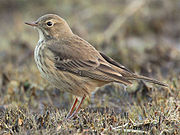
Motacillidae
The Motacillidae are a family of small passerine birds with medium to long tails. There are around 65 species in 6 genera and they include the wagtails, longclaws and pipits. The longclaws are entirely restricted to the Afrotropics, and the wagtails are predominately found in Europe, Africa and...
The Motacillidae are a family of small passerine birds with medium to long tails. They include the wagtails, longclaws and pipits. They are slender, ground feeding insectivores of open country. There are 54 species worldwide and 1 species which occurs in Guatemala.
- American Pipit Anthus rubescens
Waxwings
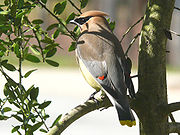
The waxwing
Waxwing
The waxwings form the genus Bombycilla of passerine birds. According to most authorities, this is the only genus placed in the family Bombycillidae.-Description:Waxwings are characterised by soft silky plumage...
s are a group of passerine birds characterized by soft silky plumage and unique red tips to some of the wing feathers. In the Bohemian and Cedar Waxwings, these tips look like sealing wax, and give the group its name. These are arboreal birds of northern forests. They live on insects in summer and berries in winter. There are 3 species worldwide and1 species which occurs in Guatemala.
- Cedar WaxwingCedar WaxwingThe Cedar Waxwing is a member of the family Bombycillidae or waxwing family of passerine birds. It breeds in open wooded areas in North America, principally southern Canada and the northern United States.-Description:...
Bombycilla cedrorum
Silky-flycatchers
Order: Passeriformes. Family: PtilogonatidaeThe silky-flycatchers are a small family of passerine birds which occur mainly in Central America, although the range of one species. They are related to waxwings, and like that group have a soft silky plumage, usually grey or pale yellow in colour. They have small crests. There are 4 species worldwide and1 species which occurs in Guatemala.
- Gray Silky-flycatcher Ptilogonys cinereus
Olive Warbler
.jpg)
The Olive Warbler is a small passerine bird, the only member of the family Peucedramidae. It is a long-winged bird with a grey body and some olive-green on the wings and two white wing bars. The male's head and breast are orange, the female's yellow.
- Olive WarblerOlive WarblerThe Olive Warbler is a small passerine bird. It is the only member of the genus Peucedramus and the family Peucedramidae....
Peucedramus taeniatus
New World warblers
Order: Passeriformes. Family: Parulidae
.jpg)
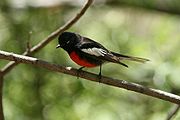
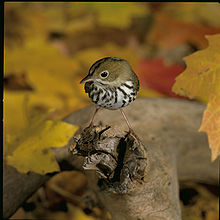
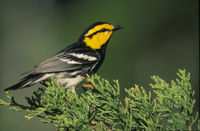
New World warbler
The New World warblers or wood-warblers are a group of small, often colorful, passerine birds restricted to the New World. They are not related to the Old World warblers or the Australian warblers....
s are a group of small, often colourful, passerine birds restricted to the New World. Most are arboreal, but some are terrestrial. Most members of this family are insectivores. There are 119 species worldwide and 52 species which occur in Guatemala.
- Blue-winged WarblerBlue-winged WarblerThe Blue-winged Warbler, Vermivora cyanoptera, is a fairly common New World warbler, 11.5 cm long and weighing 8.5 g. It breeds in eastern North America in southern Ontario and the eastern USA. Its range is extending northwards, where it is replacing the very closely related...
Vermivora cyanoptera - Golden-winged WarblerGolden-winged WarblerThe Golden-winged Warbler, Vermivora chrysoptera, is a New World warbler, 11.6 cm long and weighing 8.5 g. It breeds in eastern North America, southeastern Canada and the eastern USA...
Vermivora chrysoptera Near-threatened - Tennessee WarblerTennessee WarblerThe Tennessee Warbler, Oreothlypis peregrina, is a New World warbler. It breeds in northern North America across Canada and the northern USA. It is migratory, wintering in southern Central America and northern Colombia and Venezuela, with a few stragglers going as far south as Ecuador. It is a...
Oreothlypis peregrina - Orange-crowned WarblerOrange-crowned WarblerThe Orange-crowned Warbler is a small songbird of the New World warbler family.These birds are distinguished by their lack of wing bars, streaking on the underparts, strong face marking or bright colouring, resembling a fall Tennessee Warbler. The orange patch on the crown is usually not visible...
Oreothlypis celata - Nashville WarblerNashville WarblerThe Nashville Warbler, Vermivora ruficapilla, is a small songbird in the New World warbler family.They have olive-brown upperparts, a white belly and a yellow throat and breast; they have a white eye ring, no wing bars and a thin pointed bill. Adult males have a grey head with a rusty crown patch ;...
Oreothlypis ruficapilla - Virginia's WarblerVirginia's WarblerVirginia's Warbler is a species of New World warbler.Despite what its name may suggest, Virginia's warbler is not actually named after the American State of Virginia, which makes sense as the birds range only reaches as far east as the state of Texas...
Oreothlypis virginiae - Crescent-chested WarblerCrescent-chested WarblerThe Crescent-chested Warbler is a small New World Warbler. It is generally uncommon in its native range of central Mexico, and accidental elsewhere....
Oreothlypis superciliosa - Northern ParulaNorthern ParulaThe Northern Parula, Parula americana, is a small New World warbler. It breeds in eastern North America from southern Canada to Florida....
Parula americana - Tropical ParulaTropical ParulaThe Tropical Parula is a small New World warbler. It breeds from southernmost Texas and northwest Mexico south through Central America to northern Argentina, including Trinidad and Tobago. This widespread and common species is not considered threatened by the IUCN.This passerine is not migratory,...
Parula pitiayumi - Yellow WarblerYellow WarblerDendroica petechia is a New World warbler species or superspecies; the subspecies group around D. aestiva is increasingly treated as good species Dendroica aestiva again. The name for the entire cryptic species complex is Mangrove Warbler, and another group of subspecies is known as Golden Warbler...
Dendroica petechia - Chestnut-sided WarblerChestnut-sided WarblerThe Chestnut-sided Warbler is a New World warbler. They breed in eastern North America and in southern Canada westwards to the Canadian Prairies...
Dendroica pensylvanica - Magnolia WarblerMagnolia WarblerSetophaga magnolia, commonly known as the Magnolia warbler, is a member of the Parulidae family of wood warblers. [4] This warbler was first discovered in magnolia trees in the 19th century by famed ornithologist Alexander Wilson while in Mississippi. [7]-Description:The magnolia warbler can be...
Dendroica magnolia - Cape May WarblerCape May WarblerThe Cape May Warbler, Dendroica tigrina, is a small New World warbler. It breeds in northern North America. Its breeding habitat spans across all but the westernmost parts of southern Canada, and into the Great Lakes region and New England. It is migratory, wintering in the West Indies...
Dendroica tigrina - Black-throated Blue WarblerBlack-throated Blue WarblerThe Black-throated Blue Warbler, Setophaga caerulescens, is a small songbird of the New World warbler family.Adult males have white underparts with black throat, face and flanks; the upperparts are deep blue; immature males are similar with upperparts more greenish...
Dendroica caerulescens - Yellow-rumped WarblerYellow-rumped WarblerFour closely related North American bird forms—the eastern Myrtle Warbler , its western counterpart, Audubon's Warbler , the northwest Mexican Black-fronted Warbler , and the Guatemalan Goldman's Warbler —are periodically lumped as the Yellow-rumped Warbler .-Classification:Since...
Dendroica coronata - Black-throated Gray WarblerBlack-throated Gray WarblerThe Black-throated Gray Warbler is a songbird of the New World warbler family. It is 13 cm long and has black, grey, and white plumage. It breeds in western North America from British Columbia to New Mexico, and winters in Mexico and the southwestern United States...
Dendroica nigrescens - Golden-cheeked WarblerGolden-cheeked WarblerThe Golden-cheeked Warbler Dendroica chrysoparia is an endangered species of bird that breeds in Central Texas, from Palo Pinto County southwestward along the eastern and southern edge of the Edwards Plateau to Kinney County...
Dendroica chrysoparia Endangered - Black-throated Green WarblerBlack-throated Green WarblerThe Black-throated Green Warbler, Setophaga virens, is a small songbird of the New World warbler family.It is 12 cm long and weighs 9 g, and has an olive-green crown, a yellow face with olive markings, a thin pointed bill, white wing bars, an olive-green back and pale underparts with...
Dendroica virens - Townsend's WarblerTownsend's WarblerThe Townsend's Warbler, Dendroica townsendi, is a small songbird of the New World warbler family.These birds have a yellow face with a black stripe across their cheeks, a thin pointed bill, white wing bars, olive upperparts with black streaks on their backs and flanks, and a white belly...
Dendroica townsendi - Hermit WarblerHermit WarblerThe Hermit Warbler, Dendroica occidentalis, is a small perching bird. It is a species of New World warbler.Mature Hermit Warblers normally grow to be 4½ to 5 inches long. Hermit Warblers are dark gray in coloration on top, and white below, and their flanks are streaked with black. The wings...
Dendroica occidentalis - Blackburnian WarblerBlackburnian WarblerThe Blackburnian Warbler, Dendroica fusca , is a small New World warbler. They breed in eastern North America, from southern Canada, westwards to the southern Canadian Prairies, the Great Lakes region and New England, to North Carolina....
Dendroica fusca - Yellow-throated WarblerYellow-throated WarblerThe Yellow-throated Warbler, Dendroica dominica, is a small migratory songbird species breeding in temperate North America. It belongs to the New World warbler family .-Description:...
Dendroica dominica - Grace's WarblerGrace's WarblerGrace's Warbler, Dendroica graciae, is a small perching bird and a species of New World warbler.Grace's Warbler was discovered by Dr. Elliott Coues in the Rocky Mountains in 1864...
Dendroica graciae - Prairie WarblerPrairie WarblerThe Prairie Warbler, Dendroica discolor, is a small songbird of the New World warbler family.These birds have yellow underparts with dark streaks on the flanks, and olive upperparts with rusty streaks on the back; they have a yellow line above the eye, a dark line through it, and a yellow spot...
Dendroica discolor - Bay-breasted WarblerBay-breasted WarblerThe Bay-breasted Warbler, Dendroica castanea , is a New World warbler. They breed in northern North America, specifically in Canada, into the Great Lakes region, and into northern New England....
Dendroica castanea - Cerulean WarblerCerulean WarblerThe Cerulean Warbler, Dendroica cerulea, is a small songbird of the New World warbler family.-Description:Adult males have pale cerulean blue upperparts and white underparts with a black necklace across the breast; they also have black streaks on the back and flanks...
Dendroica cerulea Vulnerable - Black-and-white WarblerBlack-and-white WarblerThe Black-and-white Warbler is a small New World warbler. It breeds in northern and eastern North America from southern Canada to Florida....
Mniotilta varia - American RedstartAmerican RedstartThe American Redstart is a New World warbler. It is the only member of its genus and is unrelated to the Old World redstarts. It derives its name from the male's red tail, start being an old word for tail.-Description:...
Setophaga ruticilla - Prothonotary WarblerProthonotary WarblerThe Prothonotary Warbler is a small songbird of the New World warbler family. It is the only member of the genus Protonotaria....
Protonotaria citrea - Worm-eating WarblerWorm-eating WarblerThe Worm-eating Warbler is a small New World warbler. It is the only species classified in the genus Helmitheros....
Helmitheros vermivorum - Swainson's WarblerSwainson's WarblerSwainson's Warbler, Limnothlypis swainsonii, is a small species of New World warbler. It is monotypic, the only member of the genus Limnothlypis.-Description:...
Limnothlypis swainsonii - OvenbirdOvenbirdThe Ovenbird is a small songbird of the New World warbler family . This migratory bird breeds in eastern North America and moves south in winter.-Taxonomy:...
Seiurus aurocapilla - Northern WaterthrushNorthern WaterthrushThe Northern Waterthrush is one of the larger New World warblers. It breeds in the northern part of North America in Canada, and in the northern United States, . This bird is migratory, wintering in Central America, the West Indies, and Florida; also Venezuela, Colombia, and Ecuador...
Parkesia noveboracensis - Louisiana WaterthrushLouisiana WaterthrushThe Louisiana Waterthrush is a New World warbler. It breeds in eastern North America from southernmost Canada and south through the eastern USA, excluding Florida and the coast....
Parkesia motacilla - Kentucky WarblerKentucky WarblerThe Kentucky Warbler, Oporornis formosus, is a small species of New World warbler. The Kentucky Warbler, like all members of the genus Oporornis, is a sluggish and heavy warbler with a short tail, preferring to spend most of its time on or near the ground, except when singing.Adult Kentucky...
Oporornis formosus - Mourning WarblerMourning WarblerThe Mourning Warbler, Oporornis philadelphia, is a small songbird of the New World warbler family.These 13 cm long birds have yellow underparts, olive-green upperparts and pink legs. Adult males have a grey hood and a black patch on the throat and breast...
Oporornis philadelphia - MacGillivray's WarblerMacGillivray's WarblerThe MacGillivray's Warbler, Oporornis tolmiei, is a small species of New World warbler. Like all members of the genus Oporornis, these birds are sluggish and heavy warblers with short tails, preferring to spend most of their time on, or near the ground, except when singing.The MacGillivray's...
Oporornis tolmiei - Common YellowthroatCommon YellowthroatThe Common Yellowthroat is a New World warbler. They are abundant breeders in North America, ranging from southern Canada to central Mexico....
Geothlypis trichas - Gray-crowned Yellowthroat Geothlypis poliocephala
- Hooded WarblerHooded WarblerThe Hooded Warbler, Wilsonia citrina, is a New World warbler. It breeds in eastern North America and across the eastern USA and into southernmost Canada, . It is migratory, wintering in Central America and the West Indies...
Wilsonia citrina - Wilson's WarblerWilson's WarblerThe Wilson's Warbler, Wilsonia pusilla, is a small New World warbler. It is primarily greenish above and yellow below, with rounded wings and a long, slim tail. The male has a black crown patch which is greatly reduced or missing entirely in the female...
Wilsonia pusilla - Canada WarblerCanada WarblerThe Canada Warbler is a small 13 cm long songbird of the New World warbler family.These birds have yellow underparts, blue-grey upperparts and pink legs; they also have yellow eye-rings and thin, pointed bills. Adult males have black foreheads and black necklaces...
Wilsonia canadensis - Red-faced WarblerRed-faced WarblerThe Red-faced Warbler is a species of New World warbler.Mature Red-faced Warblers are small birds, 14 cm long. They are light gray on top with a white rump and a white underside. The face, neck, and upper breast are all bright red, while the crown and sides of the head are black...
Cardellina rubrifrons - Pink-headed WarblerPink-headed WarblerThe Pink-headed Warbler is a small passerine bird found in the southwestern highlands of Guatemala and the central and southeastern highlands of the Mexican state of Chiapas. The adult is primarily red, with a silvery-pink head and chest...
Ergaticus versicolor Vulnerable - Painted RedstartPainted RedstartThe Painted Redstart, Myioborus pictus, is a species of New World warbler. It is also known as the Painted Whitestart.-Taxonomy:When he first described the species in 1829, naturalist William John Swainson assigned it to the genus Setophaga — the same genus as that of the American Redstart — where...
Myioborus pictus - Slate-throated RedstartSlate-throated RedstartThe Slate-throated Whitestart , or, less accurately, the Slate-throated Redstart, is a species of bird in the Parulidae family....
Myioborus miniatus - Fan-tailed WarblerFan-tailed WarblerThere are a number of birds called Fan-tailed Warbler.They include:* American Fan-tailed Warbler, Euthlypis lachrymosa* Old World Zitting Cisticola, Cisticola juncidis, previously called Fan-tailed Warbler....
Euthlypis lachrymosa - Golden-crowned WarblerGolden-crowned WarblerThe Golden-crowned Warbler, Basileuterus culicivorus, is a small New World warbler.-Distribution and habitat:It breeds from Mexico and south through Central America to northeastern Argentina and Uruguay, and on Trinidad. It is a species mainly of lowland forests.-Description:The Golden-crowned...
Basileuterus culicivorus - Rufous-capped WarblerRufous-capped WarblerThe Rufous-capped Warbler is a New World warbler native from Mexico south to much of Central America, rarely occurring as far north as southeastern Arizona and south Texas....
Basileuterus rufifrons - Golden-browed WarblerGolden-browed WarblerThe Golden-browed Warbler is a species of bird in the Parulidae family, the New World warblers.It is found in El Salvador, Guatemala, Honduras, and Mexico.Its natural habitat is subtropical or tropical moist montanes....
Basileuterus belli - Yellow-breasted ChatYellow-breasted ChatThe Yellow-breasted Chat is a large songbird, formerly considered the most atypical member of the New World warbler family, though the long-standing suspicion is that it does not actually belong there. Its placement is not definitely resolved. It is the only member of the genus Icteria...
Icteria virens
Bananaquit

The Bananaquit is a small passerine bird. It has a slender, curved bill, adapted to taking nectar from flowers and is the only member of the genus Coereba (Vieillot, 1809) and is normally placed within the family Coerebidae, although there is uncertainty whether that placement is correct.
- BananaquitBananaquitThe Bananaquit is a species of passerine bird of uncertain relation. It is tentatively placed in the tanager family, but classified as incertae sedis by other authorities such as the American Ornithologists' Union. Its classification is debated, and it is often placed in its own family: Coerebidae...
Coereba flaveola
Tanagers
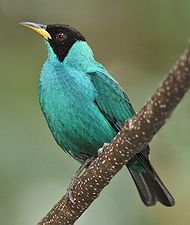
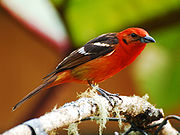

The tanager
Tanager
The tanagers comprise the bird family Thraupidae, in the order Passeriformes. The family has an American distribution.There were traditionally about 240 species of tanagers, but the taxonomic treatment of this family's members is currently in a state of flux...
s are a large group of small to medium-sized passerine birds restricted to the New World, mainly in the tropics. Many species are brightly coloured. They are seed eaters, but their preference tends towards fruit and nectar. Most have short, rounded wings. There are 69 species worldwide and 28 species which occur in Guatemala.
- Gray-headed Tanager Eucometis penicillata
- Black-throated Shrike-TanagerBlack-throated Shrike-tanagerThe Black-throated Shrike-tanager is a species of bird in the Thraupidae family.It is found in Belize, Guatemala, Honduras, and Mexico.Its natural habitat is subtropical or tropical moist lowland forests.-References:...
Lanio aurantius - Crimson-collared TanagerCrimson-collared TanagerThe Crimson-collared Tanager, Ramphocelus sanguinolentus, is a rather small Middle American songbird. It was first described by the French naturalist René-Primevère Lesson in 1831, its specific epithet from the Latin adjective sanguinolentus, "bloodied", referring to its red plumage.-Taxonomy:This...
Ramphocelus sanguinolentus - Passerini's TanagerPasserini's TanagerPasserini's Tanager, Ramphocelus passerinii, is a medium-sized passerine bird. This tanager is a resident breeder in the Caribbean lowlands from southern Mexico to western Panama...
Ramphocelus passerinii - Blue-gray TanagerBlue-gray TanagerThe Blue-grey Tanager, Thraupis episcopus, is a medium-sized South American songbird of the Tanager family, Thraupidae. Its range is from Mexico south to northeast Bolivia and northern Brazil, all of the Amazon Basin, except the very south. It has been introduced to Lima...
Thraupis episcopus - Yellow-winged TanagerYellow-winged TanagerThe Yellow-winged Tanager, Thraupis abbas, is a neotropical member of the tanager family. It is of average size for a tanager, about 18 centimetres . It is distinguished by the yellow patches on its dusky green wings, marking an otherwise dark bluish and gray body. It has a pale lavender tone on...
Thraupis abbas - Palm TanagerPalm TanagerThe Palm Tanager, Thraupis palmarum, is a medium-sized passerine bird. This tanager is a resident breeder from Nicaragua south to Bolivia, Paraguay and southern Brazil. It also breeds on Trinidad and, since 1962, on Tobago...
Thraupis palmarum - Azure-rumped TanagerAzure-rumped TanagerThe Azure-rumped Tanager, Tangara cabanisi is a Middle American bird of the family Thraupidae. It is a local resident in humid broadleaf forests and adjacent plantations of the Pacific slope of western Guatemala and southern Chiapas, Mexico...
Tangara cabanisi Endangered - Rufous-winged TanagerRufous-winged TanagerThe Rufous-winged Tanager is a species of bird in the Thraupidae family.It is found in Belize, Colombia, Costa Rica, Ecuador, Guatemala, Honduras, Nicaragua, and Panama....
Tangara lavinia - Golden-hooded TanagerGolden-hooded TanagerThe Golden-hooded Tanager, Tangara larvata, is a medium-sized passerine bird. This tanager is a resident breeder from southern Mexico south to western Ecuador....
Tangara larvata - Green HoneycreeperGreen HoneycreeperThe Green Honeycreeper is a small bird in the tanager family. It is found in the tropical New World from southern Mexico south to Brazil, and on Trinidad. It the only member of the genus Chlorophanes...
Chlorophanes spiza - Shining HoneycreeperShining HoneycreeperThe Shining Honeycreeper is a small bird in the tanager family. It is found in the tropical New World in Central America from southern Mexico to Panama and northwest Colombia. It is sometimes considered to be conspecific with the Purple Honeycreeper The Shining Honeycreeper (Cyanerpes lucidus) is...
Cyanerpes lucidus - Red-legged HoneycreeperRed-legged HoneycreeperThe Red-legged Honeycreeper is a small songbird species in the tanager family . It is found in the tropical New World from southern Mexico south to Peru, Bolivia and central Brazil, Trinidad and Tobago, and on Cuba, where possibly introduced.-Description:The Red-legged Honeycreeper is on average...
Cyanerpes cyaneus - Grayish SaltatorGrayish SaltatorThe Greyish Saltator, Saltator coerulescens, is a seed-eating songbird that is widespread in the tropical Americas. Traditionally placed in the cardinal family , the saltators actually seem to be closer to the tanagers...
Saltator coerulescens - Buff-throated SaltatorBuff-throated SaltatorThe Buff-throated Saltator, Saltator maximus, is a seedeating bird. Traditionally placed in the cardinal family , it actually seems to be closer to the tanagers . It breeds from southeastern Mexico to western Ecuador and northeastern Brazil.This is the type species of Saltator...
Saltator maximus - Black-headed SaltatorBlack-headed SaltatorThe Black-headed Saltator, Saltator atriceps, is a seedeating bird. Traditionally placed in the cardinal family , it actually seems to be closer to the tanagers . It breeds from central Mexico to eastern Panama....
Saltator atriceps
Buntings, sparrows, seedeaters and allies
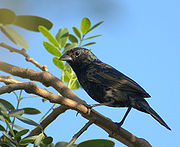
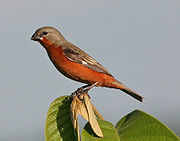

Emberizidae
The Emberizidae are a large family of passerine birds. They are seed-eating birds with a distinctively shaped bill.In Europe, most species are called buntings. In North America, most of the species in this family are known as sparrows, but these birds are not closely related to the sparrows, the...
The emberizids are a large family of passerine birds. They are seed-eating birds with a distinctively shaped bill. In Europe, most species are named as buntings. In North America, most of the species in this family are known as Sparrows, but these birds are not closely related to the Old World sparrows which are in the family Passeridae. Many emberizid species have distinctive head patterns. There are species 115 worldwide and 32 species which occur in Guatemala.
- Common Bush-TanagerCommon Bush-TanagerThe Common Bush-tanager is a small passerine bird. It is a resident breeder in the highlands from central Mexico south to Bolivia and northwest Argentina. C. ophthalmicus in the loose sense is a notorious cryptic species complex, and several of the up to 25 subspecies recognized in recent times...
Chlorospingus ophthalmicus - Blue-black GrassquitBlue-black GrassquitThe Blue-black Grassquit is a small bird in the tanager family, Thraupidae. It was previously classified in the bunting and American sparrow family, Emberizidae. It breeds from southern Mexico through Central America, and South America as far as northern Chile, Argentina and Paraguay, and on...
Volatinia jacarina - Slate-colored Seedeater Sporophila schistacea
- Variable SeedeaterVariable SeedeaterThe Variable Seedeater, Sporophila corvina, is a passerine bird which breeds from southern Mexico through Central America to the Chocó of north-western South America. The taxonomy is confusing, and it was formerly considered a subspecies of Sporophila americana...
Sporophila corvina - White-collared SeedeaterWhite-collared SeedeaterThe White-collared Seedeater is a passerine bird in the typical seedeater genus Sporophila.-Taxonomy:The subspecies S. t...
Sporophila torqueola - Ruddy-breasted SeedeaterRuddy-breasted SeedeaterThe Ruddy-breasted Seedeater is a species of bird in the Thraupidae family.It is found in Brazil, Colombia, Costa Rica, Ecuador, El Salvador, French Guiana, Guatemala, Guyana, Honduras, Mexico, Nicaragua, Panama, Suriname, Trinidad and Tobago, and Venezuela.Its natural habitats are dry savanna,...
Sporophila minuta - Thick-billed Seed-FinchThick-billed Seed-finchThe Thick-billed Seed-finch is a species of bird in the Thraupidae family, but was until recently placed in Emberizidae. It is found widely in shrubby and grassy areas from southern Mexico, through Central America, to the Chocó in Colombia and Ecuador...
Oryzoborus funereus - Yellow-faced GrassquitYellow-faced GrassquitThe Yellow-faced Grassquit is a passerine bird from the Central American tropics and surrounding regions. It was formerly alled with the American sparrows and placed in the Emberizidae; actually, however, it is one of the tholospizan "finches" which are specialized tanagers...
Tiaris olivaceus - Slaty FinchSlaty FinchThe Slaty Finch is a bird species in the family Thraupidae .It is found in Argentina, Bolivia, Colombia, Costa Rica, Ecuador, El Salvador, Guyana, Honduras, Mexico, Nicaragua, Panama, Peru, Uruguay, and Venezuela...
Haplospiza rustica - Cinnamon-bellied Flowerpiercer Diglossa baritula
- Grassland Yellow-FinchGrassland Yellow-finchThe Grassland Yellow Finch, Sicalis luteola, is a small passerine bird. Despite its name, it is not a finch, but is a seedeater. These were formerly united with the buntings and American sparrows in the Emberizidae, but are now known to be tanagers....
Sicalis luteola - Chestnut-capped Brush-FinchChestnut-capped Brush-FinchThe Chestnut-capped Brush Finch, Arremon brunneinucha, is a passerine bird which breeds in highlands from central Mexico to southeastern Peru. Despite its name, it is not a true finch, but rather a member of the large Emberizidae family, which also includes buntings, American sparrows, juncos...
Arremon brunneinucha - Orange-billed SparrowOrange-billed SparrowThe Orange-billed Sparrow is a species of bird in the Emberizidae family.In Central America it is found in Belize, Costa Rica, Guatemala, Honduras, Mexico, Nicaragua and Panama...
Arremon aurantiirostris - Olive SparrowOlive SparrowThe Olive Sparrow, Arremonops rufivirgatus, is a species of American sparrow in the family Emberizidae. Its range includes Belize, Costa Rica, Guatemala, Honduras, Mexico, Nicaragua and southern Texas .It is long, and is the only sparrow with an olive back...
Arremonops rufivirgatus - Green-backed SparrowGreen-backed SparrowThe Green-backed Sparrow is a species of bird in the Emberizidae family.It is found in Belize, Guatemala, Honduras, and Mexico....
Arremonops chloronotus - White-naped Brush-FinchWhite-naped Brush-finchThe White-naped Brush Finch , also known as the Yellow-throated Brush Finch, is a species of bird in the Emberizidae family.It is found in Colombia, Costa Rica, El Salvador, Guatemala, Honduras, Mexico, Nicaragua, and Panama...
Atlapetes albinucha - Spotted TowheeSpotted TowheeThe Spotted Towhee is a large New World sparrow. The taxonomy of the towhees has been debated in recent decades, and formerly this bird and the Eastern Towhee were considered a single species, the Rufous-sided Towhee...
Pipilo maculatus - Eastern TowheeEastern TowheeThe Eastern Towhee, Pipilo erythrophthalmus, is a large New World sparrow. The taxonomy of the towhees has been under debate in recent decades, and formerly this bird and the Spotted Towhee were considered a single species, the Rufous-sided Towhee....
Pipilo erythrophthalmus - Rusty SparrowRusty SparrowThe Rusty Sparrow is a species of bird in the Emberizidae family.It is found in Belize, Costa Rica, El Salvador, Guatemala, Honduras, Mexico, and Nicaragua....
Aimophila rufescens - White-eared Ground-SparrowWhite-eared Ground-SparrowThe White-eared Ground-Sparrow, Melozone leucotis, is a large American sparrow which breeds in a small range of Central America at middle altitudes from southern Mexico and Guatemala to northern Costa Rica...
Melozone leucotis - Prevost's Ground-SparrowPrevost's Ground-SparrowPrevost's Ground-Sparrow Melozone biarcuatum, also known as the White-faced Ground-Sparrow, is an American sparrow.-Etymology:Its English name commemorates French naturalist Florent Prévost. The isolated Costa Rican form may be a separate species, Cabanis's Ground-Sparrow Prevost's Ground-Sparrow...
Melozone biarcuata - Stripe-headed SparrowStripe-headed SparrowThe Stripe-headed Sparrow, Peucaea ruficauda, is an American sparrow which breeds from Pacific coastal southwestern Mexico, including the transverse ranges, Cordillera Neovolcanica to pacific coastal northern Costa Rica....
Peucaea ruficauda - Botteri's SparrowBotteri's SparrowThe Botteri's Sparrow, Aimophila botterii, is a medium-sized sparrow.This passerine bird is primarily found in Mexico, with a breeding range that extends into the southeastern tip of the U.S...
Peucaea botterii - Chipping SparrowChipping SparrowThe Chipping Sparrow is a species of American sparrow in the family Emberizidae. It is widespread, fairly tame, and common across most of its North American range.-Description:...
Spizella passerina - Clay-colored SparrowClay-colored SparrowThe Clay-colored Sparrow is a small sparrow of North America.-Overview:Adults have light brown upperparts and pale underparts, with darker streaks on the back. They have a pale crown stripe on a dark brown crown, a white line over the eyes, a dark line through the eyes, a light brown cheek patch...
Spizella pallida (A) - Vesper SparrowVesper SparrowThe Vesper Sparrow is a medium-sized American sparrow. It is the only member of the genus Pooecetes.Adults have light brown upperparts and light underparts, both with darker streaking. They have a white eye ring and a long dark brown tail which shows white outer feathers in flight.Their breeding...
Pooecetes gramineus (A) - Lark SparrowLark SparrowThe Lark Sparrow is a fairly large American sparrow. It is the only member of the genus Chondestes.This passerine bird breeds in southern Canada, much of the United States, and northern Mexico. It is much less common in the east, where its range is contracting...
Chondestes grammacus (A) - Savannah SparrowSavannah SparrowThe Savannah Sparrow is a small American sparrow. It is the only widely accepted member of the genus Passerculus...
Passerculus sandwichensis - Grasshopper SparrowGrasshopper SparrowThe Grasshopper Sparrow, Ammodramus savannarum, is a small sparrow. The Ammodramus genus of 11 species inhabit grasslands and marshes....
Ammodramus savannarum - Lincoln's SparrowLincoln's SparrowThe Lincoln's Sparrow, Melospiza lincolnii, is a medium-sized sparrow.Adults have dark-streaked olive-brown upperparts with a light brown breast with fine streaks, a white belly, and a white throat. They have a brown cap with a grey stripe in the middle, olive-brown wings, and a narrow tail. Their...
Melospiza lincolnii - Rufous-collared SparrowRufous-collared SparrowThe Rufous-collared Sparrow, Zonotrichia capensis, is an American sparrow found in a wide range of habitats, often near humans, from the extreme southeast of Mexico to Tierra del Fuego, and on the island of Hispaniola. It is famous for its diverse vocalizations which have been intensely studied...
Zonotrichia capensis - Yellow-eyed JuncoYellow-eyed JuncoThe Yellow-eyed Junco is a species of junco, small American sparrows. It is the only North American junco with yellow eyes....
Junco phaeonotus
Saltators, Cardinals and allies
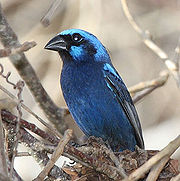
The cardinals are a family of passerine birds that are robust, seed-eating birds, with strong bills. They are typically associated with open woodland. The sexes usually have distinct plumages. There are 25 species worldwide and 22 species which occur in Guatemala.
- Rose-throated TanagerRose-throated TanagerThe Rose-throated Tanager is a medium-sized American songbird. Formerly placed in the tanager family , it and other members of its genus are now classified in the cardinal family...
Piranga roseogularis - Hepatic TanagerHepatic TanagerThe Hepatic Tanager, Piranga flava, is a medium-sized American songbird. Formerly placed in the tanager family , it and other members of its genus are now classified in the cardinal family...
Piranga flava - Summer TanagerSummer TanagerThe Summer Tanager, Piranga rubra, is a medium-sized American songbird. Formerly placed in the tanager family , it and other members of its genus are now classified in the cardinal family...
Piranga rubra - Scarlet TanagerScarlet TanagerThe Scarlet Tanager is a medium-sized American songbird. Formerly placed in the tanager family , it and other members of its genus are now classified in the cardinal family . The species's plumage and vocalizations are similar to other members of the cardinal family.-Description:Adults have pale...
Piranga olivacea - Western TanagerWestern TanagerThe Western Tanager, Piranga ludoviciana, is a medium-sized American songbird. Formerly placed in the tanager family , it and other members of its genus are now classified in the cardinal family...
Piranga ludoviciana - Flame-colored TanagerFlame-colored TanagerThe Flame-colored Tanager, Piranga bidentata, formerly known as the Stripe-backed Tanager, is a medium-sized American songbird. Formerly placed in the tanager family , it and other members of its genus are now classified in the cardinal family...
Piranga bidentata - White-winged TanagerWhite-winged TanagerThe White-winged Tanager is a medium-sized American songbird. Formerly placed in the tanager family , it and other members of its genus are now classified in the cardinal family . The species's plumage and vocalizations are similar to other members of the cardinal family...
Piranga leucoptera - Red-crowned Ant-TanagerRed-crowned Ant-TanagerThe Red-crowned Ant-Tanager, Habia rubica, is a medium-sized passerine bird from tropical America. The genus Habia was long placed with the tanagers , but it is actually closer to the cardinals...
Habia rubica - Red-throated Ant-TanagerRed-throated Ant-TanagerThe Red-throated Ant-tanager, Habia fuscicauda, is a medium-sized passerine bird. This species is a resident breeder on the Caribbean slopes from southeastern Mexico to eastern Panama. It was usually considered an aberrant kind of tanager and placed in the Thraupidae, but is actually closer to the...
Habia fuscicauda - Black-faced GrosbeakBlack-faced GrosbeakThe Black-faced Grosbeak, Caryothraustes poliogaster, is a large seed-eating bird in the cardinal family, which is a resident breeding species from southeastern Mexico to eastern Panama....
Caryothraustes poliogaster - Northern CardinalNorthern CardinalThe Northern Cardinal or Redbird or Common Cardinal is a North American bird in the genus Cardinalis. It can be found in southern Canada, through the eastern United States from Maine to Texas and south through Mexico...
Cardinalis cardinalis - Yellow GrosbeakYellow GrosbeakThe Yellow Grosbeak , Pheucticus chrysopeplus, is a medium-sized seed-eating bird in the same family as the Northern Cardinal, "tropical" or "New World" buntings, and "cardinal-grosbeaks" or "New World" grosbeaks....
Pheucticus chrysopeplus - Rose-breasted GrosbeakRose-breasted GrosbeakThe Rose-breasted Grosbeak, Pheucticus ludovicianus, is a large seed-eating songbird in the cardinal family . It breeds in cool-temperate North America, migrating to tropical America in winter.-Description:...
Pheucticus ludovicianus - Gray-throated Chat Granatellus sallaei
- Blue SeedeaterBlue SeedeaterThe Blue Seedeater is a species of bird in the family Cardinalidae. It was formerly placed with the American sparrows in the Emberizidae. It is found in highland forest and woodland, mainly near bamboo, in southern Mexico and Central America with a disjunct population in south-western Colombia,...
Amaurospiza concolor - Blue-black GrosbeakBlue-black GrosbeakThe Blue-black Grosbeak is a species of songbird in the Cardinalidae family.It is found in Belize, Bolivia, Brazil, Colombia, Costa Rica, Ecuador, French Guiana, Guatemala, Guyana, Honduras, Mexico, Nicaragua, Panama, Peru, Suriname, and Venezuela...
Cyanocompsa cyanoides - Blue BuntingBlue BuntingThe Blue Bunting is a species of passerine bird found in northern Central America. Measuring in length with a wingspan of , it is one of the smaller members of its genus. Like most buntings, the Blue Bunting is sexually dimorphic...
Cyanocompsa parellina - Blue GrosbeakBlue GrosbeakBlue Grosbeak , is a medium-sized seed-eating bird in the same family as the Northern Cardinal, "tropical" or New World buntings, and "cardinal-grosbeaks" or New World grosbeaks....
Passerina caerulea - Indigo BuntingIndigo BuntingThe Indigo Bunting, Passerina cyanea, is a small seed-eating bird in the family Cardinalidae. It is migratory, ranging from southern Canada to northern Florida during the breeding season, and from southern Florida to northern South America during the winter. It often migrates by night, using the...
Passerina cyanea - Varied BuntingVaried BuntingThe Varied Bunting is a species of songbird in the Cardinal family, Cardinalidae.The range of the Varied Bunting stretches from the southern parts of Arizona, New Mexico, and Texas in the United States south throughout Mexico as far as Oaxaca. Small disjunct populations occur in the state of...
Passerina versicolor - Painted BuntingPainted BuntingThe Painted Bunting is a species of bird in the Cardinal family, Cardinalidae, that is native to North America.-Taxonomy:...
Passerina ciris Near-threatened - DickcisselDickcisselThe Dickcissel is a small American seed-eating bird in the family Cardinalidae. It is the only member of the genus Spiza, though some sources list another supposedly extinct species...
Spiza americana
Troupials and allies
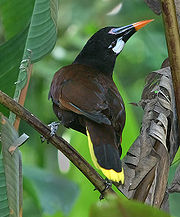
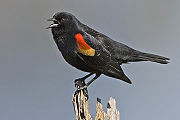
The icterids are a group of small to medium, often colourful, passerine birds restricted to the New World and include the grackle
Grackle
Grackle can refer to any of eleven black passerine birds native to North and South America. All are members of the Icterid family but belong to multiple genera.* Genus Quiscalus** Boat-tailed Grackle, Quiscalus major...
s, New World blackbird
New World blackbird
The New World blackbirds consist of 26 species of icterid birds that share the name blackbird but do not correspond with a formal taxon...
s, and New World oriole
New World oriole
New World orioles, comprising the genus Icterus, are a group of birds in the blackbird family. They are not related to Old World orioles which are in the family Oriolidae, but are strikingly similar in size, diet, behaviour and in their strongly contrasting plumage, and are a good example of...
s. Most species have black as the predominant plumage colour, often enlivened by yellow, orange or red. There are 57 species worldwide and 24 species which occur in Guatemala.
- BobolinkBobolinkThe Bobolink is a small New World blackbird and the only member of genus Dolichonyx.-Description:Adults are 16–18 cm long with short finch-like bills. They weigh about . Adult males are mostly black, although they do display creamy napes, and white scapulars, lower backs and rumps...
Dolichonyx oryzivorus - Red-winged BlackbirdRed-winged BlackbirdThe Red-winged Blackbird is a passerine bird of the family Icteridae found in most of North and much of Central America. It breeds from Alaska and Newfoundland south to Florida, the Gulf of Mexico, Mexico, and Guatemala, with isolated populations in western El Salvador, northwestern Honduras, and...
Agelaius phoeniceus - Eastern MeadowlarkEastern MeadowlarkThe Eastern Meadowlark, Sturnella magna, is a medium-sized icterid bird, very similar in appearance to the Western Meadowlark. It occurs from eastern North America to South America, where it is also most widespread in the east.-Description:...
Sturnella magna - Melodious BlackbirdMelodious BlackbirdThe Melodious Blackbird, Dives dives, is a New World tropical icterid bird. It is a resident breeder from coastal eastern and southeastern Mexico to Costa Rica. Its range is expanding. El Salvador was colonised in the 1950s, and eastern Guatemala in the 1960s...
Dives dives - Brewer's BlackbirdBrewer's BlackbirdThe Brewer's Blackbird is a medium-sized New World blackbird, named after the ornithologist Thomas Mayo Brewer....
Euphagus cyanocephalus (A) - Great-tailed GrackleGreat-tailed GrackleThe Great-tailed Grackle is a medium-sized, gregarious passerine bird native to North and South America. A member of the Icteridae family, it is of the ten extant species of grackle and is closely related to the Red-bellied Grackle and the Velvet-fronted Grackle...
Quiscalus mexicanus - Bronzed CowbirdBronzed CowbirdThe Bronzed Cowbird , Molothrus aeneus, is a small icterid.It breeds from the southern U.S. states of California, Arizona, New Mexico, Texas, and Louisiana south through Central America to Panama. An isolated population on the Caribbean coast of Colombia is sometimes treated as a separate species,...
Molothrus aeneus - Giant CowbirdGiant CowbirdThe Giant Cowbird, Molothrus oryzivorus, is a large passerine bird in the New World family Icteridae. It breeds from southern Mexico south to northern Argentina, and on Trinidad and Tobago. It may have relatively recently colonised the latter island....
Molothrus oryzivorus - Black-vented OrioleBlack-vented OrioleThe Black-vented Oriole is a species of bird in the Icteridae family. It is found in El Salvador, Guatemala, Honduras, Mexico, Nicaragua, and the United States....
Icterus wagleri - Bar-winged OrioleBar-winged OrioleThe Bar-winged Oriole is a species of bird in the Icteridae family. It is found in El Salvador, Guatemala, Honduras, and Mexico....
Icterus maculialatus - Black-cowled OrioleBlack-cowled OrioleThe Black-cowled Oriole is a species of bird in the Icteridae family.It is found in Belize, Costa Rica, Guatemala, Mexico, Nicaragua, Panama, and possibly Honduras....
Icterus prosthemelas - Orchard OrioleOrchard OrioleThe Orchard Oriole, Icterus spurius, is the smallest North American species of icterid blackbird. The subspecies of the Caribbean coast of Mexico, I. s. fuertesi, is sometimes considered a separate species, the Ochre Oriole....
Icterus spurius - Yellow-backed OrioleYellow-backed OrioleThe Yellow-backed Oriole is a species of bird in the Icteridae family.-Physical description:Yellow-backed orioles are a yellow-bodied, sexually monomorphic species. Howell and Webb note that this species tends to average 21.5 cm in length from beak to tail; making Icterus chrysater a...
Icterus chrysater - Yellow-tailed OrioleYellow-tailed OrioleThe Yellow-tailed Oriole, Icterus mesomelas, is a passerine bird in the New World family Icteridae. It breeds from southern Mexico to western Peru and northwestern Venezuela; in Peru it also lives in a river valley corridor....
Icterus mesomelas - Streak-backed OrioleStreak-backed OrioleThe Streak-backed Oriole, Icterus pustulatus, is a medium-sized icterid ....
Icterus pustulatus - Bullock's OrioleBullock's OrioleThe Bullock's Oriole, , is a small New World blackbird. At one time, this species and the Baltimore Oriole were considered to be a single species, the Northern Oriole...
Icterus bullockii - Spot-breasted OrioleSpot-breasted OrioleThe Spot-breasted Oriole is a species of bird in the Icteridae family.It is found in Costa Rica, El Salvador, Guatemala, Honduras, Mexico, Nicaragua, and the United States....
Icterus pectoralis - Altamira OrioleAltamira OrioleThe Altamira Oriole, Icterus gularis, is a New World oriole. The bird is widespread in subtropical lowlands of the Mexican Gulf Coast and northern Central America, the Pacific coast and inland. It also can be found in the extreme south of Texas, .At 25 cm and 56 grams, this is the...
Icterus gularis - Audubon's OrioleAudubon's OrioleAudubon's Oriole , is a New World passerine inhabiting the forests and thickets of southeastern Texas and the Mexican coast. It is the only species to have a black hood and yellow body. It is divided into four subspecies and two allopatric breeding ranges...
Icterus graduacauda - Baltimore OrioleBaltimore OrioleThe Baltimore Oriole is a small icterid blackbird that averages 18 cm long and weighs 34 g. This bird received its name from the fact that the male's colors resemble those on the coat-of-arms of Lord Baltimore...
Icterus galbula - Yellow-billed CaciqueYellow-billed CaciqueThe Yellow-billed Cacique is a species of bird in the Icteridae family. It is monotypic within the genus Amblycercus....
Amblycercus holosericeus - Yellow-winged CaciqueYellow-winged CaciqueThe Yellow-winged Cacique is a species of bird in the Icteridae family. It is found in Guatemala and Mexico.Its natural habitats are subtropical or tropical dry forests and heavily degraded former forest.-References:...
Cacicus melanicterus - Chestnut-headed OropendolaChestnut-headed OropendolaThe Chestnut-headed Oropendola is a New World tropical icterid bird. The scientific name of the species commemorates Johann Georg Wagler, who established Psarocolius, the oropendola genus.-Description:...
Psarocolius wagleri - Montezuma OropendolaMontezuma OropendolaThe Montezuma Oropendola, Psarocolius montezuma, is a New World tropical icterid bird. It is a resident breeder in the Caribbean coastal lowlands from southeastern Mexico to central Panama, but is absent from El Salvador and southern Guatemala. It also occurs on the Pacific slope of Nicaragua and...
Psarocolius montezuma
Siskins, crossbills and allies

.jpg)
Finch
Finch
The true finches are passerine birds in the family Fringillidae. They are predominantly seed-eating songbirds. Most are native to the Northern Hemisphere, but one subfamily is endemic to the Neotropics, one to the Hawaiian Islands, and one subfamily – monotypic at genus level – is found...
es are seed-eating passerine birds, that are small to moderately large and have a strong beak, usually conical and in some species very large. All have 12 tail feathers and 9 primaries. These birds have a bouncing flight with alternating bouts of flapping and gliding on closed wings, and most sing well. There are 81 species worldwide and 12 species which occur in Guatemala.
- Scrub EuphoniaScrub EuphoniaThe Scrub Euphonia is a species of bird in the Thraupidae family.It is found in Belize, Costa Rica, El Salvador, Guatemala, Honduras, Mexico, and Nicaragua. Its natural habitats are subtropical or tropical dry forests, subtropical or tropical moist lowland forests, and heavily degraded former...
Euphonia affinis - Yellow-throated EuphoniaYellow-throated EuphoniaThe Yellow-throated Euphonia is a species of bird in the Thraupidae family. It is found in Belize, Colombia, Costa Rica, El Salvador, Guatemala, Honduras, Mexico, Nicaragua, and Panama....
Euphonia hirundinacea - Elegant Euphonia Euphonia elegantissima
- Olive-backed EuphoniaOlive-backed EuphoniaThe Olive-backed Euphonia, Euphonia gouldi, is a small passerine bird in the finch family. It is a resident breeder in the Caribbean lowlands and foothills from southern Mexico to western Panama....
Euphonia gouldi - White-vented EuphoniaWhite-vented EuphoniaThe White-vented Euphonia is a species of bird in the Thraupidae family.It is found in Belize, Bolivia, Brazil, Colombia, Costa Rica, Ecuador, French Guiana, Guatemala, Guyana, Honduras, Mexico, Nicaragua, Panama, Peru, Suriname, and Venezuela.Its natural habitats are subtropical or tropical moist...
Euphonia minuta - Blue-crowned ChlorophoniaBlue-crowned ChlorophoniaThe Blue-crowned Chlorophonia is a species of bird in the Thraupidae family.It is found in El Salvador, Guatemala, Honduras, Mexico, and Nicaragua.Its natural habitat is subtropical or tropical moist montanes.-References:...
Chlorophonia occipitalis - Red Crossbill Loxia curvirostra
- Pine SiskinPine SiskinThe Pine Siskin is a North American bird in the finch family. It is a migratory bird with an extremely sporadic winter range.-Description:...
Spinus pinus - Black-capped SiskinBlack-capped SiskinThe Black-Capped Siskin is a species of finch in the Fringillidae family.It is found in Guatemala and Mexico.Its natural habitats are subtropical or tropical moist montanes and heavily degraded former forest.-References:...
Spinus atriceps - Black-headed SiskinBlack-headed SiskinThe Black-headed Siskin is a species of finch in the Fringillidae family.It is found in Belize, El Salvador, Guatemala, Honduras, Mexico, and Nicaragua....
Spinus notatus - Lesser GoldfinchLesser GoldfinchThe Lesser Goldfinch or Dark-backed Goldfinch is a very small songbird of the Americas. Together with its relatives the American Goldfinch and Lawrence's Goldfinch, it forms the American goldfinches clade in the genus Carduelis sensu stricto.The American goldfinches can be distinguished by the...
Spinus psaltria - Hooded GrosbeakHooded GrosbeakThe Hooded Grosbeak is a passerine bird found in the highlands of Central America, principally in Mexico.It flies high into the air, often traveling long distances across open terrain.-External links:*]]...
Coccothraustes abeillei
Sparrows

Sparrow
Sparrow
The sparrows are a family of small passerine birds, Passeridae. They are also known as true sparrows, or Old World sparrows, names also used for a genus of the family, Passer...
s are small passerine birds. In general, sparrows tend to be small, plump, brown or grey birds with short tails and short powerful beaks. Sparrows are seed-eaters, and they also consume small insects. There are 35 species worldwide and1 species which occurs in Guatemala.
- House SparrowHouse SparrowThe House Sparrow is a bird of the sparrow family Passeridae, found in most parts of the world. One of about 25 species in the genus Passer, the House Sparrow occurs naturally in most of Europe, the Mediterranean region, and much of Asia...
Passer domesticus (I)
External links
- Birds of Guatemala Birdlist, multi-lingual website by country with standardized codes for abundance and seasonal presence.
- Guatemalan Ornithological Society (SGO)

